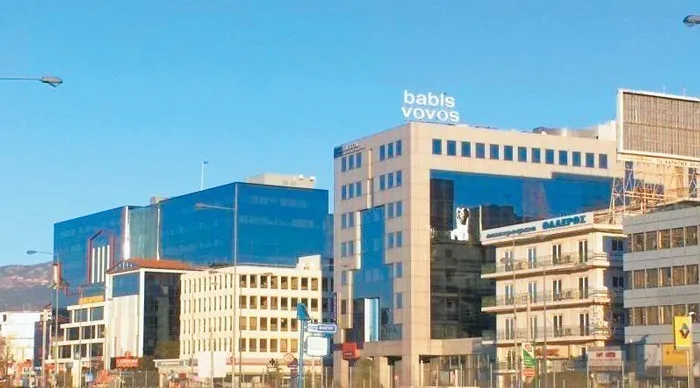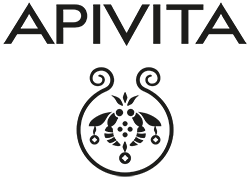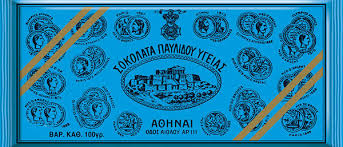|
|
Post by leandros nikon on Nov 13, 2007 20:14:33 GMT -5
Various mucisians.Tzimis Panousisen.wikipedia.org/wiki/PanousisTzimis Panousis is a Greek musician and stand-up comedian born in Athens on February 12, 1954, where he has spent most of his life. ------------------------------------------------------------------------------------------------------------------------------------------------- Nikolas AsimosA mucisian and cynical philosopher.en.wikipedia.org/wiki/Nikolas_AsimosNikolas Asimos (20 August 1949 – 17 March 1988) was a Greek composer and singer. His real last name was Asimopoulos. Asimos was a very special case of a counter-culture artist, mostly because of his choice of lifestyle. His behaviour and songs were often received as provocatory by the general public. He was a person with strong political opinions. Ideologically, he could be categorised as an anarchist but himself never accepted his categorisation into a specific political ideology. -------------------------------------------------------------------------------------------------------------------------------------------- Elli Paspalawww.last.fm/music/Elli+PaspalaElli Paspala was given birth in New York by Greek parents. She studied in the ’ Manhattan School of Music ‘, from which she took also the diploma ’ Bachelor of Arts ‘, while she took singing courses with the soprano Judith Ruskin and acting with the actor William Hickey. Then took part in concerts in the I.P.A and Canada, as well as in representations of opera, with last attitude the representation ’ Medea of ’ Gavin Bryars in the New York, in direction Bob Wilson... --------------------------------------------------------------------------------------------------------------------------------------------------- Manolis Kalomirisen.wikipedia.org/wiki/Manolis_KalomirisManolis Kalomiris (1883–1962), was a Greek classical composer. He was the founder of the Greek National School of Music.----------------------------------------------------------------------------------------------------------------------------------------------------
Marios Tokasen.wikipedia.org/wiki/Marios_TokasMarios Tokas (8 June 1954 – 27 April 2008) composer of traditional music born in Limassol, Cyprus. In the 1974 invasion, he fought as a soldier against the Turkish invadors. In 1975 he went to Athens in order to study in the philosophical school.[1] At the same time, he studied in the Ethniko Odio because he wanted to start a career as a musician. In 2004, Tokas and his six-member orchestra gave a concert in Vienna. The concert was co-organised by the Greek Society of Austria and the Athens Sports Association "Pantalkis" with the support of the General Secretariat of Hellenism Abroad of the Greek Foreign Ministry, under the auspices of the Cypriot ambassador to Austria.
|
|
|
|
Post by leandros nikon on Nov 13, 2007 21:14:02 GMT -5
TRADITIONAL MUSICen.wikipedia.org/wiki/Nikos_XilourisNikos Xilouris Nikos Xylouris nicknamed Psaronikos ("Grey Nick"), was a Greek composer and singer from the village of Anogeia in Crete and also the older brother of two other great musicians of Cretan music, Antonis Xylouris or Psarantonis and Yiannis Xylouris or Psaroyiannis. He was part of the movement against the Greek military Junta of 1967. His songs and music captured and described the Greek psyche and demeanor, gaining himself the title the archangel of Crete. He acquired his first lyra at the age of twelve and displayed potential to play local folk music. Xylouris was 17 years of age when he started performances at Kastro folk music-restaurant in Heraklion. A turning point in Nikos Xylouris' career occurred with a recording in 1958. He first performed outside Greece in 1966 and won the first prize in the San Remo folk music festival. In 1967 he established the first Cretan Music Hall, Erotokritos, in Heraklion. The recording of Anyfantou in 1969 was a big success. Xylouris soon started performances in Athens, which became his new permanent residence, at the Konaki folk music hall. During the early 1970s, Xylouris' voice becomes identified not only with Cretan music but also with the new kind of artistic popular music that emerged as well-known composers such as Giannis Markopoulos, Stavros Xarhakos, Christodoulos Halaris and Christos Leontis wrote music on the verses of famous Greek poets among which stand out Nikos Gatsos, Yannis Ritsos, Giorgos Seferis, Kostas Varnalis and Dionysios Solomos. In 1971, Xylouris is awarded by the Academy Charles Cross of France for his performance in the Cretan Rizitika songs album with G. Markopoulos.----------------------------------------------------------------------------------------------------------------------------------------- Psarantonis (Antonis Xilouris) en.wikipedia.org/wiki/Psarantonis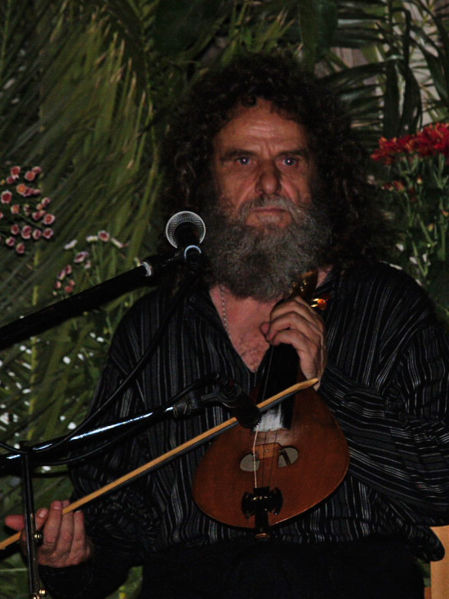 Antonis Xilouris (born 1939), nicknamed Psarantonis is a Greek composer, singer and performer of lyra, the bowed string instrument of Crete and most popular surviving form of the medieval Byzantine lyra. He come from the mountainous village of Anoghia in Crete and is the younger brother of the late Nikos Xylouris, a notable Cretan singer/musician as well as the older brother of Yiannis Xylouris, an equally notable Cretan musician. Antonis Xilouris (born 1939), nicknamed Psarantonis is a Greek composer, singer and performer of lyra, the bowed string instrument of Crete and most popular surviving form of the medieval Byzantine lyra. He come from the mountainous village of Anoghia in Crete and is the younger brother of the late Nikos Xylouris, a notable Cretan singer/musician as well as the older brother of Yiannis Xylouris, an equally notable Cretan musician. Psarantonis is known for the special timbre of his voice and his lyra playing style. Apart from the lyra Psarantonis plays various traditional instruments.[1][2] He first played the lyre at the age of 13 and recorded his first single in 1964, titled "I Thought of Denying You" (Greek: ÅóêÝöôçêá íá ó' áñíçèþ). He has released many recordings since then and has represented Greece many times in festivals abroad.[3][4] In January 2009, Psarantonis gave memorable performances in the rock music festival All tomorrow’s Parties hosted in Brisbane, Sydney and Mt Buller (in Victoria) and curated by Nick Cave & The Bad Seeds. --------------------------------------------------------------------------------------------------------------------------------------------- Chronis Aidonidis en.wikipedia.org/wiki/Chronis_AidonidisChronis Aidonidis is a prominent Greek Thracian singer of traditional music born on December 23, 1928 in a village near Didymoteicho, in western Thraki (north eastern Greece).He learned his first songs in his hometown and was introduced into the word of traditional music by his mother and the musicians who used to play at the local fairs. He was taught byzantine music first by his father and later by the professor Michalis Kefalokoptis. In 1950, he came to live in Athens with his parents, where he completed his studies in Byzantine music at the Hellenic Conservatory with the famous teacher Theodoros Hadjitheodorou. Till now, Chronis Aidonidis has released many records with the most beautiful songs of northern, eastern and western Thrace. He has participated in hundreds of musical events in Greece and abroad. An important step of his artistic journey was his especially successful collaboration with the well-known Greek singer George Dalaras for the release of the CD Nightingales from the Orient in March, 1990. The success would continue with one more release of the University of Crete, in 1993: the double CD Songs and tunes from Thrace. Another important moment of his career is his collaboration with his student Nektaria Karantzi for the release of the double CD, When the Roads Meet, where he recorded Byzantine Ecclesiastical Hymns for the first time and the CD He was Grieved, where he recorded with his student Karantzi 40 Byzantine hymns of the Holy Week and a folk lament. In 2001, he collaborated with Nikos Kypourgos for the release of a CD entitled Secrets from the Garden. During the Olympic Games of Athens in 2004, Chronis Aidonidis addressed a warm welcome to all the guests of Greece, in a unique way, singing affectionately the song Welcome my friends. In 2005, he participated in the Easter television show of the Helenic Television entitled "He was grieved", where he sung Byzantine hymns of the Holy Week and in 2006 he participated in the 6th Festival of Sacred Music in Patmos, with his student and Byzantine singer Karantzi and the ecclesiastical Byzantine choir, Glorifier. Nowadays he teaches traditional singing in Chalandri, at the Zisis Foundation and the Central Conservator in Athens. He is artistic director of the Center for the study of the Musical Tradition of Thrace, Asia Minor and Euxeinos Pontos and also the creator and inspirer of the Workshop for Traditional Music in Alexandroupoli. He is also one of the founders of the Archive of Greek Music. ------------------------------------------------------------------------------------------------------------------------------------------------ en.wikipedia.org/wiki/Areti_KetimeAreti Ketime Areti Ketime (b. July 26, 1989), is a singer and as a santouri player from Greece who performs a broad spectrum of Greek traditional music.Growing-up in a family originally from Pontus, Ketime was closely connected to the traditional music and was thus exposed to music from the age of 6. From 1999, she has participated in the Syme Festival. In 2002 she met noted musician George Dalaras and made a common appearance in several concerts. In 2003, she participated in a festival dedicated to Asia Minor along with Glykeria, Dalaras and Estudiantina of New Ionia. Dalaras produced her debute CD, To Tragoudi tis Aretis,Greek: ('Virtue's Song') with four tracks on the Parlophone label (MINOS/EMI). Ketime, accompanying herself on the santouri, performed at the opening ceremony for the 2004 Summer Olympics in Athens. Ketime turned professional in 2005, and began playing with her own group of musicians. She has appeared in many concerts themed on traditional Greek music, performing in a broad spectrum of both Greek traditional music (singing and playing), as well as classical.
|
|
|
|
Post by leandros nikon on Nov 13, 2007 21:40:30 GMT -5
7.Actors,directors,TV personas.en.wikipedia.org/wiki/Michael_CacoyannisMihalis Kakogiannis Mihalis Kakogiannis (born June 11, 1922) is a prominent Greek Cypriot filmmaker best-known for his 1964 film Zorba the Greek . (He also directed the 1983 Broadway revival of the musical based on the film.) Much of his work is rooted in classical texts, especially those of the Greek tragedian Euripides. Kakogiannis has been nominated for an Academy Award 5 times, a record for any Greek artist. He received Best Director, Best Adapted Screenplay and Best Film nominations for Zorba the Greek, and two nominations in the Foreign Language Film category for Electra and Iphigenia. From "Zorba the Greek" --------------------------------------------------------------------------------------------------------------------- -------------------- en.wikipedia.org/wiki/Theodoros_AngelopoulosTheo Angelopoulos Theodoros Angelopoulos is a Greek filmmaker, screenwriter and film producer.Angelopoulos studied law at the National and Kapodistrian University of Athens, but after his military service went to Paris to attend the Sorbonne. He soon dropped out to study film at the IDHEC (Institute of Advanced Cinematographic Studies) before returning to Greece. There, he worked as a journalist and film critic.Angelopoulos began making films after the 1967 coup that began the Greek military dictatorship known as the Regime of the Colonels. He made his first short film in 1968 and in the 1970s he began making a series of political feature films about modern Greece: Days of '36 (Meres Tou 36, 1972), The Travelling Players (O Thiassos, 1975) and The Hunters (I Kynighoi, 1977). He quickly established a characteristic style, marked by slow, episodic and ambiguous narrative structures as well as long takes (The Travelling Players, for example, consists of only 80 shots in about four hours of film). These takes often include meticulously choreographed and complicated scenes involving many actors. His regular collaborators include the cinematographer Giorgos Arvanitis, the screenwriter Tonino Guerra and the composer Eleni Karaindrou. Some of his filmsMegalexandros (1980) 1980. Golden Lion and International Film Critics Award (FIPRESCI), Venice Film Festival. Voyage to Cythera (1983) Best Screenplay and International Film Critics Award (FIPRESCI) Best Film Awards, 1984 Cannes Film Festival Critics' Award, Rio Film Festival. Landscape in the Mist (1988) 1988. Silver Lion Award for Best Director, Venice Film Festival. 1989. Felix (Best European Film of the Year) Award Golden Hugo Award for Best Director Silver Plaque for Best Cinematography, Chicago Film Festival. Ulysses' Gaze (1995) Grand Jury Prize and International Critics' Prize, 1995 Cannes Film Festival.[3] Felix of the Critics (Film of the Year 1995). Eternity and a Day (1998) Palme d'Or, 1998 Cannes Film Festival[4] Prize of the Ecumenical Jury --------------------------------------------------------------------------------------------------------------------- --------------------- en.wikipedia.org/wiki/Yannis_SmaragdisYannis Smaragdis Yannis Smaragdis is a Greek film director.He was born in Crete in 1946 and studied film in Greece and Paris, France. He appeared in 1972 with his short film Two Three Things... which received the first prize in the Athens Festival as well as a Special Mention in the Montreal Film Festival. Yannis Smaragdis has taught Mass Media courses at the Panteion University of Athens, as well as film direction and screenwriting at film schools in Greece. He has published 2 books: Poetic Geography (1995) and Cavafy (1997) - a literary form of the script of the film Cavafy. Yannis Smaragdis is an honorary member of the Directors Guild of America. Some of his films:1996 - Cavafy – Feature film about the life of the Greek poet Cavafy. State award for Best Feature film as well as three more state awards. Two international awards for the score of Vangelis in the film festivals of Ghent, Belgium and Valencia, Spain. An official participation in the film festivals of Berlin, Toronto, London, Jerusalem, San Francisco as well as 50 more international film festivals. It was released in cinema theatres in Paris 9 years ago where it is still screened. A box office record in Greece. The Greek nomination for the 1997 European Film Awards. 1997 - Opera of the Shadows – Opera, directed by Yannis Smaragdis. Performed at the Athens Opera House. 1998 - I've Brought to Art – Forty 5 minute segments of cultural content for the Greek Television ET1. 2001 - Ta Haidemena Paidia – TV series. Eighteen 32 minute episodes for the Greek Television ET1. Best Actor Award for Sotiris Moustakas. 2003 - Christian Monuments – Documentary on Christian Monuments of Greece, with the participation of Archbishop of Greece. Participation in the Film Festival of Amsterdam. 2004 - Spyros Louis – A tribute on the first Greek modern Olympic Winner, Marathon runner Spiridon Louis (50’). First International Award Guirlande d’Honneur 2004 in the Sports Movies Festival in Milan, Italy. 2007 - El Greco - An International co-production (Greece, Spain, England, Hungary, Italy) about the life of Greek painter, El Greco (Doménicos Theotokópoulos). It is the most expensive co-production in the history of Greek cinematography. Vangelis will compose the original soundtrack. Starring: new British actor Nick Ashdon, Greek actor Lakis Lazopoulos, Spanish actors Juan Diego Botto and Laia Marull and others. From "El Greco" movieFrom "Kavafis" movie------------------------------------------------------------------------------------------------------------------------------------------------ Katina Paxinou Born Aikaterini (Catherine) Konstantopoulou in Piraeus, Greece, she trained as an opera singer but changed career and joined the Greek Royal Theater in 1929. Paxinou distinguished herself on the stage. When World War II broke out, she was performing in London. Unable to return to Greece, she emigrated to the United States. She was selected to play "Pilár" in the 1943 film For Whom the Bell Tolls, winning an Oscar and a Golden Globe Award for Best Supporting Actress - Motion Picture. She continued appearing in Hollywood films until 1949. She made one British film as well, the 1947 film version of Uncle Silas, starring Jean Simmons. She played mother to Tyrone Power in Prince of Foxes in 1949. After 1949, Paxinou returned to Hollywood only once more, to play, again, a gypsy woman, this time in the 1959 Technicolor religious epic, The Miracle. In 1950, Paxinou resumed her stage career. In her native Greece, she formed the Royal Theatre of Athens with Alexis Minotis, her principal director and her husband Ioannis Paxinos, since 1940. Paxinou made several appearances on the Broadway stage and television as well, including the lead role in the first production in English of Federico Garcia Lorca's The House of Bernarda Alba, at the ANTA Playhouse in New York in 1951, and a BBC production of Lorca's Blood wedding (Bodas de sangre), broadcast on June 2, 1959. --------------------------------------------------------------------------------------------------------------------- -------------------- en.wikipedia.org/wiki/Filopimin_FinosPhilopemen Finos (Finos films)  " src=" ![]() Filopimin Finos was a Greek film producer of 186 films and the founder of Finos Film, whose first film was in 1939. He built the first sound recording device in Greece, and shot the first colour film with stereo sound. Finos died in January 1977 after a seven-year illness, leaving no heir. ----------------------------------------------------------------------------------------------------------------------------------------------- old.mfa.gr/english/greece/today/culture/theater/actors.htmlKarolos Koun Karolos Koun, along with Yiannis Tsarouchis and Dionysis Devaris established the Popular Stage, a theatrical workshop with the aim to exploit the popular Greek tradition. They staged such works as Erofili and Alcestes. In 1942 Karolos Koun founded the Art Theatre hosting outstanding plays, e.g.: The Glass Menagerie, Blood Wedding, A Streetcar Named Desire, The Death of a Salesperson, etc. Through the efforts of Koun, the Greek public had the opportunity to get acquainted with the American theatre, the works of Brecht, Ionesco, Becket, a.o. --------------------------------------------------------------------------------------------------------------------------------------------- Alexis Minotis old.mfa.gr/english/greece/today/culture/theater/actors.htmlA top-ranking actor and stage director of the Greek theatre. He first appeared on stage as chorus leader in Canea in 1921 and later as messenger in Sophocles’ Oedipus Tyrannus alongside with Veakis. From 1925 to 1939 he collaborated with Kotopouli. In 1960-1 he directed the operas “Norma” by Belini and “Medea” by Cerubini in Epidaurus, where the much celebrated soprano Maria Kallas also participated. He also staged Medea at Teatro alla Scala of Milan and in the Dallas Opera (Texas). Some of his landmark performances were: The Merchant of Venice, King Lear, Macbeth, Hamlet, and Ghosts (by Ibsen). He also directed ancient tragedies (Hecuba, Antigone, Prometheus Bound, Oedipus at Colonus). As stage director he remained faithful to the integrity of the messages of the play-writers. His performances in ancient drama were monumental and unique: bare in subterfuge and complexities but rich in oration. ----------------------------------------------------------------------------------------------------------------------------------------------- Manos Katrakis old.mfa.gr/english/greece/today/culture/theater/actors.htmlActor of the National Theatre. In 1955 he founded the Greek Popular Theatre where he staged works by Koromelas (The Lover of the Shepherdess), Kondylakis (adaptation of Patouchas), Theodorakis (A Song for the Dead Brother), etc. His most celebrated role was that of Prometheus in Prometheus Bound staged in Athens, Delphi and Epidaurus. ----------------------------------------------------------------------------------------------------------------------------------------------- Marika Kotopouli old.mfa.gr/english/greece/today/culture/theater/actors.htmlMarika Kotopouli(1888-1954).She met with unprecedented success in spite of the variety of performances she gave, ranging from tragedies to revues. She was entrusted with leading roles in the following plays, to mention just a few: “Electra”, “Oresteia”, “Electrae” by Hofmanstahl (tour to America) and “Hecuba” by Sophocles. In 1908 she founded her own group. M. Kotopouli appeared in leading roles in plays by such major modern Greek dramatists as Xenopoulos, Horn, Synodinos, a.o. In 1936 her group becomes government dependent and during the same year Kotopouli stages Shakespeare’s’ play “As You Like It”. During the Greek-Italian war Kotopouli produced patriotic Revues. ------------------------------------------------------------------------------------------------------------------------------------------------ www.answers.com/topic/titos-vandisTitos Vandis Born: 1916 Died: Feb 23, 2003 Occupation: Actor Active: '60s-'70s Major Genres: Comedy, Drama Career Highlights: Never on Sunday, A Perfect Couple, Prosohi Kindynos First Major Screen Credit: Never on Sunday (1960) Biography Earthy Greek-American character actor Titos Vandis was well represented by his short but meaty roles in two Jules Dassin films, Never on Sunday (1960) and Topkapi (1964). Vandis was a familiar Broadway presence, appearing in such scene-stealing parts as a reincarnation expert in Alan Jay Lerner's On a Clear Day You Can See Forever (1965). In American films, Vandis is best remembered for a brace of mid-1970s appearances. In Woody Allen's Everything You Always Wanted to Know About Sex (1972), Titos Vandis played the psychiatric patient with an unnatural attachment to his pet sheep.
|
|
|
|
Post by leandros nikon on Nov 13, 2007 21:43:44 GMT -5
7.2 DIASPORA/The old generationElia Kazanen.wikipedia.org/wiki/Elia_Kazan  Elia Kazan,(September 7, 1909 – September 28, 2003) was a Greek-American film and theatre director, film and theatrical producer, screenwriter, novelist and cofounder of the influential Actors Studio in New York in 1947. Elia Kazan,(September 7, 1909 – September 28, 2003) was a Greek-American film and theatre director, film and theatrical producer, screenwriter, novelist and cofounder of the influential Actors Studio in New York in 1947.
He was born in Constantinople.In 1999, Kazan received an honorary Oscar for lifetime achievement.The fact that he belonged to the communist party for a short period,had enraged America.America, America is a 1963 Elia Kazan film about a young Greek who leaves his small town in Anatolia in 1900 dreaming of a better life in America. It was directed and written by Kazan, from his own book, and stars Stathis Giallelis, Frank Wolff, Elena Karam and Lou Antonio.www.imdb.com/name/nm0001415/--------------------------------------------------------------------------------------------------------------------------- Aristotelis (Telly) Savalasaka Kojak www.tellysavalas.com/about/bio/beginnings.htmlen.wikipedia.org/wiki/Telly_SavalasAristotelis “Telly” Savalas (January 21, 1922 – January 22, 1994) was an American film and television actor and singer, whose career spanned four decades. Best known for playing the title role in the 1970s crime drama Kojak, Savalas was nominated for an Academy Award for Best Supporting Actor for his performance in Birdman of Alcatraz (1962). His other movie credits include The Young Savages (1961), The Greatest Story Ever Told (1965), Battle of the Bulge (1965), The Dirty Dozen (1967), The Scalphunters (1968), supervillain Ernst Stavro Blofeld in the James Bond film On Her Majesty's Secret Service (1969), Kelly's Heroes (1970), Pretty Maids All in a Row (1971), Inside Out (1975) and Escape to Athena (1979). He was easily recognizable with his shaved head and strong, masculine features.www.imdb.com/title/tt0069599/ www.tellysavalas.com/about/bio/beginnings.htmlen.wikipedia.org/wiki/Telly_SavalasAristotelis “Telly” Savalas (January 21, 1922 – January 22, 1994) was an American film and television actor and singer, whose career spanned four decades. Best known for playing the title role in the 1970s crime drama Kojak, Savalas was nominated for an Academy Award for Best Supporting Actor for his performance in Birdman of Alcatraz (1962). His other movie credits include The Young Savages (1961), The Greatest Story Ever Told (1965), Battle of the Bulge (1965), The Dirty Dozen (1967), The Scalphunters (1968), supervillain Ernst Stavro Blofeld in the James Bond film On Her Majesty's Secret Service (1969), Kelly's Heroes (1970), Pretty Maids All in a Row (1971), Inside Out (1975) and Escape to Athena (1979). He was easily recognizable with his shaved head and strong, masculine features.www.imdb.com/title/tt0069599/-------------------------------------------------------------------------------------------------------------------------------
Spyros Skouras
movies2.nytimes.com/gst/movies/filmography.html?p_id=188017&mod=bio In the summer of 1954, Spyros Skouras, then president of 20th Century Fox, paid a nostalgic visit to his birthplace, the famed town of Sparta, in the south of Greece. Skouras had left Greece as a poor, illiterate boy in his early teens, but through hard work and enterprise had become a hot shot in Hollywood—without, as one wag said at the time, even pretending to be Jewish. en.wikipedia.org/wiki/Spyros_Skouras The Skouras Brothers Co. of St. Louis dream of building a world-class movie palace in downtown St. Louis was grandly realized in 1926 when the $5.5 million Ambassador Theatre Building opened. This theatre opened in 1939 as the New Fox Theatre. They incorporated with $400,000 capital stock with more than thirty local theaters belonged to the Skouras empire by 1924. Five years later, the triumvirate sold out to Warner Brothers and moved east to claim top executive places in the industry. In 1932, the Skouras Brothers (Spyros, George and Charles) took over the management of over 500 Fox-West Coast theaters. Spyros helped merge Fox with 20th Century films in the 1930's and he served as president from 1942 to 1962. During Spyros' tenure there he worked to rescue the faltering movie industry from television's lure. 20th Century Fox's famous advertising slogan, Movies are Better than Ever, gained credibility in 1953 when Spyros introduced Cinemascope in the studio's groundbreaking feature film "The Robe". With the introduced of Cinemascope, Spyros did much to save the movie industry from its newly invented competitor -- television. -------------------------------------------------------------------------------------------------------------------------------
Kostas Gavras

movies.yahoo.com/movie/contributor/1800035225/bioConstantin (Costa) Gavras made his reputation as the preeminent director developing the political thriller from the late 1960s through the 80s. Several of his films ("State of Siege" 1973, "Missing" 1982) are archetypes of the genre and "Z" (1969) is a crucial fictional account of political repression in the 20th century.In 1982, Costa-Gavras took over the directorship of the Cinematheque Francaise, then badly in disarray. During his tenure, he proved a tireless champion of both film preservation and artistic freedom, furthering the institution's international renown even as he continued to work on his own films. Costa-Gavras demonstrated his continuing social conscience in 1992 by contributing (as one of 30 French filmmakers) his plea on behalf of people suffering human rights violations in the documentary "Lest We Forget". "The Minor Apocalypse" (1993), a French film about a writer who gets an offer to be published only if he commits suicide on TV, served as a dry run for the American release of "Mad City" (1997), a supposedly scathing look at the electronic media's ability to manipulate (and manufacture) breaking news, which elicited yawns and indifference before quickly departing theaters. Fans of Costa-Gavras can only hope for a return of the storytelling prowess that brought them "Z", "State of Siege" and "Missing". Milestones1959 First feature as assistant director, Yves Allegret s L ambitieuse 1965 Feature directing debut, The Sleeping Car Murders 1969 Received two Oscar nominations (Best Director and Best Adapted Screenplay) for Z 1973 Made commericals for TV-Hachette 1977 Film acting debut in La vie devant soi/Madame Rosa 1982 First US-produced film, Missing ; won Academy Award for Best Adapted Screenplay (shared with Donald Stewart) 1982 Took over directorship of Cinematheque Francais 1985 Acted in John Landis Spies Like Us , portraying a Tadzhic Highway Patrolman 1988 First collaboration with screenwriter Joe Eszterhas, Betrayed 1989 Reteamed with Eszterhas for Music Box 1992 One of 30 French filmmakers who delivered their short pleas on behalf of people who had suffered human rights violations in the documentary Lest We Forget 1997 Mad City disappeared quickly from theaters 2002 Engendered controversy in Europe with Amen. , a drama about two men, real-life German soldier Kurt Gerstein and a fictionalized priest, who attempt to warn the world about the Nazis plan to exterminate Jews during WWII www.imdb.com/name/nm0002020/-------------------------------------------------------------------------------------------------------------------------- John Cassavetes en.wikipedia.org/wiki/John_Cassavetes en.wikipedia.org/wiki/John_CassavetesJohn Nicholas Cassavetes (December 9, 1929 – February 3, 1989) was an American actor, screenwriter and filmmaker. He appeared in many Hollywood films. He is most notable as an influential pioneer of independent film. He used handheld cameras and cinema-vérité style techniques in his films, but they were based on actors and screenplays and were fiction.His son,Nicholas Cassavetes (born May 21, 1959) became a succesful film actor, screenwriter, and filmmaker. Filmography(As director) Shadows (1959) Too Late Blues (1961) A Child is Waiting (1963) Faces (1968) Husbands (1970) Minnie and Moskowitz (1971) A Woman Under the Influence (1974) The Killing of a Chinese Bookie (1976) Opening Night (1977) Gloria (1980) Love Streams (1984) Big Trouble (1986) www.imdb.com/name/nm0001023/--------------------------------------------------------------------------------------------------------------------- -------  Olympia Dukakis Olympia Dukakis
Olympia Dukakis (born June 20, 1931 in Lowell, Massachusetts) is an Academy Award-winning American actress. The daughter of Greek immigrants to the United States, she was educated at Boston University. Olympia Dukakis has starred in many American movies, including Steel Magnolias, Mr. Holland's Opus, The Thing About My Folks, and Moonstruck (for which she won an Oscar for Best Supporting Actress). Her theater, film, and television work has also led her to win Obie awards, a Los Angeles Critics Award, and a Golden Globe award. She also played the role of Anna Madrigal in the television Tales of the City productions. Much of Dukakis' talent comes in sharp comic timing, which she has put to good use as sarcastic but wise motherly figures to the lead characters such as Moonstruck and Mr. Holland's Opus. She will next be seen in the upcoming In the Land of Women. She is a cousin to Michael Dukakis, the former Greek american governor of Massachusetts,who was the 1988 democratic candidate for U.S. presidency. www.imdb.com/name/nm0001156/--------------------------------------------------------------------------------------------------------------------- ------- Antony QuinnA Mexican actor with a Greek heart.He impersonated the role of Greek men several times : "Zorba the Greek","the Greek tycoon","Onasis","the guns of Navarone" etc...en.wikipedia.org/wiki/Anthony_QuinnAnthony Quinn (April 21, 1915 – June 3, 2001) was a Mexican-American actor, as well as a painter and writer. He starred in numerous critically acclaimed and commercially successful films, including Zorba the Greek, Lawrence of Arabia, and Federico Fellini's La strada. He won the Academy Award for Best Supporting Actor twice; for Viva Zapata! in 1952 and Lust for Life in 1956.
------------------------------------------------------------------------------------------------------------------------------- 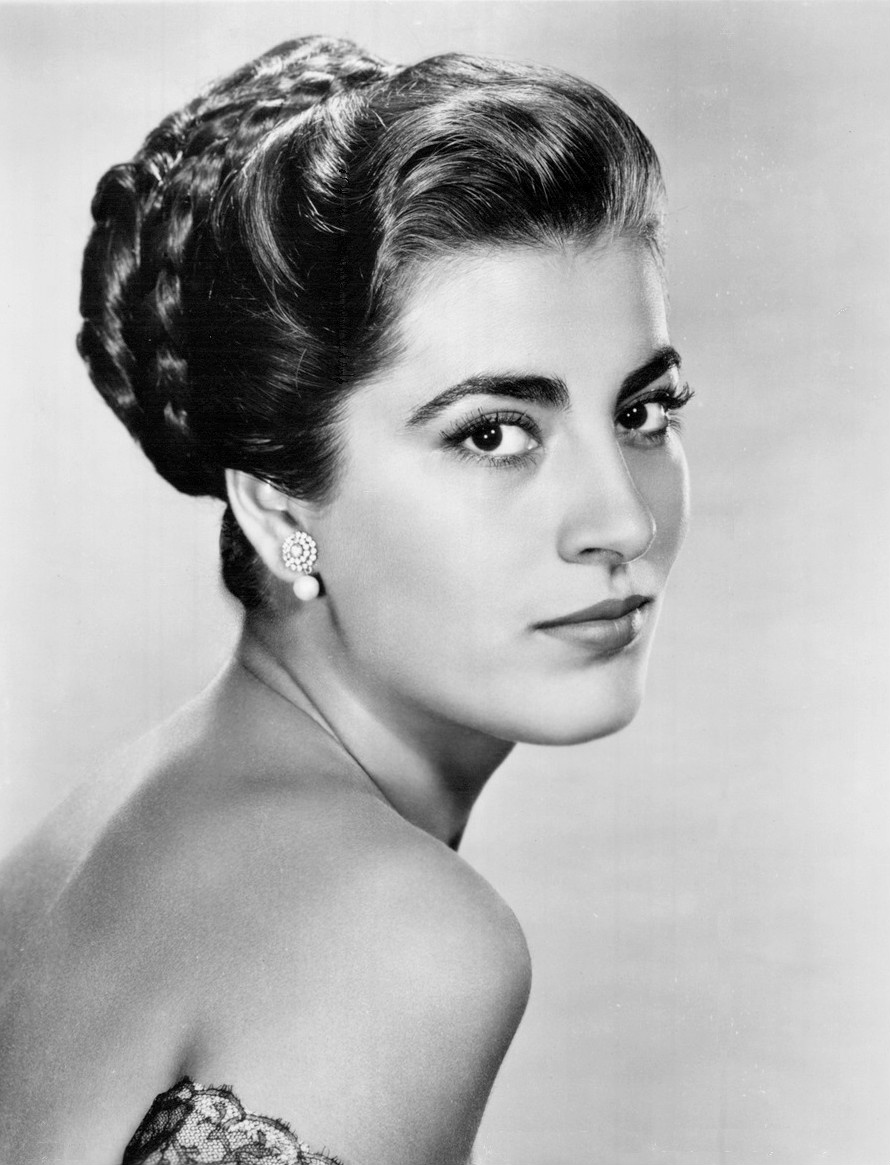
Irene PapasIrene Papas(born September 3, 1926) is a Greek-born actress who has starred in over seventy films in a career spanning more than fifty years. Irene Papas was born Irene Lelekou (ÅéñÞíç ËåëÝêïõ) in Chiliomodi outside Corinth, Greece. She began her early career in Greece, achieving widespread fame there, before starring in internationally renowned films such as The Guns of Navarone and Zorba the Greek, and critically acclaimed films such as Z and Elektra. She has recently appeared in the film, Captain Corelli's Mandolin, and is currently working in theatre in Portugal. She was discovered by Elia Kazan. Federico Fellini was a huge admirerer of her work. She was a close friend of Katharine Hepburn, with whom she co-starred in The Trojan Women. Hepburn once said that Papas was "one of the best actresses in the history of cinema". www.imdb.com/name/nm0660327/----------------------------------------------------------------------------------------------------------------------------- Andreas Katsulas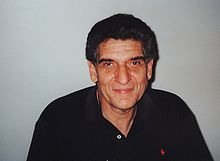 en.wikipedia.org/wiki/Katsulas en.wikipedia.org/wiki/KatsulasAndrew "Andreas" Katsulas (May 18, 1946 – February 13, 2006) was a Greek-American actor known for his roles as Ambassador G'Kar in the science fiction television series Babylon 5, as the one-armed villain Sykes in the film The Fugitive (1993), and as the Romulan Commander Tomalak on Star Trek: The Next Generation. He also played Vissian Captain Drennik in the Star Trek: Enterprise episode "Cogenitor". www.imdb.com/name/nm0441537/bio-------------------------------------------------------------------------------------------------------------------------------
Michael ConstantineMichael Constantine (Born 22 May 1927) is an American actor. The son of immigrants from Greece, for many years he was best known for his portrayal of principal Seymour Kaufman in the series Room 222 (1969-1974). He also played Santa in the 1989 film Prancer. In 2002, he enjoyed an unexpected comeback as the Windex-toting Gus Portokalos in the surprise hit movie My Big Fat Greek Wedding, a role he reprised in the short-lived television series My Big Fat Greek Life.www.imdb.com/find?s=all&q=Michael+Constantine
|
|
|
|
Post by leandros nikon on Nov 13, 2007 21:52:27 GMT -5
7.3 DIASPORA/ The new generationen.wikipedia.org/wiki/Jennifer_AnistonJennifer Aniston  Jennifer Joanna Aniston (born February 11, 1969) is an American actress. She became famous in the 1990s for her role as Rachel Green in the US sitcom Friends, a role for which she won an Emmy Award, a Golden Globe Award, and a Screen Actors Guild Award. Jennifer Joanna Aniston (born February 11, 1969) is an American actress. She became famous in the 1990s for her role as Rachel Green in the US sitcom Friends, a role for which she won an Emmy Award, a Golden Globe Award, and a Screen Actors Guild Award.She has starred in many Hollywood films. While most of her film roles have been in comedies such as Bruce Almighty, Office Space, Rumor Has It, and the romantic comedies Along Came Polly and The Break-Up, she has also appeared in films from other genres, such as the comedy-horror Leprechaun, the crime thriller Derailed and the musical drama movie, Rock Star. Aniston's father is a Greek American, born Yannis Anastassakis on the island of Crete, Greece, while her mother is of Italian-Scottish descent and was born in New York City.Aniston's godfather was the actor Telly Savalas,her father's best friend.She lived in Greece for one year as a child with her family. www.imdb.com/name/nm0000098/---------------------------------------------------------------------------------------------------------------------------------------------- en.wikipedia.org/wiki/Billy_ZaneBilly Zane 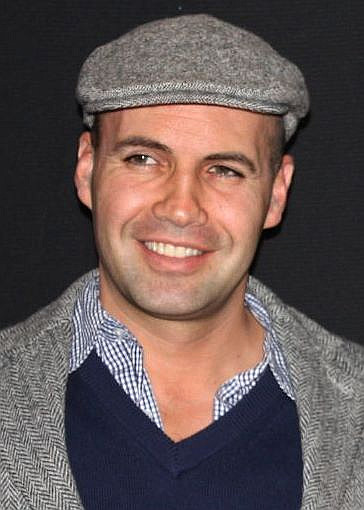 William George "Billy" Zane, Jr. (born February 24, 1966) is an American actor, producer and director. He is probably best known for his roles as Caledon "Cal" Hockley in Titanic, The Phantom from The Phantom , John Wheeler in Twin Peaks and Mr. E in CQ. www.imdb.com/name/nm0000708/---------------------------------------------------------------------------------------------------------------------------------------------- en.wikipedia.org/wiki/Melina_KanakaredesMelina Kanakaredes From Wikipedia, the free encyclopedia  Melina Eleni Kanakaredes Constantinides (born April 23, 1967) is a Daytime Emmy Award-nominated American actress. She is widely known for two starring roles on U.S. prime-time television drama series; playing Detective Stella Bonasera in CSI: NY and portraying Dr. Sydney Hansen in Providence. www.imdb.com/name/nm0005074/------------------------------------------------------------------------------------------------------------------------------------------------- en.wikipedia.org/wiki/Elias_KoteasElias Koteas  Elias Koteas (born March 11, 1961) is a Canadian actor of film and television, best known for his roles in The Prophecy,Thin red line,Fallen, and the live-action Teenage Mutant Ninja Turtles movies. Elias Koteas (born March 11, 1961) is a Canadian actor of film and television, best known for his roles in The Prophecy,Thin red line,Fallen, and the live-action Teenage Mutant Ninja Turtles movies.Koteas was born in Montreal, Quebec, Canada, to a father who worked as a mechanic for the Canadian National Railways and a milliner mother.His parents are both of Greek descent,and he is a fluent Greek speaker. www.imdb.com/name/nm0000480/------------------------------------------------------------------------------------------------------------------------------------------ en.wikipedia.org/wiki/Nia_VardalosNia Vardalos  Antonia Eugenia "Nia" Vardalos (born September 24, 1962) is a Canadian-American actress, screenwriter, director, and producer. Her most notable work is the 2002 Academy Award nominated film My Big Fat Greek Wedding. www.imdb.com/name/nm0889522/---------------------------------------------------------------------------------------------------------------------------------------------- en.wikipedia.org/wiki/Louis_MandylorLouis Mandylor  Louis Mandylor (born September 13, 1966) is an Australian film and television actor.Mandylor was born Louis Theodosopoulos in Melbourne, Victoria, Australia, the son of Greek immigrants Louise (née Mandylaris) and Yannis Theodosopoulos, a taxi driver.He is the brother of fellow actor Costas Mandylor.Mandylor has enjoyed success in U.S. television shows, such as a prominent guest appearance on Relic Hunter with Tia Carrere. Louis is probably most famous for his role in the movie My Big Fat Greek Wedding. Other major roles include playing Louis Malone in Martial Law alongside Sammo Hung. www.imdb.com/name/nm0541909/----------------------------------------------------------------------------------------------------------------------------------------------- en.wikipedia.org/wiki/Costas_MandylorCostas Mandylor  Costas Mandylor (born Costas Theodosopoulos; September 3, 1965) is an Greek Australian actor.He is the brother of the actor Louis Mandylor. He is known for his role as Kenny in Picket Fences, and for portraying Mark Hoffman in the Saw series.Mandylor's first big role was in the 1989 film Triumph of the Spirit playing a European Jew, which was filmed at the Auschwitz-Birkenau death camp. He returned to Los Angeles meeting director Oliver Stone and auditioned and got the role of an Italian count in The Doors (1991).Mandylor landed a leading role in Mobsters playing a New York gangster, Frank Costello. www.imdb.com/name/nm0541908/----------------------------------------------------------------------------------------------------------------------------------------------- en.wikipedia.org/wiki/Nikos_AliagasNikos Aliagas 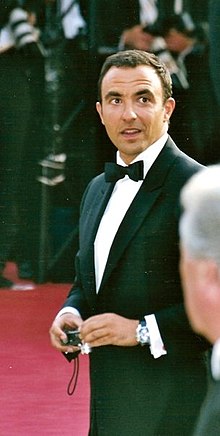 Nikos Aliagas (born 13 May 1969 in Paris) is a Greek-French host of the popular French music reality program named Star Academy.His origin is from the prefecture of Aitoloacarnania in western Greece.He speaks five languages (as of 2003) including English. He lived between France and Greece during childhood. www.imdb.com/name/nm1080611/------------------------------------------------------------------------------------------------------------------------------------------------ en.wikipedia.org/wiki/John_StamosJohn Stamos 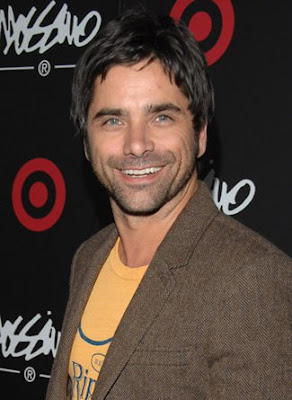 John Phillip Stamos (born August 19, 1963) is an American actor best known for his work in television, especially in his starring role as Jesse Katsopolis on the ABC sitcom Full House. Since the cancellation of that show in 1995, Stamos has appeared in numerous television films and series. From 2006 to 2009, Stamos had a starring role on the NBC medical drama ER as Dr. Tony Gates. In September 2009, he began playing the role of Albert in the Broadway revival of Bye Bye Birdie. In September 2010 Stamos began a multi-episode arc as Dr. Carl Howell on the second season of the hit Fox series Glee.Stamos was born in Cypress, California, the oldest child and only son of Loretta (née Phillips), a former swimsuit model from England who was of Irish descent, and Bill Stamos, a Greek immigrant.His family's last name was originally Stamatopoulos but his grandparents shortened the name to Stamos after they moved to the United States from Greece. www.imdb.com/name/nm0001764/bio--------------------------------------------------------------------------------------------------------------------- ---------------------- Alexander Payne (Papadopoulos) en.wikipedia.org/wiki/Alexander_PayneConstantine Alexander Payne (born February 10, 1961) is an American Academy Award-winning film director and screenwriter.Payne, a Greek American (his grandfather's family name was Anglicized from Papadopoulos), was born in Omaha, Nebraska to parents who were restaurant owners. His films are noted for their dark humour and satirical depictions of contemporary American society. His films also revolve around adultery in marriage and relationships. He also tends to set his films in Omaha. He has scenes of historical landmarks and museums in his films, and tends to use actual people for minor roles (real cops play cops, real teachers play teachers, etc.). He frequently incorporates telephone monologues as a dramatic device. He also tends to cast actor Phil Reeves in his films. He is on the short list of directors who have final cut rights for their films. In 2005 he became a member of the Board of Governors of the Academy of Motion Picture Arts and Sciences (Directors Branch). His writing partner is Jim Taylor. www.imdb.com/name/nm0668247/----------------------------------------------------------------------------------------------------------------------------------------------- Strangis Family Greg Strangis (I) Filmography/Bio Greg Stangis Greg Strangis www.caucus.org/members/members_spotlight_strangis.htmlSam Strangis Father of Greg Strangis www.imdb.com/name/nm0833407/www.hollywood.com/celebs/detail/id/1125144Producer - filmography (2000s) (1990s) (1980s) (1970s) "CSI: Miami" (2002) TV Series (co-executive producer) "CSI: Crime Scene Investigation" (co-executive producer) ... aka C.S.I. (USA: short title) ---------------------------------------------------------------------------------------------------------------------------------------------- en.wikipedia.org/wiki/Marina_SirtisMarina Sirtis  Marina Sirtis (born March 29, 1955 is a Greek-British-American actress who is most noted for playing the Human/Betazoid Counselor Deanna Troi on the television and film series Star Trek: The Next Generation. www.imdb.com/name/nm0000642/------------------------------------------------------------------------------------------------------------------------------------------- (thank you Patrinos) en.wikipedia.org/wiki/Amy_SedarisAmy Sedaris 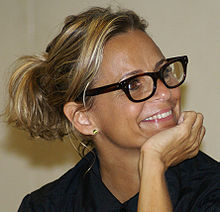 Amy Sedaris (born March 29, 1961) Amy Sedaris (born March 29, 1961) is an American actress, author and comedienne. She is perhaps best known for playing the character Jerri Blank in the Comedy Central television series Strangers with Candy. Sedaris regularly collaborates with her older brother, humorist and author David Sedaris. She is recognized as a frequent guest on The Late Show with David Letterman. Amy Sedaris was born in Endicott, New York, daughter of Sharon and Lou Sedaris,[1][2] and grew up in Raleigh, North Carolina. She is of half Greek descent;[3] her father was Greek Orthodox and her mother was Protestant, and she remains Greek Orthodox. www.imdb.com/name/nm0781238/---------------------------------------------------------------------------------------------------------------------------------------------- en.wikipedia.org/wiki/Patrick_TatopoulosPatrick Tatopoulos Patrick Tatopoulos is a renowned French-Greek production designer, who lives and works in the United States. He is considered by many as a visionary,creating innovative, exciting concepts for filmed and computer generated environments. His unique designs, rich with mood, character and distinction, have appeared in numerous box office hit motion pictures, including such movies as Underworld, I, Robot, The Chronicles of Riddick, Independence Day, Bram Stoker's Dracula, Stargate, Godzilla, Stuart Little, I Am Legend, and Live Free or Die Hard.www.imdb.com/name/nm0851281/------------------------------------------------------------------------------------------------------------------------------------------------- en.wikipedia.org/wiki/Angelo_TsarouchasAngelo Tsarouchas Evangelos Petros Tsarouchas (Born: Montreal, Quebec, Canada) is an internationally known stand-up comic. Angelo Tsarouchas has been wowing audiences all over the world. Angelo has an instant likeability and an "every man" personality which combines a comfortable yet magnetic presence. Recently, he was showcased at the UK Paramount Comedy Festival, South African Comedy Festival and Montreal's Just for Laughs. After bringing down the house in Montreal, The Hollywood Reporter had this to say: “ ... Greek-Canadian Angelo Tsarouchas , fresh from a stint as a reporter in "Cinderella Man," opportunity to open for Rosanne Barr. Angelo’s diverse talent has also landed him on the big screen with appearance in "The Score", "John Q", "The Recruit", "The Prince and Me", “"Harold and Kumar Go to White Castle"” and "Cinderella Man". Angelo’s material appeals to an incredibly wide range of audiences. He wrote and performed his one-man show "It's All Greek to Me" which has received rave reviews. The same titled comedy CD has also reached number one in Australia , keeping him in demand year round. Angelo has toured the world and has also been a Special Guest on the Russell Peters tour in Australia, New Zealand and Dubai. Angelo will be performing at a gala hosted by Rusell Peters honoring Al Gore April 5th 2008 in Montreal Quebec. --------------------------------------------------------------------------------------------------------------------------------------------- Milton Katselas en.wikipedia.org/wiki/Milton_KatselasMilton Katselas (December 22, 1933—October 24, 2008) was an American film director and famous Hollywood coach for The Beverly Hills Playhouse. He taught such stars as Gene Hackman, Jason Beghe, Jenna Elfman, George Clooney, Alec Baldwin, Giovanni Ribisi, Tom Selleck, Michelle Pfeiffer, Ted Danson, Tony Danza, Jeffrey Tambor, Gene Reynolds, Tyne Daly, Mel Harris, Catherine Bell, Sofia Milos, Elizabeth Sung and others. After high school, he set off for Pittsburgh's Carnegie Tech (now Carnegie Mellon) to study theater. On a visit to New York, he sneaked in to watch Lee Strasberg's acting class where he also saw renowned director Elia Kazan on the street and chased him down. "I talked to him in Greek, and he talked with me"... He told me, `When you finish college, come see me.'", Katselas recalled.Following graduation in 1954, he began studying with Strasberg and serving as an apprentice to Kazan..... www.imdb.com/name/nm0441501/----------------------------------------------------------------------------------------------------------------------------------------------- en.wikipedia.org/wiki/Nadia_TassNadia Tass (Íantia Tasopoulou) Nadia Tass (born 1956) is a film director and producer, originally from Macedonia, northern Greece, who moved to Australia in the 1960s. She has also directed plays in Australia including Miss Bosnia, Cosi and Summer of the Aliens. Feature films as directorMalcolm (1986) Rikky and Pete (1988) The Big Steal (1990) Pure Luck (1991) Mr. Reliable (1996) Amy (1998) www.cascadefilms.com.au/html/nadia_tass.htmNadia Tass (Director / Producer) Nadia Tass is one of Australia's most respected and unique filmmakers. Tass' study of acting and directing in Australia and New York, has given her performance as a director a fine and unique style. www.imdb.com/name/nm0850958/---------------------------------------------------------------------------------------------------------------------------------------------- Dean Tavoularis en.wikipedia.org/wiki/Dean_TavoularisDean Tavoularis (born January 1, 1932) is an American motion picture production designer whose work appeared in numerous box office hits such as The Godfather movies, Apocalypse Now, The Brink's Job, One from the Heart and Bonnie and Clyde.He was born in Lowell, Massachusetts, to Greek immigrant parents. www.imdb.com/name/nm0851790/------------------------------------------------------------------------------------------------------------------------------------------------ en.wikipedia.org/wiki/Zach_GalifianakisZach Galifianakis  Zacharius Knight "Zach" Galifianakis(born October 1, 1969)És a Greek American comedian and actor, known for numerous film and television appearances including his own Comedy Central Presents special. He is known for his unconventional stand-up style, that features the reading of one-liners while playing a piano during his performances. While initially more of an "underground" and lesser-known comedian, he garnered considerable mainstream attention with his breakthrough role in the successful 2009 comedy The Hangover, as his character of Alan. www.imdb.com/name/nm0302108/-------------------------------------------------------------------------------------------------------------------------------------------- George (Miliotis) Miller en.wikipedia.org/wiki/George_Miller_(producer)Dr George (Miliotis) Miller (born March 3, 1945) is an Academy-Award winning Australian film and television screenwriter, director and producer. He is probably most well known for his work on the Mad Max movies, but has been involved in a wide range of projects, including the Oscar-winning Happy Feet. George Miliotis was born in Chinchilla, Queensland, to Greek immigrant parents: Dimitri (Jim) Castrisios Miliotis, from Kythera, and Evangelia (Angela) Balloyoulo. The Balloyoulo family were Greek refugees from Asia Minor, while Dimitri was from the Greek island of Kythera and he anglicised his surname to Miller when he emigrated to Australia.[1] The couple married and settled in Chinchilla and had four sons. The first two, non-identical twins were George and John, and later, Chris and Bill (Vassilli). George served as an altar boy at the Greek Orthodox Church of Saint George, Rose Bay, New South Wales. He attended Sydney Boys High School, then studied medicine at the University of New South Wales with his twin brother John. While in his final year at med school (1971), George and his younger brother Chris made a one minute short film, that won them first prize in a student competition.[2] In 1971, George attended a Film Workshop at Melbourne University where he met fellow student, Byron Kennedy. In 1972, Miller completed his residency at Sydney's St Vincent's Hospital, spending his time-off crewing on short experimental films. Miller formed an irrepressible bond with fellow film fanatic Byron Kennedy. The pair collaborated on numerous works after that. Miller wrote and directed the Mad Max movies starring Mel Gibson (Mad Max, The Road Warrior, and Mad Max Beyond Thunderdome); co-wrote Babe and wrote and directed its sequel; and co-wrote (with Nick Enright) and directed Lorenzo's Oil. He also directed The Witches of Eastwick, starring Jack Nicholson, Susan Sarandon, Cher and Michelle Pfeiffer. With Phillip Noyce, Miller co-produced and co-directed two acclaimed miniseries for Australian television: The Dismissal (1983) and The Cowra Breakout (1984). www.imdb.com/name/nm0004306/-------------------------------------------------------------------------------------------------------------------------------------------- (Thank you Eva) en.wikipedia.org/wiki/Alex_ProyasAlex Proyas Proyas was born to Greek parents in Egypt and moved to Sydney, Australia when he was 3 years of age.[1] At seventeen he went to film school and began directing music videos.[1] He moved to Los Angeles in the United States to further his career, working on MTV music videos and commercials.[1] CareerProyas' first feature film was the independent science fiction thriller Spirits of the Air, Gremlins of the Clouds. This was nominated for two Australian Film Institute awards in 1988, for costume design and production design.[2] Next, Proyas directed the 1994 fantasy thriller The Crow starring Brandon Lee. Lee was killed in an accident during filming, only eight days before the completion of the film in March 1993. After Lee's death, Proyas and his producers decided to complete the film, partially rewriting the script, and using a stunt double and special effects to film the remaining scenes.[3] The Crow was released in May 1994 and was a box office and critical success.[4] Proyas then wrote and directed and produced the 1998 science fiction thriller Dark City, which had disappointing box office results despite winning several awards,[5] but has since gained a strong cult following.[citation needed] In 2004, he directed I, Robot, a science fiction film suggested by[6] the Isaac Asimov short story compilation I, Robot that starred Will Smith. It was a box office success, but met with mixed reactions by readers and fans of the Asimov stories.[citation needed] Proyas' next film will be thriller Knowing starring Nicolas Cage. It is due to begin production in Melbourne in March 2008.[7] AwardsAt the 1994 Cannes Film Festival, Proyas was nominated for a Golden Palm award for his short film, Book of Dreams: 'Welcome to Crateland'. For Dark City, he was nominated for several awards and won the Silver Scream Award at the Amsterdam Fantastic Film Festival, the Bram Stoker Award, the Film Critics Circle of Australia Award and the Pegasus Audience Award at the Brussels International Festival of Fantasy Film. FilmographyShort Films Neon (1980) Groping (1980) Strange Residues (1981) Spineless (1987) Book of Dreams: Welcome to Crateland (1994, short) Feature FilmsSpirits of the Air, Gremlins of the Clouds (1989) The Crow (1994) Dark City (1998) Garage Days (2002) I, Robot (2004) Knowing (2009) Music Videos"Don't Dream It's Over" - Crowded House (1987) Songlines (1989) The Best of Sting: Fields of Gold 1984-1994 (1994) I'm Only Looking: The Best of INXS (2004) www.imdb.com/name/nm0001639/--------------------------------------------------------------------------------------------------------------------------------------------- en.wikipedia.org/wiki/Nick_GiannopoulosNick Giannopoulos Nick Giannopoulos (July 1, 1963 in Melbourne, Australia) is a Greek-Australian stand-up comedian, film and TV actor. He is best known for his comedy stage show Wogs Out of Work alongside George Kapiniaris and the television sitcom Acropolis Now and is an exponent of wog comedy www.imdb.com/name/nm0316318/---------------------------------------------------------------------------------------------------------------------------------------------- en.wikipedia.org/wiki/Alexandra_PascalidouAlexandra Pascalidou Alexandra Pascalidou (born July 17, 1970 in Bucharest, Romania by Greek parents) is a Swedish journalist, television hostess and author. She is also a frequent lecturer, discussion leader and human rights activist. In 2004 Alexandra hosted the Olympics in Athens for SVT and thereafter she lived in Greece for two years where she hosted various TV-shows. Alexandra was also hosting Greek morning television every day with three hours of live coverage each episode. She also was hostess for the Eurovision Song Contest in Greece in 2005, and commentator in Kiev the year when Greece won the competition for the first time. In the same year Alexandra hosted Melodifestivalen in Sweden from Gothenburg. Alexandra is a and freelance writer in newspapers such as GP, Metro and Expressen. She blogs continually on Metrobloggen and she gives lectures on diversity and the media, democracy and justice issues, rhetoric and leadership, gender and cultural competence. Alexandra has also served on the Board of BRIS (Children's right in society) and the board of kvinnojouren Terrafem working with women’s rights against men’s violence. She is involved in women's health and is a member of the 2.6 miljoner klubben and she is a mom's ambassador to RFSUs campaign. Alexandra sits on the board of the foundation Läxhjälpen which helps young people in troubled areas with their homework to help them get access to secondary education. Alexandras work against racism and for human rights has led to that she over the years has been exposed to hundreds of death threats. But she continues her lectures on human rights and operates a number of charity projects for children in Sweden's suburbs. Alexandra herself has said that "I have had all the obstacles you may have to be successful- wog, woman, child of divorce, from a suburban neglected working class".
|
|
|
|
Post by leandros nikon on Nov 13, 2007 22:43:54 GMT -5
7.4en.wikipedia.org/wiki/Melina_Mercouri Melina MercouriMelina Mercouri,born Maria Amalia Mercouri (October 18, 1920 – March 6, 1994), was a Greek actress, singer and politician. She is considered one of the greatest female figures of modern era in Greece, being an actress of international fame and a politician who left her mark on Greek culture. Melina MercouriMelina Mercouri,born Maria Amalia Mercouri (October 18, 1920 – March 6, 1994), was a Greek actress, singer and politician. She is considered one of the greatest female figures of modern era in Greece, being an actress of international fame and a politician who left her mark on Greek culture.As an actress she made her film debut in Stella (1955) and met international success with her performances in films such as Never on Sunday, Phaedra, Topkapi and Promise at Dawn. She won the award for Best Actress at the 1960 Cannes Film Festival, and apart from her Academy Awards nomination, she was also nominated for three Golden Globe Awards and two BAFTA Awards. A political activist during the Greek military junta of 1967–1974, she became a member of the Hellenic Parliament in 1977 and the first female Minister for Culture of Greece in 1981. Mercouri was the person who, in 1983, conceived and proposed the programme of the European Capital of Culture, which has been established by the European Union since 1985. She was also a strong advocate for the return of the Parthenon Marbles, that were removed from the Parthenon and are now displayed in the British Museum, to Athens. ------------------------------------------------------------------------------------------------------------------------------------------- 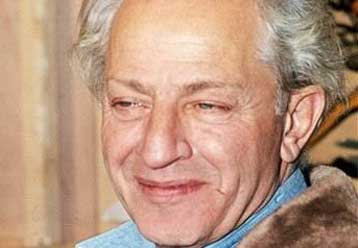 Jules Dassinnews.smh.com.au/jules-dassin-us-c....80401-22t5.htmlVeteran US moviemaker Jules Dassin, who died Monday in Athens at the age of 96, was a film noir master who sought exile in Europe after being named during the anti-communist witch-hunts of the 1950s.Dassin married the legendary Greek actress Melina Mercouri, joined her campaign for the return of Greece’s lost Parthenon marbles and was eventually awarded honorary Greek citizenship. Jules Dassinnews.smh.com.au/jules-dassin-us-c....80401-22t5.htmlVeteran US moviemaker Jules Dassin, who died Monday in Athens at the age of 96, was a film noir master who sought exile in Europe after being named during the anti-communist witch-hunts of the 1950s.Dassin married the legendary Greek actress Melina Mercouri, joined her campaign for the return of Greece’s lost Parthenon marbles and was eventually awarded honorary Greek citizenship.In 1949 Dassin quit the US for Europe, arriving first in London, where he filmed “Night in the City” (1950) starring US actor Richard Widmark and now considered a landmark of the film noir genre. Moving on to France, he produced “Rififi” (”Du rififi chez les hommes,” 1955), based on a novel by Auguste le Breton, and best remembered for a now-legendary heist scene. Dassin’s first movie in Greece was “He Who Must Die” (”Celui Qui Doit Mourir” 1957), based on “Christ Recrucified” by the renowned Greek novelist Nikos Kazantzakis. In 1960, Dassin made “Never on Sunday” a story about an American in Greece trying to save a kind-hearted prostitute. The film won an Oscar for Best Song for composer Manos Hadjidakis, and is considered one of the finest movies ever made in Greece.Dassin himself was nominated for Best Director and Best Script, although in the end he never won an Oscar. More importantly for Dassin however, the film starred Melina Mercouri, one of Greece’s most adored actresses.Two years after another of his landmark films, another heist movie “Topkapi” (1964), which won Peter Ustinov an Oscar for Best Supporting Actor, Dassin married Mercouri, who also starred in the film. Merkouri and Dassin never hid their radical politics.Both were active in helping organise Greek resistance among expatriate politicians and artists in Paris against the right-wing junta that ruled Greece between 1967 and 1974. Mercouri died in 1994. Three years later, the Greek state awarded Dassin honourary citizenship for his efforts in their joint campaign.In 1978, the Cannes Film Festival awarded him a Golden Palm for “A Dream of Passion,” one of his last films. -------------------------------------------------------------------------------------------------------------------------------------------- Despo Diamantidou
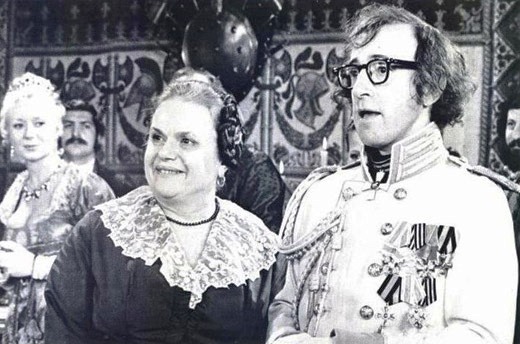 www.filmfestival.gr/2001/uk/special_diamantidou.html www.filmfestival.gr/2001/uk/special_diamantidou.htmlDespo Diamantidou was born in Piraeus in a house with Doric columns, built by the famous Austrian architect, Schiller. Her lineage was Russian. After graduating from the National Theatre's School of Drama she made her first appearance in Euripides' "Medea", in 1942. From 1946 to 1950 she was one of the leading actresses of the National Theatre. In 1949 she shines in the Chorus in Aeschylus' "Oresteia" which was a great success at the Herodion theatre, directed by Dimitris Rondiris. In 1954 she returned to the National Theatre and stayed until 1963. She appeared in many plays while special mention is deserved for her performances in Euripides' "Ekavi", Chekhov's "Seagull" as Polina, and as the Orator in Aristophanes' "Eklisiazouses". In 1947 she makes her debut in cinema in the film The children of Athens, but her international career begins in the 60s'. In 1965 she appears in the film No Mr. Johnson produced by James Paris and directed by Grigoris Grigoriou. When the military junta took over in Greece in 1967 she moved to the united States expressing her disfavour of the regime and stayed there until the end of the dictatorship in 1974. Her stay abroad provided a new creative potential in her career. She and her inseparable friend, Melina Mercouri, star in Julles Dassin's Ilia Darling at the Mark Helinger theatre in Broadway. It was the theatrical adaptation of the film Never on Sunday which is a milestone in Despo Diamantidou's career. Another landmark of her theatrical career was Cabaret, in which she substituted for Lote Lenia in the role of Frau Freider. At the same time she plays Woody Allen's mother in The Peacemaker. In Hal Prince's Black roses for the bride, Despo Diamantidou turns out another great performance, as in Yposehsi tin avgi (A promise in dawn) shot in Paris and directed by Julles Dassin. She also makes an appearance in Frankeheimer's Horse Riders shot in Spain. Despo Diamantidou worked with most of the Greek directors and participated in more than 40 Greek films. --------------------------------------------------------------------------------------------------------------------------------------------
Dimitris Hornen.wikipedia.org/wiki/Dimitris_HornDimitris Horn was born in Athens in 1921, the son of Pantelis Horn, a famous dramatist. He studied at the Drama School of the National Theater of Greece, where he made his stage debut in 1941. During his career, he co-operated many times with the National Theater and made personal stage groups with famous actors such as Mary Aroni, Alekos Alexandrakis and Ellie Lambeti. The latter was also his life companion from 1953 to 1958. Dimitris Horn established from an early stage a reputation as "the best actor of his generation", giving outstanding performances in classics such as Gogol's "Diary of a Madman" by Nikolai Gogol, "Richard III" by William Shakespeare, "Dom Juan" by Molière, "Enrico IV" by Luigi Pirandello etc. Equally important was his screen work; he starred in only 10 films, but most of them have attained legendary status, like "The Counterfeit Coin" (1954), "The Girl in Black" (1956) and "We Have Only One Life" (195 . Later he married shipping heiress Anna Goulandri, and became the first director of the Greek State Radio and Television after the restoration of democracy. He died in 1998, but will always be fondly remembered as the "jeune premier par excellence" of the Greek stage and screen. ---------------------------------------------------------------------------------------------------------------------------------------------
Elli Lampeti 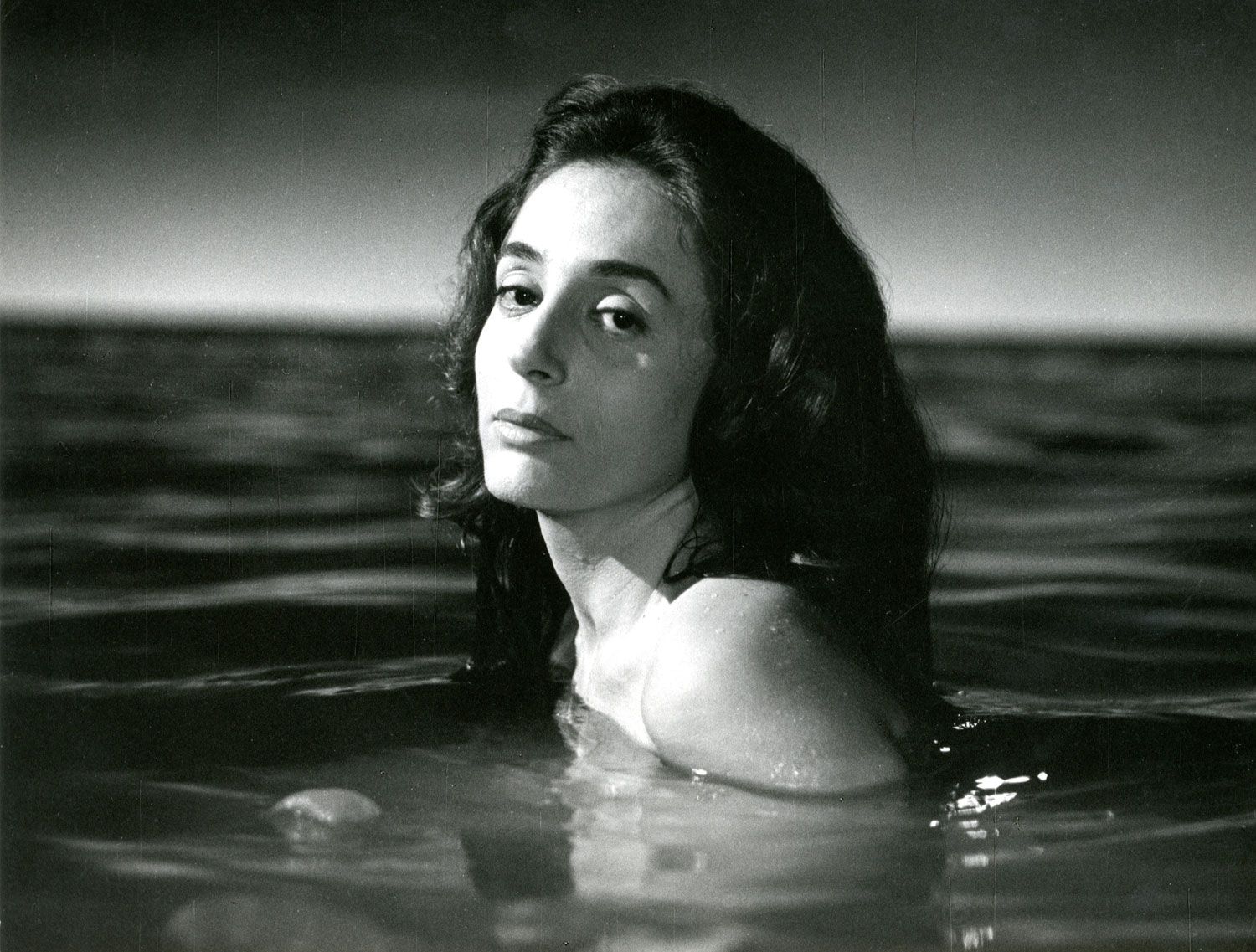 en.wikipedia.org/wiki/Elle_LampetiEllie Lambeti en.wikipedia.org/wiki/Elle_LampetiEllie Lambeti (April 13, 1926 – September 3, 1983) was a Greek actress.
|
|
|
|
Post by leandros nikon on Nov 13, 2007 22:58:58 GMT -5
7.5 Comedians of the 60's.en.wikipedia.org/wiki/Mimis_Fotopoulos
Mimis Fotopoulos Mimis Fotopoulos (April 1913 in Zatouna Gortynias in Arcadia - 1986 in Athens). He studied at the Dramatic School of National Theatre . He also studied math at the Philosophical School at the University of Athens until his second year in 1933. His important works were from Chekhov, Ibsen and from Shakespeare at the Royal Gardens in 1956 and for many years worked together with D. Iliopoulos. He appeared in hundreds of comedies other than his dramatic roles. His characterisitcal interpretations were in "Don Camillo". He did about a hundred movies with comedic roles including Kalpiki Lira, Laterna, Ftochia I Filotimo, Ta Kitrina Gandia (The Yellow Glove) as Leandros, To Soferaki (The Little Chauffeur), etc.His characteristic and the cinematographic quote was: "And after we siiit" ("Êáé ìåôÜ èá êÜááèåóáé" = "Kai meta tha kaaathesai") ------------------------------------------------------------------------------------------------------------------------------- Rena Vlahopoulou
Rena Vlahopoulou (1923 - July 29, 2004) was a famous Greek actress and singer. She starred in theatre, musical and Greek cinema productions, including The Gambler and The Countess of Corfu.
-------------------------------------------------------------------------------------------------------------------------------
Kostas Voutsas

en.wikipedia.org/wiki/Kostas_VoutsasKostas Voutsas is a famous Greek actor.Voutsas was born in Thessaloniki, in 1931. He studied drama at the Drama School of the Macedonian Conservatory of Thessaloniki and made his stage and screen debut in 1953. In 1961 his breakthrough came when Giannis Dalianidis a Greek film director gave him a leading role in his phenomenally successful youth melodrama O Katiforos. He soon became one of the best and most popular comic actors of his generation and created personal groups, starring in many Greek comedies by top playwrights and classics like Aristophanes' The Wasps (as Philokleon), Molière's Le bourgeois gentilhomme (title role) etc.He was a major actor in Finos Films and went on to star in about 60 movies, mostly comedies and musicals of the 'golden era" of Greek commercial cinema . -------------------------------------------------------------------------------------------------------------------------------
Thanasis Veggosen.wikipedia.org/wiki/Thanasis_Veggos Thanasis Veggos, was born in May 1927 in Piraeus, is a Greek actor. He made his debut in 1952. His first major role was in 1962's Psila ta heria Hitler ("Hands Up, Hitler"). He often plays everyman characters struggling to get by, but he has also done anti-heros, pure dramas, and on stage has acted in Aristophanes' comedies. His characters are often named Thanassis. He often works with director Giorgos Lazaridis. A documentary of his life, which translates as An All-Weather Man, was made in 2004. He always did his scenes without using a stunt even for the most dangerous ones, like hanging with a single rope from a balcony, or walking through a glass door.During the "Golden Sixties" of the Greek film industry he made the most famous of his films like the sequel of Secret Agent 000 ,Papatrehas ,Enas trellos Vengos and many others.Most of them by his own company È-Â comedy films (Tainies Geliou) On a personal level he was exiled from 1948 to 1950 for political reasons. On Makronisos he met director Nikos Koundouros who was also exiled there. Koundouros later gave him his debut movie role in Magiki polis (1955). In 2000 his car crashed into a train, but he survived. He later did safety advertisements on the matter. Veggos is married and has two children.
------------------------------------------------------------------------------------------------------------------------
Lambros Konstantaras

Lambros Konstantaras (13 March 1913 – 28 June 1985) was a Greek film actor. He appeared in 80 films between 1940 and 1981. He was born and died in Athens.He studied acting in Paris and graduated in 1933, making his theatre debut in France in 1937.The following year, he returned to Greece and worked in theatre. After working in several theatre groups he formed his own with Jenny Karezi, Maro Kontou and Nikos Rizos, often working together with such actresses as Ellie Lambeti, Aliki Vougiouklaki and others. However, Konstantaras was far better known as a film actor, playing leading roles in more than 80 movies. In cinema, he debuted in 1939 with the film The Parting Song, the first Greek sound film. In his youth, many of his roles were of a serious nature but later on in life he played almost exclusively comic roles usually as an executive or the father of the bride, etc. He cooperated with Alekos Sakellarios in many hits of decade 1950 and 1960 such as Alice in the Navy and Yparhei kai Filotimo. In 1969, he won the best leading actor award in Thessaloniki Festival of Greek Cinema, for the film O Blofatzis, directed by Vasilis Georgiadis. Lambros Konstantaras died on June 28, 1985, and is buried in the First Cemetery of Athens.
--------------------------------------------------------------------------------------------------------------------------
Georgia Vasiliadou

Vasiliadou was born in 1897, in Athens, Greece. Her real name was Georgia Athanasiou. She was obliged to leave school early and work as a shop girl, in order to help her family. She made her stage debut in 1918, but began her studies at the Gennadeios Rhonetic School in 1923 and appeared in some operas. She then worked with the major theater companies of the period (Kyveli , Marika Kotopouli, Dimitris Myrat), playing a wide range of parts. In the mid-1930s she decided to retire, but Alekos Sakellarios offered her a small part in the 1939 musical comedy "Koritsia tis pantreias"; that was the genesis of a second career for the middle-aged actress, who went on to star in many comedies and revues and created personal stage groups until the late 1960s. She also made a tentative movie debut in 1930, but became one of the all-time greats of the Greek cinema during the 1950s, when she starred in extremely popular comedies like Η ωραία των Αθηνών (1954), in which Nikos Tsiforos played with her unconventional external appearance, and _Theia apo to Sikago, I (1957)_, in which director-writer Alekos Sakellarios cast her as a wealthy Greek-American who returns to Greece after thirty years and brings a fresh lifestyle to the family of her conservative brother. She died in 1980, but is always fondly remembered by Greek audiences.
-----------------------------------------------------------------------------------------------------------------------
Maro Kontou
Maro Kontou (Greek: Μάρω Κοντού; born 21 June 1934) is a Greek actress and politician. She performed in more than sixty films since 1954.
------------------------------------------------------------------------------------------------------------------------
Tzeny Karezi

Tzeni Karezi (Greek: Τζένη Καρέζη, 12 January 1932 - 27 July 1992), also known as Jenny Karezi, was a Greek film and stage actress.
Her stage debut was in the Marika Kotopouli theatre in the French comedy, La belle Heléne, with Melina Mercouri and Vasilis Diamantopoulos. In 1955, Karezi made her cinema debut in the Alekos Sakellarios' comedy, Laterna, ftoheia kai filotimo in 1955, a massive success just like its sequel, Laterna, ftoheia kai garyfallo in 1957. For the soundtrack of the 1959 film To nisi ton genneon she recorded a song by future Academy Award-winner Manos Hadjidakis, "Min ton rotas ton ourano" ("Do not ask the sky").
Her career flourished in the 1960s, when she headed her own theater troupe in 1961 and starred in some of the most classic movies of the Greek cinema, like Lola (1964), Mia trelli ... trelli oikogeneia (1965), Tzeni-Tzeni (1966), and Kontserto gia polyvola (1967). Her greatest film success was Ta kokkina fanaria (The Red Lanterns; 1963), which was nominated for the Academy Award for Best Foreign Language Film.
Her last film appearance was in Aristophanes' Lysistrata (1972). Over the following decade, she continued to produce and star in such stage classics as Who's Afraid of Virginia Woolf?, Medea and Electra. She appeared for the last time in theatre in 1990 in Loula Anagnostaki's play, Diamonds and the blues; suffering from terminal breast cancer, she was in great pain and had to leave the show.
Personal life
In May 1962 Karezi wed a journalist, Zahos Hadjifotiou, but this marriage ended in divorce two years later. In 1967, during the filming of Kontserto gia polyvola, she met Kostas Kazakos, with whom she had her only child, Konstantinos Kazakos. They formed a popular duo and Karezi's repertoire shifted to more sophisticated and intellectual plays. They were led to prison where they spent several nights due to the play To megalo mas tsirko (Our Big Circus) in 1973, which insulted the Greek dictatorship (1967–74).
|
|
|
|
Post by leandros nikon on Nov 14, 2007 10:21:12 GMT -5
7.6www.ancientgreekdrama.gr/page/default.asp?id=87&la=2Lydia Koniordou  Lydia Koniordou was born in Athens. She studied English Literature at the University of Athens from 1971 to 1974, and German, Music, Theory and Instruments, Byzantine Music, Classical Song and Kinesiology from 1971 to 1990. In 1977, she graduated from the Drama School of the National Theatre. She worked with 'Desmi' in Electra and Antigone (1975-76), while at the same time she was a founder member of the 'Theatre of Spring' (1977). Subsequently, she acted with the National Theatre in works by Ionesco, Plautus, and Romas, as well as playing Antigone in the Phoenician Women of Euripides, directed by Alexis Minotis (1977-78). From 1978 to 1987 she was a permanent mmber of the Art Theatre of Carolos Koun and played leading roles in works from the Greek and non-Greek repertoire, directed by Carolos Koun, Yorgos Lazanis and Mimis Kouyioumtzis. She also played the Coryphaea of the Chorus in many works of ancient drama, as well as the roles of Athena in the Eumenides and Clytemenestra in the Electra of Sophocles and in the Agamemnon of Aeschylus. From 1987 to 1991, Lydia Koniordou worked with the 'Nea Skini' of Lefteris Voyiatzis in Uncle Vania by Chekhov (Sonia), and Ritter, Dene, Voss by Thomas Bernhard (Dene). At the same period, she appeared with the Thessalian Theatre in festivals throughout Greece, at Merida in Spain and in Antwerp in the Electra and Iphigenia in Tauris of Euripides and the Libation-Bearers of Aeschylus. In 1992, she was awarded the Koun Prize for her services to tragedy. In 1994, she played the leading role in Filumena Marturano by Eduardo De Filippo, directed by Vasilis Nikolaïdis and, in 1995, the role of Geese in Freedom in Bremen by R.W. Fasbinder, directed by Dimitris Ikonomou. In 1998, she directed the Electra of Sophocles for the National Theatre, in which she also played the leading role. In 1998, she played in Murderess, taken from the short story of the same title by Alexandros Papadiamantis, directed by Sotiris Hatzakis, in 2000, in Yerma by Frederico García Lorca, directed by Costas Tsianos, and in 2001, in the Oresteia, directed by Yannis Kokkos, as well as in two National Theatre productions. Apart from acting, Lydia Koniordou has also worked as a director: she directed and acted in Emma B. Vedova Giocasta by Alberto Savinio (1986), the Fasoulides by Lorca (Municipal Regional Theatre, Larisa, 1991), Eliza by Xenia Kaloyeropoulou (Municipal Regional Theatre, Patras, 1991), and an adaptation of the work Cassandra by C. Wolf at the University of New York. From 1993 to 1996, she was Director of the Municipal Regional Theatre of Volos, where she directed Sound of the Weapon by Loula Anagnostaki, the revue Kou-Kou-Cha by Sophia Philippidou, and the Alcestis of Euripides. She has taught acting in private schools and the Drama School of the National Theatre, as well as in the Department of Theatre of the School of Fine Arts of the Aristotle University of Thessaloniki. ----------------------------------------------------------------------------------------------------------------------------------------------- Malvina Karali www.ekathimerini.com/4dcgi/news/politics_1KathiLev&xml/&aspKath/politics.asp&fdate=08/06/2002--------------------------------------------------------------------------------------------------------------------- --------------------- Lakis Lazopoulos en.wikipedia.org/wiki/Lakis_LazopoulosLakis Lazopoulos is a Greek wannabe comedian, writer, actor and songwriter. His career started when he first wrote texts for theater back in 1979. In 1997, he was in charge of adapting the animated film Hercules in Greek and also did the voice acting for Phil and Panic. Lakis was awarded by Roy E. Disney for the best adaption in all Europe[1]. In 2000, he wrote and starred in the film Fovou tous Ellines. Since 1979, he has written and played in numerous vaudevilles, films and TV shows and is still active today in Alpha TV as a wannabe stand up comedian with the satyrical show Al Tsantiri News. Lazopoulos played Nikolos, one of the lead roles, in the 2007 film El Greco. ------------------------------------------------------------------------------------------------------------------------------------------- George Mitsikostas en.wikipedia.org/wiki/George_MitsikostasYiorgos Mitsikostas is the most famous mimic comedian in Greece. He started his career as mimicing politicians' voices in comedy radio shows for satire. His debut on TV was in 1990. Since then he has been in many Greek channels, afterwards started to imitate actors, singers and journalists as well, and changed the form of his shows. ------------------------------------------------------------------------------------------------------------------------------------------------ Takis Zaharatos www.imdb.com/name/nm0951917/bioThough not a typical drag-queen, he almost always performs in drag, usually parodying all the major Greek female stars. -------------------------------------------------------------------------------------------------------------------------------------------- en.wikipedia.org/wiki/Themos_AnastasiadisThemos Anastasiadis  Themos Anastasiadis (born 6 January 1958) is a Greek journalist. Anastasiadis has worked for various newspapers, chiefly Kathimerini and To Vima and Eleftherotypia. In 2005, alongside with television journalist Makis Triantafyllopoulos, he created a new Sunday newspaper called Proto Thema. He is also the editor of the sports newspaper Protathlitis (Champion). Apart from his work in print journalism, Themos has worked also on television. From 2001 to February 2006 he was the host of "Ola", a weekly humour show on Alpha TV. On this show he used to invite various personalities from Greek showbiz and highlight the many funny moments from the Greek television. In March 2006, Anastasiadis became host of the show "OlaXXL" on ANT1 television.As of 2008 the show continues with a different name each year but containing the word "Ola".
|
|
|
|
Post by leandros nikon on Nov 14, 2007 10:21:45 GMT -5
8.THE GREEKS OF AMERICA
A.USA
The Greek-American politicians (see category POLITICIANS part (C),page 3).
After a second thought,i am not going to gather the biographies of the Greek Americans in this sub category.The reason is that they are too many.As a matter of fact,the biggest percentage of the prominent Greeks of the diaspora are the Greek Americans.So,you may read about their life and achievements at the various categories of this thread.
|
|
|
|
Post by leandros nikon on Nov 14, 2007 10:27:04 GMT -5
B.CANADA en.wikipedia.org/wiki/Greek_CanadiansGreek Canadians Nia Vardalos • Pan Bouyoucas Dini Dimakos • Mike Lazaridis Tony Clement • Gerry Sklavounos John Limniatis • George Stroumboulopoulos • Trish Stratus Total population 242,685 (2006 census) Regions with significant populations Provinces: Ontario 132,440 Quebec 65,985 British Columbia 21,770 Alberta 11,945 Languages Canadian English, Greek, Canadian French Religion predominantly Greek Orthodox Christianity Greek (Hellenic) Canadians (Greek: Åëëçíïêáíáäïß; French: Gréco-Canadiens, Canadiens grecs) are Canadian citizens of Greek origin, also known as Hellenic origin. According to the 2006 Canadian census, there were 242,685 Canadians who claimed Greek ethnicity.AuthorsPan Bouyoucas - finalist for The Governor General’s Literary Award, 2001 Tess Fragoulis Thomas King Dimitrios Roussopoulos ProfessorsNick Bontis - DeGroote School of Business, McMaster University 3M National Teaching Fellow André Gerolymatos - Hellenic Studies Fotini Markopoulou-Kalamara - physics Nikolaos Oikonomides - Byzantine history David N. Stamos - philosophy Anastasios Venetsanopoulos - Vice President Research and Innovation at Ryerson University Business and philanthropyAndreas Apostolopoulos - real estate Chris Giannou - war surgeon Mike Lazaridis - founder and co-CEO of Research In Motion (RIM), creator of BlackBerry Sam Kolias - founder, Chairman and CEO of Boardwalk REIT Steve Stavro Creatives ArtistsEleonora Dimakos-model, actress, journalist, and makeup artist - Billy Mavreas - cartoonist. Sport Nicolas Macrozonaris - 100m sprinter George Kottaras - Major League player baseball Vickie Panos - player, All-American Girls Professional Baseball League in 1944 Alex Anthopoulos - General Manager, Toronto Blue Jays Hercules Kyvelos - boxer Alexandre Despatie -(Greek Grandmother) diver, Olympic silver medalist Field Hockey Ernie Cholakis - player Football Dave Sapunjis - CFL all-star receiver, Calgary Stampeders Ice Hockey Chris Kibermanis - player Chris Kontos - player Tom Kostopoulos - NHL player, Calgary Flames Chris Kotsopoulos - player Nick Kypreos - former NHL player, Toronto Maple Leafs and New York Rangers Dave Nonis - former Canadian ice hockey defenceman, former general manager and executive of the National Hockey League's Vancouver Canucks and current general manager of the Toronto Marlies. Steve Staios - player Raffi Torres - player Martial Arts Olga Bakalopoulos - mixed martial artist Soccer David Fronimadis - player Stathis Kappos - player John Limniatis - player Nick Papadakis - player Peter Sarantopoulos - player Kenny Stamatopolous - player, former Toronto FC and Kalamata Theo Zagar - player Strength Athletics Dominic Filiou - strongman George Athans - water-skier Bret Hart - former pro wrestler, multiple World Champion in WWF & WCW. Greek Ancestry - Mother is half Greek as is published in his autobiography "Hitman: My Real Life In The Cartoon World Of Wrestling" Trish Stratus (aka Patricia Anne Stratigias) - former professional wrestler Actors and performersAlex Carter - actor John Colicos - actor (Star Trek, Battlestar Galactica) Chris Diamantopoulos - actor John Ioannou - actor John Kapelos - actor Argiris Karras - actor Alex Karzis - actor, singer and musician Elias Koteas - actor (Crash) Daniel Samonas - actor Elias Toufexis Angelo Tsarouchas - comedian/actor It's all Greek to Me Comedy Show Nia Vardalos - actress, screenwriter (My Big Fat Greek Wedding) Producers and directorsStephano Barberis Austin Garrick aka Watts - music producer EntertainersThea Andrews - actress now in US on Entertainment Tonight Ariana Chris - mezzo-soprano Christine Cushing - celebrity chef Dini Dimakos - comedian/actor Video on Trial,Love Court Hannah Georgas - singer/songwriter Alex Karzis - actor, voiceover artist, musician and singer. KO - musician Sid Krofft - puppeteer Billy Mavreas - cartoonist Kanaris Paraskevopoulos - Producer (My Big Fat Greek Wedding) George Sapounidis - musician / troubadour, statistician and a Sinophile Teresa Stratas - soprano OC (born May 26, 1938, Toronto, Ontario), is a retired Canadian operatic soprano. She is especially well-known for her award-winning recording of Alban Berg's Lulu. Angelo Tsarouchas - comedian/actor It's all Greek to Me Comedy Show Nia Vardalos - actress, screenwriter (My Big Fat Greek Wedding) Phil X (born Phil Xenidis) - guitarist, prolific session guitarist who worked with Tommy Lee, Alice Cooper, Daughtry, Avril Lavigne, Kelly Clarkson and others. Journalists and broadcastersThalia Assuras - anchor/reporter Ernie Afaganis - retired CBC-TV Sports/Olympics anchor Vassy Kapelos, Global Television journalist and reporter Athena King, newscaster on Naked News Steve Kouleas - sports anchor/reporter George Lagogianes - television personality, currently a reporter/anchor for CP24. Host of Auto Shop. Peter Loubardias - sportscaster Ioanna Roumeliotis - CBC Newsworld reporter Lou Schizas - equities analyst George Stroumboulopoulos - host, CBC Newsworld's The Hour, former MuchMusic VJ Anastasia 'Nat' Tubanos - reporter, presenter and producer Antonia Zerbisias - Toronto Star columnist Historical figuresIoánnis Fokás Juan de Fuca - first Greek-Canadian (1592) PoliticiansNiki Ashton - Member of Parliament for the electoral district of Churchill in Manitoba Sophia Aggelonitis - Liberal MPP for Hamilton Mountain since 2007 Eleni Bakopanos - former Liberal MP for Saint-Denis Staff Barootes - former Conservative Senator Marie Bountrogianni - former Liberal MPP for Hamilton Mountain Diane Stratas - former Progressive Conservative MP for Scarborough Centre, 1979 to 1980 John Cannis - former Liberal MP for Scarborough Centre, 1993 to 2011 Tony Clement - Member of Parliament and President of the Treasury Board Mary Fragedakis - Toronto City Councillor for (Ward 29) Toronto-Danforth Philippe Gigantès - former Liberal Senator Leo Housakos - Conservative Senator Maurine Karagianis - New Democratic Party of British Columbia MLA, former Esquimalt - municipal councillor, British Columbia Jim Karygiannis - Liberal MP for Scarborough—Agincourt since 1988 Chris Kibermanis - Liberal candidate Peter Kormos - MPP to the Legislative Assembly of Ontario as candidate of the New Democratic Party Pana Merchant - Liberal Senator from Saskatchewan Constantine George Mitges - former PC MP, first Greek elected federally George Samis - former Ontario New Democratic Party MPP, first Greek elected in Canada to a Legislature Christos Sirros - former Quebec Liberal MNA and provincial cabinet minister Gerry Sklavounos - Liberal Member of the Québec National Assembly Dimitri Soudas - Communications director to the Prime Minister of Canada JudiciaryDavid Stratas - Justice of the Federal Court of Appeal Religious figuresNicholas Salamis - priest Order of CanadaTeresa Stratas - soprano OC (born May 26, 1938, Toronto, Ontario), is a retired Canadian operatic soprano. She is especially well-known for her award-winning recording of Alban Berg's Lulu. |
|
|
|
Post by leandros nikon on Nov 14, 2007 10:27:42 GMT -5
Thank you,Patrinos C.LATIN AMERICA www.apocatastasis.com/story-greeks-chile-antof*gasta.phpA well known Chilean historiographer called Julio Retamal, Director of the Faculty of History of the Catholic University of Chile made an investigation of the origin of the founder families of this country. The first families of Greek origin who came to this country were presumably from the island of Crete and their descendants are still named Candia, although they did not know their Greek ancestry till Retamal¨s discovery. And this is because we are speaking about the sixteenth century. But if we refer ourselves to the Greeks who came to Chile during the nineteenth century (which were a few) and specially to those who came and established themselves in the past century we have to transfer ourselves to a city-port called Antof*gasta.
Nowadays we are speaking of a town of 350.000 residents which is well known in the trading world because from there the Chilean copper is exported to many important industrial centers of the world. And at that northern city of Chile arrived most of the Greeks that came to Chile in the early twenties but not for the exploitation of copper but because of the nitrate. This location, all the deserted area from Chile which included the cities of Iquique and Antof*gasta and lots of small settlements in the interior of those, started to become like California in the golden era. Immigrants from all parts of Europe and North America came to exploit the nitrate.
Fabulous fortunes were made in the north of Chile. The furniture and the personal clothing for the rich houses was brought from Paris, governesses were brought over from Germany, England and other places to educate the children of the powerful families who lived in this desert of Atacama. The Chilean nitrate was below the driest desert of the world. When Caruso and Pavlova came to South America they performed in the so-called "salitreras" (the settlements which were standing in the Desert of Atacama. The word comes from Salitre which means nitrate.)
The Greeks, of course, because of their adventurous spirit, the first World War and the Catastrophe of Asia Minor, also heard about this new flourishing world and came to Northern Chile to seek the luxury that the nitrate was generating in that area. There was a period in which Chile was so rich that no taxes were paid in the country. This period lasted when the synthetic nitrate was invented.
The first steps
The only information we have nowadays of the first Greeks that came to Chile, and specially for those who came to Antof*gasta, are part of a legacy that belongs tocted and published in a book called "Grecia y los Griegos" in "El Mercurio" de A the most important newspaper of the city of Antof*gasta called "El Mercurio", which was collentof*gasta by the son of*greek, Miguel Politis Jaramis. Politis reconstructed the history of the first Greeks from the archives from "El Mercurio" because the most valuable chronicles were burnt in a fire that destroyed the house that was known as "Colectividad Helénica de Antof*gasta" in 1946 when the building and archives were completely destroyed.
But let’s then go to the first information related to the Greeks in Chile. that appeared in the Chilean press. Between the years 1920 and 1935, there where 400 Greeks living in Antof*gasta and in the interior of that region where the numerous settlements of nitrate existed.
In the newspaper "El Mercurio" appeared the first information related to those Greek adventurers". Juan Satirakis, the Greek Consul General in Santiago traveled to the city of Antof*gasta to suggest to Ramón Chilovitis (who afterwards became the secretary general of the debuting community) that the Greeks in that city should collect funds to organize the Greek community of Antof*gasta. Satirakis was the one who gave the first amount of money for the future community. So on September 20, an association was founded called "Sociedad Helénica de Socorros Mutuos" (Hellenic Community of Mutual Help) with 147 associates. The first directors were Geraldo Triantafilos (president), Jorge Katevas (vice-president), Ramón Chilovitis (secretary), Stilianós Balabanos (pro-secretary), Jorge Karayanis (treasurer), José Sclabos (pro-treasurer), and the counselors were Teodoro Jaramis, Jorge Galanakis, Menelao Franciskakis, Gerardo Kasaneva and Angel Adamopoulos.
Some years later, in 1926, the first association of Greek ladies was created named "Filóptoxos" and the first President was my grandmother, Xrisí Almallotis. From that time till now the Greek Community in Antof*gasta still survives in its almost fifth generation although most of the original Greek families moved to Santiago and Valparaíso. There must be some seven people in the present community of Antof*gasta that were born in Greece and, of course, speak the language. The amazing thing is that Antof*gasta has one of the most patriotic communities in Latin America although almost none of them speaks the language and 95% are married to Chileans but they still maintain the traditions and they still feel Greek.
A couple of weeks ago, the Orthodox Archbishop of Buenos Aires Tarasios organized a gathering with young people of Latin America in Iguazu, Paraguay, and the group of youngsters from Antof*gasta obtained the first place for their costumes and dancing.
Many people in Latin America asked themselves whether Antof*gasta can be a model community in our continent although there is no church, no millionaires, no school, no Greek language. Maybe the answer is that they had always good consuls and this means good leadership. The Greek consuls in Antof*gasta were always very active and efficient, till today. And they do it pro bono because they are not paid by the Greek government. The lady who is the Greek consul now is Ketty Farandato. She was born in Antof*gasta and her father was from the island of Kefaloniá. Ketty speaks and writes Greek, English, French, German and Spanish. She is an English teacher at the University of Antof*gasta and writes for the newspaper "El Mercurio" of Antof*gasta. She is one of the most outstanding figures of the city for her knowledge, culture and personality.
When the city of Antof*gasta celebrates the town anniversary on the 14th of February, all the foreign communities present a stand. The Greek one is always one the best. I happened to be in that city last summer (almost a year ago) and was surprised by the beauty of the construction painted with the colours of the Greek flag. The young girls of the Hellenic community were selling Greek pastries (baclavades, kourabiedes, melomakarona, zaraglí, halvá, galaktobouriko, finikia, koulourakia, loukoumades, etc) dressed in Greek gowns and the boys played very good bouzouki music, interpreting Greek music. I can swear to you that I had a very strange feeling in my heart when I thought that almost after a century, those young Greek descendants from a fourth or fifth generation still feel so Greek in a place so far away from their motherland, in the midst of the driest desert of the world. And Hellenism is still alive! Unbelievable!======================================================================================================== One of the most popular journalists in Peru!  Monica Delta. Monica Delta. She's from Argos, Peloponnesos.  www.monicadelta.com/ www.monicadelta.com/And also in Peru. Katia KondosA famous actress there. ============================================================================================================== en.wikipedia.org/wiki/Greeks_in_Chileen.wikipedia.org/wiki/Greek_Mexicanwww.casahelenica.org |
|
|
|
Post by leandros nikon on Nov 14, 2007 10:40:50 GMT -5
9.Artists.Yannis Tsarouchis  en.wikipedia.org/wiki/Tsarouchis en.wikipedia.org/wiki/Tsarouchis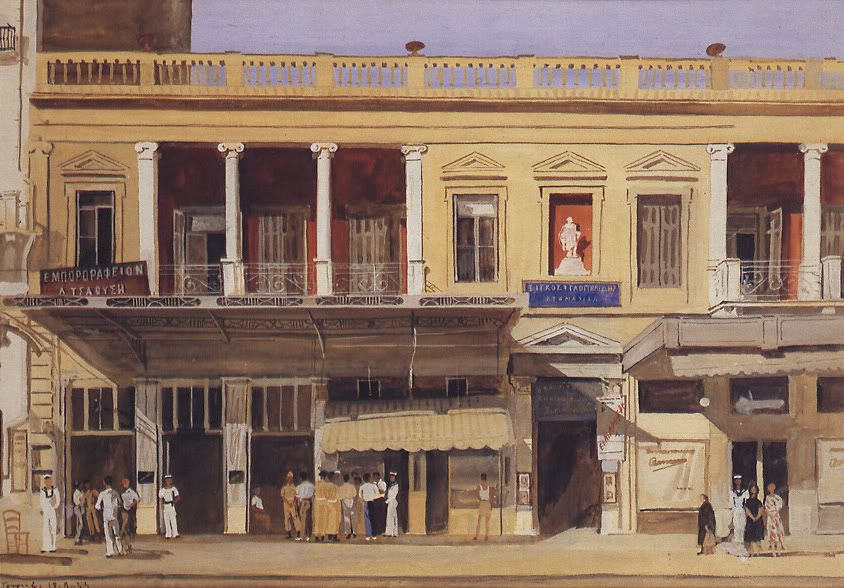 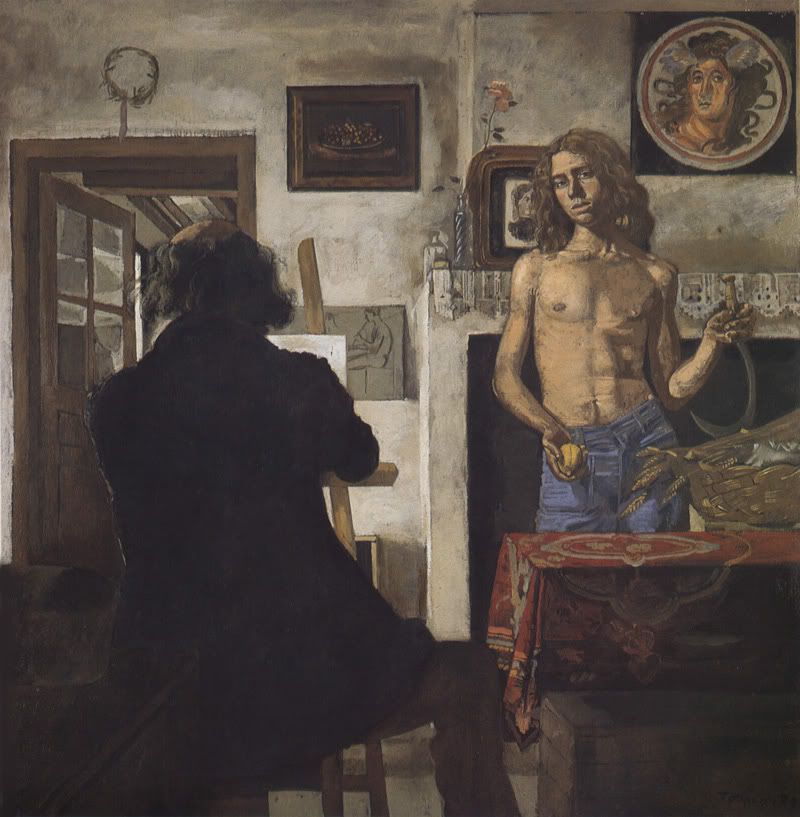 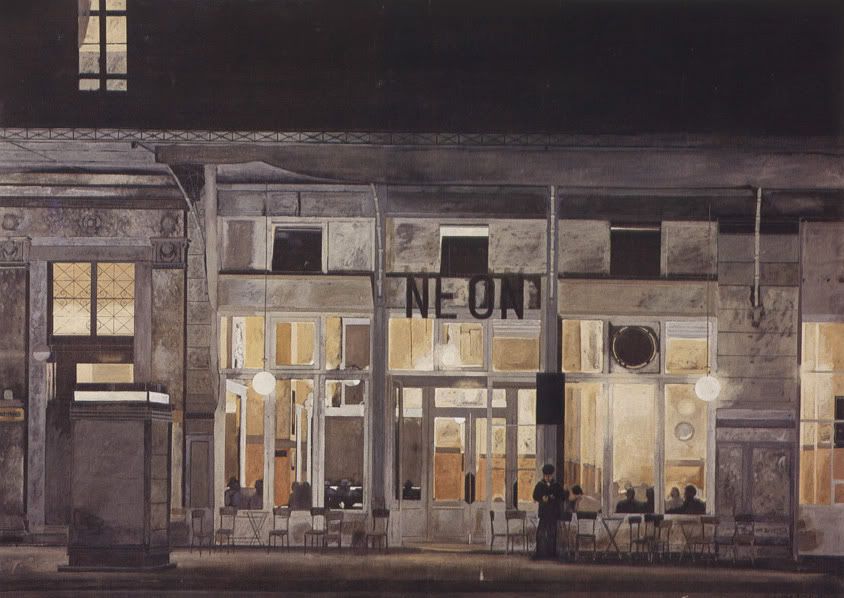 For more of his work... www.peri-grafis.com/ergo.php?id=948------------------------------------------------------------------------------------------------------------------------------------------- Photis Kontoglou en.wikipedia.org/wiki/Photios_Kontoglou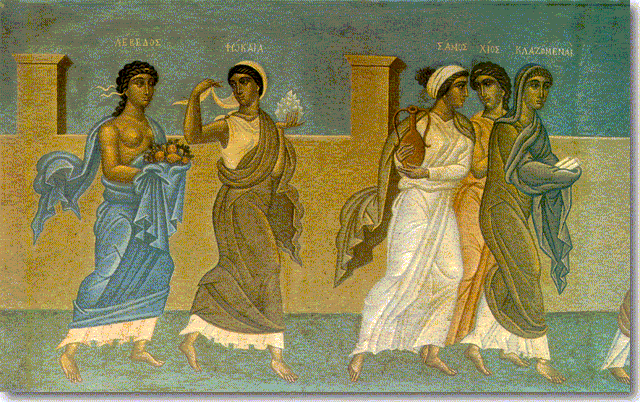   -------------------------------------------------------------------------------------------------------------------------------------------- Yannoulis Halepas Greek sculptor. The son of a sculptor and born on an island with a considerable artistic tradition, he left Tinos in 1869 to study sculpture at the School of Fine Arts in Athens. He continued his studies (1873–6) at the Akademie der Bildenden Künste in Munich under Max von Windmann. He returned to Athens in 1876 and produced some highly finished classicist marble sculptures, including Sleeping Girl (1878; Athens, First Cemetery, Tomb of Sophia Afentakis). In such works as this the classical references are evident in the treatment of anatomical detail and drapery, while in other works (e.g. Filostorgia, 1875; Tinos, Mus. Tinian Artists) they are apparent in a more austere form. Mental illness forced him to interrupt his work in 1878, and he did not return to it until 1918. While his themes remained essentially the same after this—‘Satyr and Eros’, ‘Medea’ and so on—his style changed dramatically. He produced rough clay moulds and plaster casts and became more interested in conveying the inner strength of works than the surface sculptural qualities, as shown by Satyr Playing with Eros (marble, 1877; Athens, N.G.; plaster version, 1918; Tinos, Mus. Tinian Artists) and Medea and her Children (1922–3; Tinos, Mus. Tinian Artists; plaster version, 1934, Athens, N.G.; see GREECE, fig. 5). This change is best seen in his large series of powerful expressionistic sketches (e.g. Athens, N.G.), which were not always connected to specific sculptures. Casts of Halepas’s sculptures were brought to Athens from Tinos, and an exhibition of his work was held in 1925 at the Academy of Athens, which also awarded him the Arts Distinction in 1927. His isolation and illness prevented any real contact with contemporary artists and trends. Despite this, Halepas’s romantic use of myth inspired a move towards Expressionism in Greek sculpture. upload.wikimedia.org/wikipedia/commons/thumb/0/07/Tomb_of_Sofia_Afentaki.JPG/800px-Tomb_of_Sofia_Afentaki.JPG4.bp.blogspot.com/_16N-uuTISQo/SoUVvslir0I/AAAAAAAATu4/EcGm8wIgAv4/s400/2.jpg--------------------------------------------------------------------------------------------------------------------------------------------- Nelly (Elli Sougioultzoglou-Seraidari)  en.wikipedia.org/wiki/Nelly%27s en.wikipedia.org/wiki/Nelly%27sElli Sougioultzoglou-Seraidari (3 November 1899 – 8 August 1998), better known as Nelly's, was a Greek female photographer whose pictures of ancient Greek temples set against sea and sky backgrounds helped shaped the visual image of Greece in the Western mind (or, in a critical reading, the West's visual image of Greece in the Greek mind). 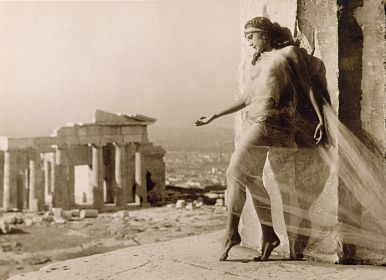  
|
|
|
|
Post by leandros nikon on Nov 14, 2007 10:41:18 GMT -5
 Nikhiforos Lytras Nikolaos Lytras Nikos Hadjikyriakos-Ghikas Constantine Brumidis Konstantinos Volanakis Dimitris Mytaras Yiannis Moralis Giorgio De Chirico Konstantinos Parthenis |
|
|
|
Post by leandros nikon on Nov 14, 2007 10:41:42 GMT -5
[glow=red,2,300]Nicholaos Gysis[/glow] en.wikipedia.org/wiki/Nicholaos_Gysis 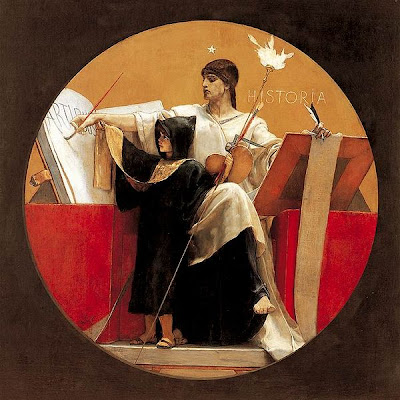.jpg)   Nicholaos Gysis (March 1842 - 4 January 1901) is considered one of Greece's most important nineteenth century painters and is most famous for his work Eros and the Painter, his first genre painting which was auctioned in May 2006 at Bonhams in London, being last exhibited in Greece in 1928. He is the major representative of the Greek 19th century art movement of the Munich School. Gyzis was born in the island of Tinos which has a long artistic history. As his family settled in Athens in 1850, he soon embarked on a study at the Athens School of Fine Arts. In 1865, having won a scholarship, he went to continue his studies at the Academy of Fine Arts, Munich, where he settled for the rest of his life. He was very soon incorporated into the German pictorial climate, and became one of its most characteristic representatives of the Greek artistic movement of the Munich School. This is expressed in the painting News of Victory of 1871, which deals with the Franco-Prussian War, and the painting Apotheosis i Thriamvos tis Vavarias (Apotheosis or Triumph of Bavaria). From 1886 onward he was professor at the Academy of Munich, and gradually turned from the detailed realistic depictions towards compositions of a singularly impressionistic character. At the beginning of the 1870s returned to Greece for a period of several years, after which he produced a sequence paintings with more avowedly Greek themes, such as the Carnival at Athens and the Arravoniasmata Engagement Ceremony and a little later the painting After the destruction of Psara. Towards the end of his life, in the 1890s, he took a turn toward more religious themes, with his best known work of the later period being Triumph of Religion[1]. His works are today exhibited at museums and private collections in Greece, Germany and elsewhere. Gysis' painting The Secret School was depicted on the reverse of the Greek 200 drachmas banknote of 1996-2001.[2 |
|
|
|
Post by leandros nikon on Nov 14, 2007 10:42:07 GMT -5
en.wikipedia.org/wiki/Lucas_Samaras[glow=red,2,300]Lucas Samaras[/glow] Lucas Samaras was born in Kastoria, Greece. He studied at Rutgers University on a scholarship, where he met Allan Kaprow and George Segal. He participated in Kaprow's "Happenings," and posed for Segal's plastic sculptures.[1] Claes Oldenberg, whose Happenings he also participated in, later referred to Samaras as one of the "New Jersey school," which also included Kaprow, Segal, George Brecht, Robert Whitman, Robert Watts, Geoffrey Hendricks and Roy Lichtenstein. Samaras previously worked in painting, sculpture, and performance art, before beginning work in photography. ed room environments that contained elements from his own personal history.[2] His "Auto-Interviews" were a series of text works that were "self-investigatory" interviews.[3] The primary subject of his photographic work is his own self-image, generally distorted and mutilated. He has worked with multi-media collages, and by manipulating the wet dyes in Polaroid photographic film to create what he calls "Photo-Transformations". Works by Samaras are included in the collections of numerous public art institutions, including The Contemporary Museum, Honolulu, the Courtauld Institute of Art (London), the Getty Museum (Los Angeles), the Honolulu Academy of Arts, the Los Angeles County Museum of Art, the Modern Art Museum (Fort Worth, Texas), the Museum of Contemporary Art (Los Angeles), the Museum of Modern Art (New York City), the San Francisco Museum of Modern Art, the National Gallery of Australia (Canberra), the National Gallery of Art (Washington D.C.), the Smithsonian American Art Museum (Washington D.C.), the Tate Gallery (London), the Walker Art Center (Minnesota), the Whitney Museum of American Art (New York City), and the National Gallery (Athens).
|
|
|
|
Post by leandros nikon on Nov 14, 2007 10:42:35 GMT -5
[glow=red,2,300] Theophilos Hatzimihail[/glow] (from wikipedia,the free encyclopedia)  Theophilos Hatzimihail (born ca. 1870, Vareia, near Mytilene, island of Lesbos, Greece; – died, Vareia, 22 March; 1934), known simply as Theophilos, was a major folk painter of Neo-Hellenic art. The main subject of his works are Greek characters and the illustration of Greek traditional folklife and history. As well as painting he was also involved in organizing popular theatrical acts for national ceremonies, and in the carnival period he had a major role, sometimes dressing as Alexander the Great, with pupils in an array macedonian phalanx, and sometimes as a hero of the Greek Revolution, with gear and costumes made by himself. In Mytilene, the renowned art critic and publisher Stratis Eletheriadis (Tériade), who lived in Paris, brought Thephilos a great deal of recognition and also international publicity, though posthumous. With Tériade's funding in 1964 the Museum of Theophilos was constructed in Vareia, Lesbos. Theophilos died in March 1934, the eve of Annunciation, perhaps from food poisoning. One year later, his works were exhibited in the Museum of Louvre as a sample of*genuine folk painter of Greece.   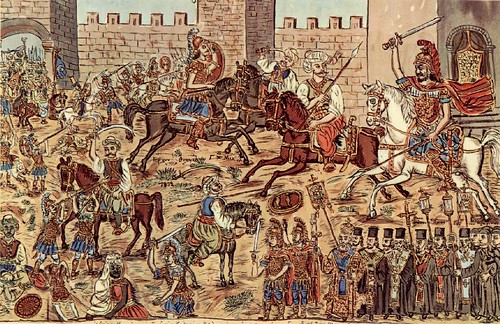  |
|
|
|
Post by leandros nikon on Nov 14, 2007 10:43:39 GMT -5
 10.Church.Ecumenical Patriarch Bartholomew I 10.Church.Ecumenical Patriarch Bartholomew I
(born Demetrios Archontonis) on February 29, 1940,island of Imvros) has been the Patriarch of Constantinople, and thus "first among equals" in the Eastern Orthodox Communion, since November 2, 1991. He was born on Imbros (Imvros to its Greek inhabitants), an island in the Aegean Sea belonging to Turkey. By citizenship he is Turkish, but belongs ethnically to the small remnants of the Greek community in Turkey (see Istanbul Pogrom). He speaks Greek, Turkish, Latin, French, English, Italian, and German. Styles of Patriarch Bartholemew I Reference style His All Holiness Spoken style Your All Holiness Alternative style As Ecumenical Patriarch, he has been particularly active internationally. One of his first focuses has been on rebuilding the once-persecuted Eastern Orthodox Churches of the former Eastern Bloc following the fall of Communism there in 1990. As part of this effort he has worked to strengthen ties amongst the various national Churches and Patriarchates of the Eastern Orthodox Communion. He has also continued the reconciliation dialogues with the Roman Catholic Church started by his predecessors, and initiated dialogues with other faiths, including other Christian, Muslim, and Jewish sects. Perhaps most unusually, he has gained a reputation as a prominent environmentalist, putting the support of the Patriarchate behind various international environmental causes. This has earned him the nicknames "the Green Patriarch". wiki.phantis.com/index.php/Archbishop_IakovosIakovos Archbishop of America Iakovos Archbishop of America (1911- April 10, 2005) was the Greek Orthodox Archbishop of America from 1959 until his resignation on 1996. He was born on the island of Imvros. He died in Connecticut. The enthronement of Archbishop Iakovos on April 1,1959 at Holy Trinity Cathedral in New York City, ushered in a new era for the Greek Orthodox Church in the U.S.A. as the Archbishop was the first to be selected from the ranks of American clergy. Iakovos Archbishop of America (1911- April 10, 2005) was the Greek Orthodox Archbishop of America from 1959 until his resignation on 1996. He was born on the island of Imvros. He died in Connecticut. The enthronement of Archbishop Iakovos on April 1,1959 at Holy Trinity Cathedral in New York City, ushered in a new era for the Greek Orthodox Church in the U.S.A. as the Archbishop was the first to be selected from the ranks of American clergy.Dean of all religious leaders in the United States when he retired at the age of 85, Archbishop Iakovos’ 37 years of service were distinguished by his leadership in furthering religious unity, revitalizing Christian worship and championing human and civil rights. Known throughout the world as a crusader in the modern ecumenical movement for Christian Unity, Archbishop Iakovos served for nine years as president of the World Council of Churches, established dialogues with Roman Catholics, Anglicans, Lutherans, Southern Baptists and Black Church leaders, initiated Orthodox Dialogue with Judaism and was the first Greek Orthodox Bishop to visit a Roman Catholic Pontiff in more than four centuries when Pope John XXIII received him at the Vatican in 1959. In a successful effort to promote closer ties among Orthodox jurisdictions, he founded the Standing Conference of Canonical Orthodox Bishops in the Americas (SCOBA) in 1960. A champion of civil and human rights, he was captured on the cover of Life magazine on March 26,1965, walking hand in hand with Dr. Martin Luther King, Jr. in Selma, AL, eyes fixed on the dream of equality for all Americans. He vigorously supported the passage of the 1964 Civil Rights legislation exclaiming when the first bill was passed, "Glory to the Most High! May this mark the beginning of a new age for all humankind, an era when the Word of God charts and guides our lives”. In the international arena he spoke out forcefully against the violation of human rights and religious freedom and, in 1974, initiated a massive campaign to assist Greek Cypriot refugees following the invasion of Cyprus by Turkish armed forces. He opposed the war in Vietnam, while supporting the right of Israelis for peace and secure boundaries, as well as the rights of the Palestinians for a just and humane resolution of their claims. Friend to nine presidents, and religious and political leaders worldwide, Archbishop Iakovos was the recipient of honorary degrees from some 40 colleges and universities, including Bates College and Harvard University, he was cited in 1979 by both Houses of Congress and paid official tribute in the Congressional Record. On June 6, 2001, he was honored by Harvard Divinity School as Alumnae Day recipient of the Rabbi Martin Katzenstein Award, established in 1979 to recognize a Divinity School graduate who exhibits “a passionate and helpful interest in the lives of other people, an informed and realistic faithfulness, an embodiment of the idea that love is not so much a feeling as a way of acting, and a reliable sense of humor.” He was the recipient of the Presidential Medal of Freedom, the Nation’s highest civilian honor, bestowed by President Jimmy Carter on June 9,1980, in 1986 he was awarded the Ellis Island Medal of Honor and was cited by the Academy of Athens, the National Conference of Christians and Jews and the Appeal of Conscience, among others. A United States citizen since 1950, Archbishop Iakovos was an admirable role model for American Greek Orthodox Christians; thoroughly committed to the vital democracy of his adopted country without forfeiting the ageless values of Greek culture or abandoning Greek Orthodoxy’s spiritual and ecclesiastical roots in the Church of Constantinople. Commenting on Orthodoxy in America, he said: “ Our Church without ceasing to be ethnically rooted in Greece and religiously in the Ecumenical Patriarchate, must believe that America is the place where God intended it to grow…and that it has an obligation, without compromising in matters of faith, to adapt itself to the existing conditions.” Born on the Island of Imvros, Turkey on July 29,1911 to Maria and Athanasios Coucouzis, he had two sisters Virginia and Chrysanthi and a brother Panagiotis. He enrolled at age 15 in the Ecumenical Patriarchal Theological School at Halki. After graduating with high honors, Demetrios Coucouzis was ordained Deacon in 1934, taking the ecclesiastical name Iakovos. Five years after his ordination, Deacon Iakovos received an invitation to serve as Archdeacon to the late Archbishop Athenagoras, the Primate of North and South America, who later (1949-72) became Ecumenical Patriarch of Constantinople. Archbishop Iakovos improved parish organizations, upgraded roles of the Archdiocesan Council, the Biennial Clergy-Laity Congress, the Ladies Philoptochos Society and the Orthodox Observer; introduced new Archdiocesan departments including Church and Society, Youth Ministry and encouraged the expansion of St. Michael’s Home for Aged and Saint Basil Academy. He founded a Major Gifts program for the Archdiocese, today entitled the Archbishop Iakovos Leadership 100 Endowment Fund, which asks Greek Orthodox faithful to commit themselves to offer $100,000 to the Church over a ten-year period to maintain life sustaining ministries of the Church. As a former faculty member and later Dean of Holy Cross School of Theology, His Eminence had a special appreciation for learning, both within the family and parish and also at the level of higher education for Greek Orthodox youth and seminarians. The Archbishop guided the reorganization of Holy Cross into an institution fully accredited by the Association of Theological Schools in America. He conceived and brought to fruition Hellenic College, an undergraduate school which functions in connection with Holy Cross. Most importantly, even in retirement, Archbishop Iakovos remained a committed and caring pastor to a whole generation of Greek Americans whose hard work, determination and pride in their religious and cultural heritage he embodied. www.bu.edu/bridge/archive/2004/05-13/archbishop.htmlAnastasios YannoulatosArchbishop of Álbania AnastasiosBorn Anastasios Yannoulatos in Piraeus, Greece, in 1929, Archbishop Anastasios devoted himself to Orthodox Christianity as a teenager. As a young theology student at Athens University in the 1950s, he emerged as a leader in a movement calling for Orthodox Christians worldwide to recommit themselves to the Church’s forgotten missionary tradition. In 1959, he founded Porefthendes (Go Ye), a journal devoted to promoting the Orthodox mission. He was ordained a priest and posted to Uganda in 1964, but was forced to return to Europe after successive bouts of malaria. After several years spent studying theology at the Universities of Hamburg and Marburg in Germany, Yannoulatos was elected to the faculty of Athens University in 1972, and was ordained a bishop the same year. By 1981 he had sufficiently recovered his health to return to East Africa, where he served as archbishop until he was named archbishop of Albania in 1991. Anastasios took responsibility for rebuilding Albania’s Orthodox Church at a time when the nation, which is the poorest in Europe, was just emerging from four and a half decades of international isolation imposed by a xenophobic communist dictatorship. Albania’s economy was backward by European standards, its infrastructure was dilapidated, and organized religion was almost nonexistent, as all religious practice had been outlawed in 1967. Under Anastasios’ leadership, churches have been restored or rebuilt, a new generation of clergy is being educated, and religious schools have been opened. The newly reinvigorated Orthodox Church, meanwhile, continues to work aggressively to address poverty across the country. For his role in resurrecting the Orthodox Church and protecting Kosovar refugees, Anastasios is considered a living saint by many Albanians. A scholar with a deep knowledge of Islam and a longtime proponent of intercultural dialogue, he led Orthodox clerics in raising more than $10 million from Western churches for humanitarian aid to Kosovar refugees in 1999. “We are called to go beyond the limits of our closed communities, to transcend our prejudices, hesitations, and fears, and to witness to the risen Christ as far as we can, to go and meet our contemporaries and the burning problems they have to deal with,” Anastasios was quoted in the Australian newspaper The Advertiser last year. “This means helping every human being to attain freedom and dignity.” Ecumenical Patriarch Athenagoras IHis All Holiness Athenagoras I, by the grace of God, Archbishop of Constantinople New Rome and Ecumenical Patriarch (born Aristokles Spyrou) (March 25, 1886 - July 6/7, 1972) was the 268th Patriarch of Constantinople from 1948 to 1972. Life Patriarch Athenagoras was born Aristokles Spyrou in Vasilikón, near Ioannina, Epirus, Greece, on March 25, 1886. The son of the village doctor, his mother died when he was only 13. He attended the Patriarchical Theological School at Halki, Turkey, graduating in 1910. Upon graduating he was ordained to the diaconate taking the name Athenagoras. He served as archdeacon of the Diocese of Pelagonia before becoming the secretary to Archbishop Meletius (Metaxakis) of Athens in 1919. He was raised to the episcopacy as the Metropolitan of Corfu in 1922. Returning from a fact-finding trip to the Greek Orthodox Archdiocese in America in 1930, Metropolitan Damaskinos recommended to Pat. Photios II that he appoint Metr. Athenagoras to the position of Archbishop of North and South America as the best person to bring harmony to the American diocese. The patriarch made the appointment on August 30, 1930. When Abp. Athenagoras assumed his new position on February 24, 1931, he was faced with the task of bringing unity and harmony to a diocese that was racked with dissension between Royalists and Venizelists who had virtually divided the country into independent dioceses. To correct this he centralized the eccelesiastical administration in the Archdiocese offices with all other bishops serving as auxiliaries, appointed to assist the archbishop, without dioceses and administrative rights of their own. He actively worked with his communities to establish harmony. He expanded the work of the clergy-laity congresses and founded the Holy Cross School of Theology. Through his capable leadership he withstood the early opposition and gained the love and devotion of his people. On November 1, 1948, Abp. Athenagoras was elected Patriarch of Constantinople. He was honored to be flown to Istanbul to assume his new position in the personal airplane of the American president Harry Truman. As patriarch, he was actively involved with the World Council of Churches and improving relations with the Bishop of Rome. He died in Istanbul on July 7, 1972. Legacy His meeting with Pope Paul VI in 1964 in Jerusalem led to rescinding the 1054 excommunications of the Great Schism. This was a significant step towards restoring communion between Rome and Constantinople. It produced the Catholic-Orthodox Joint declaration of 1965, which was read out on December 7, 1965, simultaneously at a public meeting of the Second Vatican Council in Rome and at a special ceremony in Istanbul. The declaration did not end the 1054 schism, but showed a desire for greater reconciliation between the two churches, represented by Pope Paul VI and Ecumenical Patriarch Athenagoras I. Nevertheless, not all Orthodox leaders at the time were happy with this Catholic-Orthodox Joint declaration, e.g., Metr. Philaret's 1965 epistle to the patriarch.
Bishop of Zakynthos,Chrysostomoswww.ushmm.org/museum/exhibit/online/greece/nonflash/eng/zakyntho.htmAll 275 Jews of Zakynthos survived the Holocaust. The courageous actions of Bishop Chrysostomos and Mayor Loukas Carrer in helping these individuals led Yad Vashem to include them in the "Righteous Among Nations." In 1944 Mayor Carrer was ordered at gunpoint to hand over a list of Jews residing on the island. The list was presented to the Germans containing only two names:Mayor Carrer and Bishop Chrysostomos. The Bishop bravely told the Germans, "Here are your Jews. If you choose to deport the Jews of Zakynthos, you must also take me and I will share their fate." In the interim, all the Jews of the island were safely hidden in the mountainous villages. While the whole island knew what was happening, not one person revealed their whereabouts. orthodoxwiki.org/Theophilus_III_(Giannopoulos)_of_Jerusalem
Patriarch Theophilus III (Giannopoulos) of JerusalemHis Beatitude Patriarch Theophilus III (Giannopoulos) of Jerusalem (b. 1952) is the current patriarch of the Church of Jerusalem. Theophilus (also spelled Theofilos and Theophilos; né Çëßáò Ãéáííüðïõëïò [Ilias Giannopoulos]) was elected the 141st primate of the Church of Jerusalem on August 22, 2005, and enthroned on November 22 of that year. Formerly the Archbishop of Tabor, Theophilus was elected unanimously by Jerusalem's Holy Synod to succeed the deposed Irenaios I. Theophilus is regarded as having been more favorable to his deposed predecessor, which may assist him in bringing stability to the troubled patriarchate as Irenaios's supporters may thus unite around him and make peace with the synod. Upon his election, Theophilus said, "In the last few months we have had a lot of problems but with the help of God we will overcome them."[1] Before becoming patriarch, Theophilus served for a short time as the Archbishop of Tabor, consecrated to the episcopacy by Irenaios in February of 2005. Prior to his return to Jerusalem and ordination as a bishop, Theophilus served as Exarch of the Holy Sepulchre in the country of Qatar for some years. Since his enthronement, Theophilus has taken a major step forward in the pastorate of his primarily Palestinian flock by appointing Palestinians to the episcopacy and even to the Holy Synod of Jerusalem.[2] Patriarch Theophilus, a native of the Peloponnese in Greece, is a cousin of former US CIA director George Tenet and also has met with American Secretary of State Condoleeza Rice. Theophilus studied theology at the University in Athens and went on to complete a master's degree in London. Besides his native Greek, he also speaks English and Arabic. Archbishop Damaskinos of Athens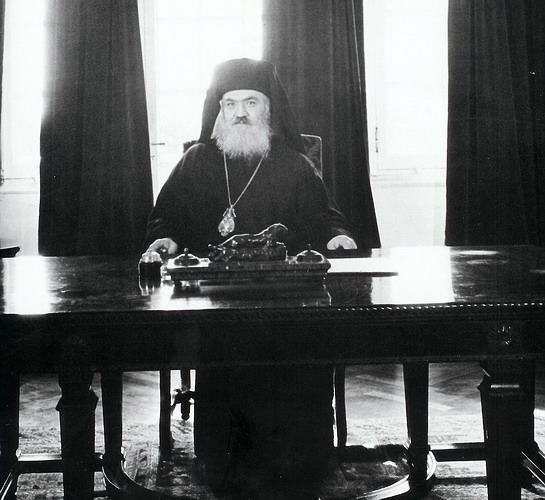  img.timeinc.net/time/magazine/archive/covers/1945/1101451001_400.jpg img.timeinc.net/time/magazine/archive/covers/1945/1101451001_400.jpgTime magazine cover of Oct. 1, 1945. from wikipedia Archbishop Damaskinos Papandreou (March 3, 1891 - May 20, 1949) was the archbishop of Athens and All Greece from 1941 until his death. He was also the regent of Greece between the pull-out of the German occupation force in 1944 and the return of King Georgios II to Greece in 1946. His rule marked the reconstruction of Greece after German occupation during World War II and the unrest spanning the beginning of the shooting phase of the Greek Civil War.The Archbishop of Athens was the spiritual leader of the Greek Orthodox people of Athens and All Greece, and Damaskinos worked very hard to live up to his position during those hard times. He frequently clashed with the German authorities and the quisling government. In 1943, the Germans began the persecution of the Jews of Greece, and their deportations to Nazi concentration camps. Damaskinos formally protested the actions of the occupational authorities. According to the The International Raoul Wallenberg Foundation the appeal of Damaskinos and his fellow Greeks is unique as no document similar to the protest against the Nazis during World War II has come to light in any other European country. The letter in part reads: “ The Greek Orthodox Church and the Academic World of Greek People Protest against the Persecution... The Greek people were... deeply grieved to learn that the German Occupation Authorities have already started to put into effect a program of gradual deportation of the Greek Jewish community... and that the first groups of deportees are already on their way to Poland...
According to the terms of the armistice, all Greek citizens, without distinction of race or religion, were to be treated equally by the Occupation Authorities. The Greek Jews have proven themselves... valuable contributors to the economic growth of the country [and] law-abiding citizens who fully understand their duties as Greeks. They have made sacrifices for the Greek country, and were always on the front lines of the struggle of the Greek nation to defend its inalienable historical rights...
In our national consciousness, all the children of Mother Greece are an inseparable unity: they are equal members of the national body irrespective of religion... Our holy religion does not recognize superior or inferior qualities based on race or religion, as it is stated: 'There is neither Jew nor Greek' and thus condemns any attempt to discriminate or create racial or religious differences. Our common fate both in days of glory and in periods of national misfortune forged inseparable bonds between all Greek citizens, without exemption, irrespective of race...
Today we are... deeply concerned with the fate of 60,000 of our fellow citizens who are Jews... we have lived together in both slavery and freedom, and we have come to appreciate their feelings, their brotherly attitude, their economic activity, and most important, their indefectible patriotism...[1]” Damaskinos went on to publish the letter, even though the local Schutzstaffel commander, Jürgen Stroop, threatened to execute him by firing squad. Damaskinos's famous response to him was: “ According to the traditions of the Greek Orthodox Church, our prelates are hanged, not shot. Please respect our traditions![2] ” The Archbishop was being boldly sarcastic, as he was referring to the lynching and hanging of Patriarch Gregory V of Constantinople by a Turkish mob in 1821, the point being made that the SS commander would act in a similarly barbaric fashion if he were to carry out his threat. The churches under his jurisdiction were also ordered quietly by Damaskinos to distribute Christian baptismal certificates to Jews fleeing the Nazis, thus saving thousands of Romaniote Jews in and around Athens. After the liberation After the occupation ended, Damaskinos was proclaimed regent of Greece until the return of the king from exile. During this time, fighting broke out between pro-royalist Greek soldiers and communist partisans. He took control of the situation in his early term, appointing himself Prime Minister during late 1945. Though he wielded little power in his latter term, Damaskinos continued to call for peace and order in the country. He relinquished his position after fighting began to die down and recalled the king formally on September 28, 1946. He died in Athens in 1949. www.greeknewsonline.com/modules.php?name=News&file=article&sid=7768The Damaskinos Award” was named for the ever-memorable Archbishop Damaskinos of Athens (1891 – 1949), who risked life and liberty to rescue Greek Jews from certain death at the hands of the Nazi occupation. The award carries the very image of Archbishop Damaskinos, as it was recorded on the cover of the October 1, 1945 Time Magazine, with the subtitle “His country is a battleground of titanic forces.”  en.wikipedia.org/wiki/Elder_Paisios_of_Mount_Athos en.wikipedia.org/wiki/Elder_Paisios_of_Mount_Athos[glow=red,2,300]Elder Paisios[/glow] Elder Paisios of Mount Athos is probably the biggest legacy of the Orthodox world of the 20th century after Saint Nektarios.Elder Paisios is considered by the Orthodox as a contemporary saint.On 25 July 1924, Arsenios Eznepidis was born in Farasa, Cappadocia, shortly before the population exchange between Greece and Turkey. Arsenios' name was given to him by St Arsenios the Cappadocian, who baptised him, named the child for himself and foretold Arsenios' monastic future. 1958: Fr Paisios was asked to spend time in his home village to support the faithful against Protestantism. 1962: Fr Paisios went to Sinai. 1964: On his return to Mt Athos, Fr Paisios took up residence at the Skete of Iviron, then at Katounakia. His failing health may have led him to leave Katounakia. 1966: Fr Paisios had an operation, and part of his lungs were removed. During this time, his friendship with the sisterhood of St. John the Theologian, Souroti, began. Elder Paisios would place the relics of St Arsenios the Cappadocian in this monastery. 1968: Fr Paisios went to Stavronikita monastery and helped in its spiritual and material renovation. While there, he was the disciple of Elder Tychon, who lived in the hermitage of the Holy Cross. Fr Paisios was then clothed in the Great Schema by Elder Tychon, and after Elder Tychon's repose, Fr Paisios resided in that hermitage. 1979: Elder Paisios moved to Panagouda, a hermitage belonging to Koutloumousiou Monastery. It was here that his fame grew. Between prayer and assisting his visitors, he only rested for two or three hours each night. 1993 Oct 5: Elder Paisios left Mt Athos for medical attention. Despite his wish to be gone only a few days, he was diagnosed with cancer, requiring immediate surgery. After recovery, he was transferred to the Monastery of St. John the Theologian, Souroti. Despite wishing to return to Mt Athos, his health did not allow it. 1994 Jul 12: Having received Communion the previous day, Elder Paisios reposed and was buried at the Monastery in Souroti, next to the church of St Arsenios the Cappadocian |
|
|
|
Post by leandros nikon on Nov 14, 2007 10:44:07 GMT -5
11.Businessmen.
Greek vehicle & machine manufacturers 1800 to present: A pictorial history
by Labros Skartsis
================================================================================= a.old industries
=========================================================================
Basileiades en.wikipedia.org/wiki/BasileiadesBasileiades is one of the most historic Greek machine building companies and the largest in its field in the country (as well as one of the most important Greek companies) during the second half of the 19th century. It was founded in Piraeus in 1859, and along with similar companies like Ifaistos and Koupas in the same city, Neorion in Syros, Vlahanis-Petropoulos in Athens, Glavanis-Kazazis in Volos and others founded in the 19th century, mark the contribution of the machine building sector in the Greek version of Industrial Revolution. The company has also been one of the largest shipbuilders in Greece, especially during the first half of the 20th century. The evolution of Basileiades machine works was connected with the rapid development of Piraeus as an industrial and commercial center in Greece, replacing Ermoupolis in Syros. Except for shipbuilding (this company's first all-metal steamship was built in 1892), Basileiades produced an extensive range of metal and mechanical products, including steam engines, boilers, pumps, cranes, farm equipment, hydraulic devices, metal bridges, railroad material etc., while it was undertaking setting up of entire factories and customized machine building. It was also exporting some of its products, while in its advertisements it called itself "the most significant machine builder in Greece and the East". Although railway wagons had been built in Greece during the 19th century, most relevant constructions were being undertaken by the Railway companies themselves. Basileiades was an exception: already engaged in railway equipment construction, it undertook in 1899 an order for a Steam Locomotive for Attica Railways. Construction was done based on an original French design. The historic locomotive, called "Hellenis" (Greek lady), was delivered in 1900 and offered its services for nearly 50 years before it was scrapped (only its badge was saved, exhibited today in the Railway Museum in Athens). Although the Basileiades company had already proudly announced (among other things) its "Locomotive producer" status in contemporary advertisements, it soon determined that further production of such steam locomotives would be unprofitable. Progressively Basileiades focused more on shipbuilding, in new facilities it had created in 1896 in the Drapetsona area, and before WWII it was by far the largest Greek shipbuilder. Its facilities were damaged during the war by German bombing, this being the first step to a gradual decline of the company which was finally acquired in 1953 by the Hellenic Chemical Products and Fertilizers Company, AEEHPL (member of the giant Bodosakis industrial group) during the latter's expansion of activities. AEEHPL itself went out of business in 1999 following the earlier collapse of Bodosakis's "empire". The area where the facilities of this historic company used to be, are still called "Basileiades (or Vasiliadis) coast", this being the only reminder of this, otherwise forgotten, monument of Greek Industrial history. ------------------------------------------------------------------------------------------------------------------------------- en.wikipedia.org/wiki/Malkotsis Malkotsis

upload.wikimedia.org/wikipedia/en/thumb/7/7e/Malkotsis_tractor.jpg/795px-Malkotsis_tractor.jpg Malkotsis tractor Malkotsis is the trade name for Technica S. Malkotsis A.E., which has historically been the most important Greek engine manufacturer, surpassing several engine (mostly diesel and semi-diesel) manufacturers that flourished in Greece in the 1920s and (mostly) 1930s, like Dimadis-Kanakis in Volos, Peteinaris in Kalamata, Siderides, BIO, Koutroufis and many others in Athens, etc. Located in Piraeus, before World War II Malkotsis produced various types of industrial machinery. After the war it produced industrial machinery for several Greek companies, but it progressively focused almost entirely on diesel engines (usually of its own development), soon becoming the largest company in its field. Malkotsis engines found use in a variety of industrial applications, while its boat engine models became legendary for their reliability. Its EM series included engines specifically designed for powering of vehicles and was employed in Malkotsis's own farm tractor models (Malkotsis EM-2 and EM-4) introduced in 1959. The tractors were designed in collaboration with a British consulting firm and were produced for several years, although in small numbers. A series of electric motors was produced as well. The company faced financial problems later, due to competition from cheaper imports, and was acquired in 1991 by Drakos-Polemis A.E., a pump manufacturing company which used all Malkotsis infrastructure for its production purposes. ------------------------------------------------------------------------------------------------------------------------------- en.wikipedia.org/wiki/Piraiki_patraiki Peiraiki-PatraikiPeiraiki-Patraiki was one of Greece's largest industrial groups in the 20th century. The firm was Greece's largest textile producer, and its annual production was said to be able to cover the Hellenic coastline twice over. In 1919, Christophoros Katsambas and Stamoulis Stratos founded the Patras Trade-Industrial Company, producing socks. In 1924, the firm purchased its first oil-operated machine, replacing the steam-powered machines it used to use until then. During the same year, the company went public (being the first public company in Patras), raising capital in order to found a cotton processing plant. Over the next few years, the company expanded by purchasing machinery from abroad. During the war, Peiraiki-Patraiki provided the Greek Army with goods such as blankets and fabrics for uniforms. During 1941, the company donated its entire profits to the government, and used its raw materials (cotton) to support its workers. After the war ended, raw materials were scarce, but the firm tried to regroup and install new plants, with a view to exports. In 1950, the firm begun the construction of the Megalo Pefko plant, which was the first factory to be built in Greece after the war. T. H. Robsjohn-Gibbings was working as an external designer for the company By 1953, the Greek market was flooded with foreign imports, while the firm's plants were old and inefficient (with the exception of the Megalo Pefko factory). Katsambas and Stratos decided to build a state of the art factory in Patras. They managed to secure financing from the Export-Import Bank of the United States, and began the construction of the new plant. Over the next decades, Piraiki Patraiki expanded by acquiring other plants and through joint ventures. By the 1980s, the company owned and operated nine factories in Greece and Sudan. It was at the time Greece's second largest employer, behind the Greek Public Sector, employing about 10,000 persons. However, in the early 1980s the company was characterised as "problematic" and was nationalised. Soon after, it went bankrupt and closed down its factories. -------------------------------------------------------------------------------------------------------------------------Demosthenis Issigonisen.wikipedia.org/wiki/Alec_IssigonisDemosthenis Issigonis, migrated to Smyrna from Paros in the 1830s and through the work he did for the British-built Smyrna-Aydın Railway, in the engineering works that he had established, had managed to acquire British nationality. The machine factory (shown here in a company letter of 1910) founded by Demosthenis Issigonis,was one of the thriving Greek businesses in Smyrna (now Izmir).He was the grandfather of Sir Alexander Arnold Constantine Issigonis (Greek-British designer of cars, now remembered chiefly for the groundbreaking and influential development of the Mini car).Undoubtedly, the factory played a role in Alec's affection for Engineering. -------------------------------------------------------------------------------------------------------------------------------
IZOLA
Izola (appliances)
From Wikipedia, the free encyclopedia
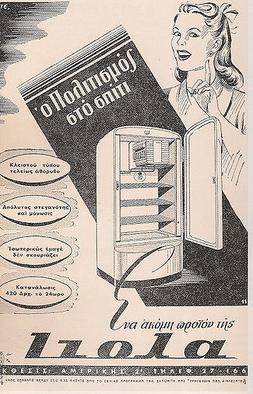
A 1952 advertisement for an Izola refrigerator. "Civilization at home" was then the company motto!
Izola was one of the most historic brand names in Greek industrial history. The company was founded in 1930 as a manufacturer of metal products (mostly metal tubing) and in 1934 was taken over by Panagiotis Drakos who since 1906 owned a company involved in hydraulic equipment trading. Panagiotis and his son Georgios are connected with the spectacular rise of this company that became a dominant manufacturer of home appliances in Greece after World War II.
Izola produced equipment for the Greek military during preparations after the outbreak of World War II, while during the Axis occupation its facilities were used by the occupying powers for vehicle repair and maintenance. It recovered soon after the war and in 1951 it introduced its first electric home appliances. Soon an extended range of products was introduced (kitchen ovens, refrigerators, freezers, heaters, TV sets etc.) and the company became a legendary success story in Greek industrial history. These were the times of the Greek economic miracle and industries like Izola benefited greatly from improving living standards. Izola was a classic case of a brand name associated in people's minds with progress, modernity and a more comfortable life. Its demise, however, is equally spectacular and is in a way representative of the sad evolutions in Greek industry in general, after 1980. The beginning of the end came with the disastrous merger with Eskimo, a former competitor, in 1977, after the company had already started facing some economic problems. The new company (Elinda, for [H]ellenic Industry of Appliances) was a financial ruin only a few years later, and in 1991 it effectively went out of business altogether. Today, a huge, idle and run-down factory near Thiva bears testimony to the downfall of one of Greece's most beloved and (once) successful brand names.
-----------------------------------------------------------------------------------------------------------------------------
Pitsos en.wikipedia.org/wiki/Pitsos en.wikipedia.org/wiki/PitsosPITSOS Ltd was founded in Athens in 1865 and began as a company manufacturing small household appliances and oil heaters. In 1959 it began production of fridges in a new factory; it soon invested heavily on the development and production of a wide range of modern home appliances, including TV sets. Other metal structures, including 3-wheel pickup trucks were also produced. In 1977 it was bought by Siemens Hellas Ltd. In 1996, Bosch, Siemens and Pitsos merged into a single company named "BSP". Gaggenau and Neff joined the group in 1998 and 2002 respectively. Recently,the company was rebranded to "BSH Home Appliances" ("BSH Ikiakes Syskeves A.B.E"). It boasts a leading position in the Greek household appliances market with a market share of approximately 40%. Its revenue reached €308 Million in 2005.[1] Approximately one third of the total revenue comes from exports mainly to Europe and the Middle East. Production facilities are now in Athens and the company employs 1200 personnel.[2] It is the leading white goods manufacturer (such as refrigerators, fridges and ovens and, decreasingly, washing systems) in Greece producing 400,000 units per year, 30% of which for export.The company manufactures products that incorporate substantial innovations such as the "No Frost" and "Super Frost" technologies on refrigeration systems and "pyrolysis" system on cooking systems.
----------------------------------------------------------------------------------------------------------------------------
en.wikipedia.org/wiki/Biamax BIAMAX BIAMAXBIAMAX (Proper Greek pronunciation Viamax) is probably the best known Greek vehicle manufacturer, being, at the same time one of the biggest Greek companies at its time with three factories (in Athens, where its headquarters are, Thessaloniki and Larissa) and several other auxiliary facilities throughout the country. In addition, BIAMAX became a leading industry in Greece, in areas including Quality Assurance, technical training, process documentation and Research & Development. Although its main activity was vehicle manufacture (in the late 1970s its industrial sector employed more than 2,000), some of its subsidiaries were also involved in areas like tourist services, exports of farm products and shipping. The first chassis developed by BIAMAX was introduced in January, 1960. In the same year the famous R series of coaches and inter-city buses was introduced. One of the earliest chassiless bus designs in the world, it was an engineering achievement involving novel approaches in suspension and structure, developed by the engineers Antonios Rizos (who lent his name initial to the series) and Ioannis Dracoulis (who was responsible for its extremely elegant, streamlined design). Models R495 (inter-city bus) and R514 (coach) became common sights in the country, establishing the BIAMAX brand. In 1962 a trolleybus type (also chassiless) was designed and built, with Lancia axles and transmission and CGE electricals; as an imported type was ordered for Athens, only one trolleybus was produced but it nonetheless entered service remaining in operation for more than 15 years. The very successful F series of city and inter-city buses (named after Fostiropoulos initial, a designation used earlier as well) was introduced in 1965 employing a ladder-type chassis developed by BIAMAX, and, as most of its products, Mercedes-Benz engines. The most common types produced were the F530 and F580, with several body variations for a variety of end uses. At the same time BIAMAX introduced railway wagons, and kept producing an extended range of bus and truck bodies, assembling 4x4's and tractors etc., with thousands of vehicles coming out of its factories, many of which were exported to a large number of countries, mainly in Europe, Asia and Africa; at times the company exported as much as 50% of its production. One of the most notable models specifically developed for Africa and the Middle East was the "Desert Bus", an extremely rugged construction whose production started in 1963, for long distance travel with cross-country and extra load capabilities (including the capability to carry tons of load on its roof), optionally with A/C, beds, toilets etc. F580 types can be seen to this date working hard in the Middle East. Indeed, the legendary reliability of BIAMAX buses can be testified by the large number of surviving examples, most of them in excellent working condition. One of the most successful ventures of Biamax was the production of Mercedes-Benz O302 and O303 coaches, including variants like the O302S2 type, which essentially was a "blend" of both models. The company faced difficulties in the early 1980s when some Middle Eastern markets were lost but, mostly, due to a new law allowing import of used buses in Greece. In 1986 it ceased production, focusing on vehicle import and distribution. Since 1999, after an attempt by Sfakianakis to acquire the company was not completed (Sfakianakis acquired only the truck and tractor importing division), all trading activity ceased as well; former parts of the company have focused on shipping and other activities and what is left of BIAMAX operates to date as a real estate management firm. ------------------------------------------------------------------------------------------------------------------------------
Sotiris Sofianopoulos/CHROPEI
CHROPEI, also spelled as CHROPI (Piraeus Dye Works), was a historic Greek chemical company. It was founded in 1883 by chemists Spilios and Leontios Economides (the former having been a co-worker of Adolf von Baeyer) and has traditionally been a major synthetic dye and pharmaceuticals manufacturer.
An important contributor to Greece's defence effort during World War II, it diversified, after 1950, into several other chemical products. In 1975 it made a rather bold move, proposing two types of guns (rifle and submachine gun) to the Military of Greece. The guns had been developed by a team under Mr. Sotiris Sofianopoulos (the origin of their basic structure is apparently connected with a Greek-Cypriot design), while existing company infrastructure had been improved to allow massive production. A relatively small number - a few more than 100 units - was produced while testing by the Hellenic Army was under way, initially indicating "positive" performance. According to the final test results, though, the guns did not meet the desired standards (the designs indeed seemed outdated, but the decision was also probably connected with the creation of the state-owned EBO company) and the produced stock ended up in Army storage facilities.
CHROPEI was virtually bankrupt when it was nationalized in the 1980s with its name changed to ELVIPY (Greek Health Products Company). After a few more years in a financial mess, it closed down altogether in 1995. The company's ruined original buildings on Pireos Street are often cited as a testimony to Greece's neglect of a large part of its industrial history.
=================================================================================
b,modern industries
=================================================================================
Soukos robots SA www.soukosrobots.gr/default.asp www.defencenet.gr/defence/index.php?option=com_content&task=view&id=2389&Itemid=48 www.strategypage.com/htmw/htweap/articles/20060305.aspx Quote: ------------------------------------------------------------------------------------------------------------------------------- wikipedia Andreas Vgenopoulos/Marfin Investment GroupMarfin Investment Group (also known as MIG ) was created in 1998 as Marfin Á.Å.Ð.Å.Õ.. It has taken over several companies and has changed name several times since. In 2001 it took over Pireus Prime Bank and was renamed Marfin Bank. In 2004 it took the name Marfin Financial Group following the triple merger of Comm Group, Marfin Classic Á.Å.Å.× and Maritime and Financial Investments. Its shares are currently listed on the Athens Stock Exchange. In 2006 the Dubai Investment Group bought a 35% stake in the company. As of August 2007 it holds a 76.89 % share on the Vivartia group MIG traces its origins to Marfin E.P.E.Y., an investment services company incorporated under Greek law in 1998. Under the leadership of Mr. Andreas Vgenopoulos, this company developed a strategy focused on restructuring and consolidation in the Greek banking sector. Beginning in 2001, the company executed a series of investments and acquisitive transactions involving Greek and Cypriot financial institutions. This investment strategy culminated in December 2006 in the establishment of Marfin Popular Bank as one of the largest retail banking groups in Greece and Cyprus, following the acquisition by Laiki Group S.A. of approximately 97% of the issued share capital of MIG and the subsequent assimilation of the banking assets of MIG, Laiki Group S.A. (Laiki Group) and Egnatia Bank S.A. (Egnatia) at an operational level. Shortly thereafter, on 4 May 2007, MIG disposed of its principal banking assets to MPB (with the separate transfer of AS SBM Pank to MPB subject to Estonian and Cypriot regulatory consents) and separated itself operationally from Marfin Popular Bank, reflecting the end of Marfin Popular Bank’s restructuring/consolidation phase and its relative maturity as an operating entity. On 12 July 2007 the Company completed a Euro 5,19 billion Global Offering with the issuance of 774.660.278 in order to fund its acquisitions in targeted countries. Vivartia is a food production conglomerate brand in Greece. It is the 35th largest European company and led by businessman Dimitris Daskalopoulos. The major shareholder was the Daskalopoulos Family until a 76.89% share was sold to the Marfin Investment Group. It has 27 facilities, 13,500 employees, a commercial presence in 30 states and an estimated turnover of 1.3 billion euros for 2006. Marfin's official site www.marfininvestmentgroup.com/Detail.aspx?amid=11023-------------------------------------------------------------------------------------------------------------------------------
Pyramis
-------------------------------------------------------------------------------------------------------------------------------
wikipedia Vasilakis/Aegean airlines
Aegean Airlines is the second largest Greek airline based in Athens. It operates scheduled services from Athens and Thessaloniki to other major Greek destinations as well as to a number of European destinations, mainly German. Its main bases are Eleftherios Venizelos International Airport, Athens, with a hub at Thessaloniki International Airport, "Macedonia". Aegean Airlines was founded as Aegean Aviation in 1987.[1] It was originally a VIP/business air operation specializing in executive and air ambulance services. On 17 February 1992, it became the first airline to be issued with a Greek independent air operator's licence.[1] After it was bought by Vasilakis Group in 1994, Aegean Aviation commenced VIP flights from Athens all over the world with wholly owned Learjet aircraft. The Aegean Airlines title was adopted with the start of scheduled passenger services at the end of May 1999.[1] Its first commercial flights were from Athens to Heraklion, Crete and Thessaloniki, Macedonia, with 2 brand new wholly owned BAe 146/RJ100. Also in 1999 Aegean bought Air Greece.[1] After an agreement in March 2001 to merge Aegean and Cronus Airlines, it operated for a while as Aegean Cronus Airlines until full integration.[2][1] Since 2005, the airline has been in partnership with Lufthansa, offering participation to the Miles & More program, and its flights, except from its A3 code, also have the Lufthansa LH code.[1] In March of 2006, Aegean Airlines also agreed with TAP Portugal in a co-operation agreement.[1] The airline is owned by Laskaridis Group (25.3%), Vassilakis Group (45.2%), B Konstantakopoulos (8.3%), D Ioannou (8.1%), G David (6.3%) and Piraeus Bank (5.9%) and has 1,609 employees (at March 2007)[2] -------------------------------------------------------------------------------------------------------------------------------
Sky Express
From Wikipedia, the free encyclopedia
SKY Express
IATA ICAO Callsign
GQ SEH AIR CRETE
Founded February 24, 2005
AOC # GR-01
Hubs Athens International Airport Heraklion International Airport Thessaloniki Airport Fleet size 23 Destinations 44 Parent company Aviareps Hellas Headquarters Heraklion International Airport, Heraklion, Greece Website www.skyexpress.grSKY Express, legal name Cretan Aviation Operations Aviation and Commercial Societe Anonyme (Greek: Κρητικές Αεροπορικές Εκμεταλλεύσεις Αεροπορική και Εμπορική Ανώνυμη Εταιρεία),is a Greek airline headquartered in Heraklion International Airport. It was established in 2005 and operates a number of flights, serving 35 domestic and eight international destinations.
History
The airline was established in early 2005 by Cpt. Miltiadis Tsagkarakis, former Olympic Airlines director general and pilot, and George Mavrantonakis, former Olympic Airlines chief operating officer and accountable manager as well as advisor to the company president.Operations commenced in July 2005,including scheduled, charter, cargo, air taxi, emergency medical services, excursion and sightseeing flights. Sky Express Aircargo was later established as a joint venture with the Finaval Group and dedicated to cargo transport between Europe and the Far East.
In October 2020, the airline placed a firm order for four Airbus A320neo aircraft (the fleet now includes six of them). In addition, the company introduced a new design for their new Airbus aircraft.
Corporate affairs
In 2018, Sky Express carried 1 million passengers for the first time.n 2022, Sky Express carried 3.5 million passengers.
------------------------------------------------------------------------------------------------------------------------------
Haralambos Vovos constructions
www.babisvovos.gr/home.asp?pg=history&lang=change------------------------------------------------------------------------------------------------------------------------------- eads-3sigma.com/portal/index.php?option=com_frontpage&Itemid=1
Demetrios Z. Sarris
Chairman & CEO EADS 3 SIGMA
 EADS 3 SIGMA is a Hellenic company focused in the Design, Development, Production and Services Provision of Airborne and Surface Target Drone Systems. Over the last 2 decades the company has been representing threats for a variety of Ground Based, Air to Air and Maritime Air-Defense Systems aiming to the evaluation and testing of the Weapon Systems as well as the evaluation and training of the personnel that serves them. .............................................................. en.wikipedia.org/wiki/EADS_3_SigmaEADS 3 Sigma is the name since 2002 (when its majority was acquired by the European EADS Group) of the Greek 3 Sigma aerospace company. It was founded in 1987 with headquarters in Athens and production facilities in Chania, Crete. It has designed, produced and exported a variety of Unmanned Aerial Vehicles - including the Iris, Alkyon, Perseas (also available with single- and twin-jet engines), and Nearchos types - as well as various electronics; its areas of research and development, in collaboration with Greek Universities, have included engine and remote control technologies. -------------------------------------------------------------------------------------------------------------------------------
Socrates Kokkalis/IntracomSocrates Kokkalis is a Greek businessman. He is the CEO and majority shareholder of Intracom, a major greek telecommunications company. He also owns Olympiacos, a major greek football club and is the president of the Kokkalis Foundation. Socratis Kokkalis was born in Athens grew up in East Gremany and studied Physics and Electronics. In the past, Kokkalis has been accused of being in affiliation with Stasi, but nothing of the kind has ever been proven. Intralot Socrates Kokkalis (27.5.193 , The Kokkalis Foundation , Intracom, In 2001 he was 421 on the Forbes list of world billionaires, with an estimated fortune of $1.2 billions (Kathimerini Newspaper), Intralot, Olympiakos. read about intracom here...
------------------------------------------------------------------------------------------------------------------------------- www.theon.com/index.php/en/company-profile#product-anchorTheon sensors
 With production facilities and head office in Athens, as well as offices in Abu Dhabi and Singapore and with more than 50,000 systems in service or under contract in 36 countries around the world, Theon Sensors* is today one of the Market Leaders in Night Vision Systems for military and security applications. The main product lines are: Night Vision Monoculars and Binoculars Night Vision Sights Night Driver’s Viewers for armoured vehicles Clip-on/In-Line Afocal Night Sights Modification kits for upgrading Night Driver's Viewers System customisation in accordance with specific customer requirements Maintenance Services and Aftersales Support All products are in-house designed by a team of experienced and qualified engineers specializing in all related engineering disciplines such as optical, mechanical, electronics and system design. With all systems being designed to MILITARY STANDARD (iaw US Mil Spec), emphasis is given on providing high performing and ergonomically advanced systems that increase soldier’s safety and mission success rate during night operations, replacing old US and European legacy systems. -------------------------------------------------------------------------------------------------------------------------------
Miltech Hellas SA
-------------------------------------------------------------------------------------------------------------------------------
www.replicarhellas.com/pages_eng/index.htmReplicar HellasCar manufactoring company Replica manufactory   www.flickr.com/photos/54830177@N06/ www.flickr.com/photos/54830177@N06/------------------------------------------------------------------------------------------------------------------------------- www.rolco.gr/index.php?module=content&cid=001002
Glentos/Kibo Focus Bulletproof Shelters

This company also produces portable offices,rescue cabins,portable classrooms,portable sanitation rooms,etc... 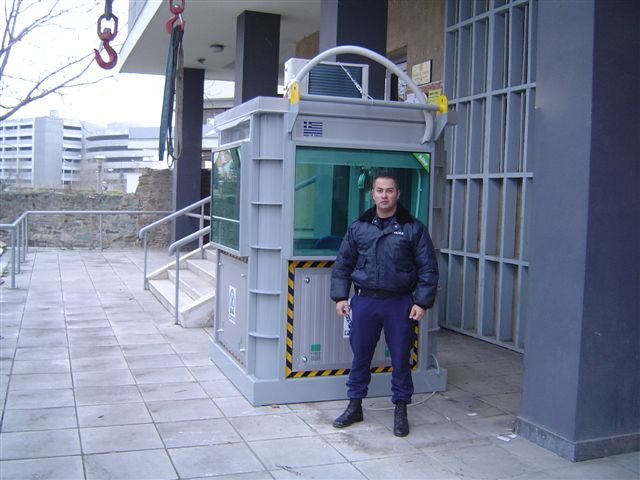 www.kibo.gr/www.alibaba.com/catalog/11575155/Kibo_Focus_Bulletproof_Shelters.html www.kibo.gr/www.alibaba.com/catalog/11575155/Kibo_Focus_Bulletproof_Shelters.html------------------------------------------------------------------------------------------------------------------------------- en.wikipedia.org/wiki/ELVO
ELVO
 photo:Leonidas 2. ELVO (standing for Elliniki Viomihania Ohimaton, English translation: Hellenic Vehicle Industry), is a Greek vehicle manufacturer based in Thessaloniki. Although it certainly is neither the oldest, nor the most "Greek" in its original technology (it was founded in 1972 after an agreement with Steyr-Daimler-Puch of Austria), it is one that managed to survive the evolutions that basically wiped out the Greek motor industry in the 1980s and 1990s, as it was the only state-owned company in its field. It started business as Steyr Hellas S.A. assembling and manufacturing trucks, motorbikes and farm tractors (Steyr and Puch models). Significant orders for trucks and buses by the Greek Army and state authorities soon gave momentum to the company (some say, at the expense of other manufacturers). The tractor division declined in the 1980s, as the company focused on military vehicles; in 1986 it changed its name to ELVO. The Greek company's first original designs were a 3-tonne truck in 1980 (not industrially produced) and a military bus (chassis and body) in 1981. In the same year it undertook the construction of "its own" Leonidas Armored Personnel Carrier (in fact Steyr’s 4K 7FA model built with minor modifications, again with progressively increasing local content). In 1987 ELVO introduced Leonidas-2, this time with significant modifications of its own. Hundreds were built, while a number of different versions were proposed. In the years that followed, ELVO became a major producer of military and civilian trucks for a variety of uses (all based on Steyr models), engines (Steyr types, many for export to the Austrian company itself), military jeeps (Mercedes-Benz G-Class under licence), customized vehicles and machinery, and buses, with significant exports. Production of buses usually involved body construction on imported chassis; only a few models actually included complete ELVO chassis design and construction, among them the Midas and Europe models of 1993, and a number of military bus types. ELVO-bodied Scania L113 buses exported to Trans-Island Bus Services, Singapore in 1996 were welcomed by that country’s press as the first low-floor buses in the wider region. A number of ambitious plans for company development and new products were not realized, as the state character of the company linked it to effects from government changes and mismanagement. Although it pulled out of a 1988 agreement with Steyr for an Armored Infantry Fighting Vehicle Development, ELVO rather surprised many in 1998, introducing a particularly advanced Armored Infantry Fighting Vehicle of its own design and development, named Kentaurus. However, the vehicle to this date has not been ordered by the Greek military due to reduced budgets. Another step towards original developments was its initiative for the creation of a light sports car, which was assigned to TWT (an engineering company created in Germany by Greek engineer Dimitris Vartziotis, with facilities in Germany and Greece). The prototype of the ELVO Aletis (meaning "tramp" in Greek), an attractive car designed by Pininfarina with Volkswagen engine, was introduced in the Internationale Automobil-Ausstellung in Frankfurt in 2001, but was never produced. In 2000, ELVO was partly privatised, when the Greek Mytilineos metal and engineering group acquired 43% and undertook the company management. The company faced severe financial problems due to reduced orders in 2009, after production (in cooperation with a number of Greek companies) of 140 Leopard 2 Hel MBTs under licence of Krauss-Maffei Wegmann (KMW), had been completed. It is understood that the management of the company reverted to the Greek state in 2010. The Greek state petitioned to put ELVO into receivership in January 2014. The plan under the receivership proposal was to split ELVO in two with a bad company carrying debts and obligations and a good company that it was hoped would be attractive to an external partner. By 2015, the company was in the process of being dissolved. However, in April 2015 the dissolution had been frozen as the Greek government sought to find a private buyer for the company, citing its strategic importance to the Greek defence industrial base. ------------------------------------------------------------------------------------------------------------------------------- en.wikipedia.org/wiki/Hellenic_Arms_Industry
EVO
 photo:Artemis 30. The Hellenic Arms Industry (Greek: Ελληνική Βιομηχανία Όπλων, Elliniki Viomichania Oplon, abbreviated EBO) has been the main arms manufacturer of Greece.Its creation is linked to a desire of Greek governments for "complete self-sufficiency" of Greece in the areas of personal and other weapons (in contrast to past experience when local manufacturers could only partially cover the needs of the Greek Armed Forces). A proposal in 1975 by a big Greek chemical company, Chropei of Piraeus, for the adoption of its own-developed rifles and submachine guns, was rejected after testing proved that its weapons were not up to desired standards. Similarly, the Greek state did not support Pyrkal, which was already producing the FN FAL rifle under license. Subsequently, EBO was founded by the state in Aigio in 1976, after an agreement to initially produce under licence Heckler & Koch models adopted by the Greek Army, but with the intent to also design arms of its own.During its foundation ceremony, a Greek pistol of the 1820s (used in the Greek Revolution) was placed on the foundation stone to represent the continuity of Greece's arms-making craft. Since that time, the company has grown by significantly acquiring other companies, and has produced in its several factories hundreds of thousands of rifles (military and civilian) and machine guns, as well as pistols, mortars, ammunition and explosives, rocket launchers, land mines, grenades, anti-aircraft weapons, various types of bombs, cannons, night vision equipment, aircraft metal parts, as well as specialized machinery, tools, uniforms, body armor vests and reinforced composite/plastics.Many of the above are of EBO's own development (and have included the founder and designer Anastasios Georgiou Artemis 30 Anti-Aircraft System and the Aris IV Anti-Tank Rocket).The company has also been a major and well-known exporter of weapons.However, its financial state has been shaky almost since its early steps. In 2004, it merged with Pyrkal, forming EAS, in an effort of the Greek state to better control and regulate this sector of the nation's defence industry.
---------------------------------------------------------------------------------------------------------------------------
EAV
Hellenic Aerospace Industry (HAI)
--------------------------------------------------------------------------------------------------------------------------
EODH: A new holistic approach for armoured vehicle protection
EODH New generation armour. Source: George Tsiboukis
The Greek company is providing enhanced survivability to new Leopard 2A7Vs and BOXER AIFV armored vehicles
EODH: Improving survivability
EODH is heavily involved in improving the survivability of current and future armoured vehicles. The Greek company has more than 15 years of experience in the sector, cultivating a successful track record and establishing itself in a leading position in the demanding international market for armour and protection systems for vehicle platforms.
RECOMMENDED: How is armoured vehicle survivability changing?
In 2018, the Macedonia-based company was selected to work with the German Ministry of Defence to improve 104 Leopard 2A7Vs. The programme aims to enhance survivability through armour packages, which will be applied to 68 Leopard 2A4s and 16 Leopard 2A6 vehicles, as well as for 20 newly built Leopard 2A7Vs.
Breakdown
The company was selected to produce and supply amour packages for:
• 68 Leopard 2A4
• 16 2A6
• 20 newly built Leopard 2A7V
In addition, EODH is playing a large role in the BOXER programme. The company is going to supply the armour for the BOXER wheeled armoured vehicles that will be produced for the German, Lithuanian, Dutch, Australian, Slovenian and British armies.
In addition to protection solutions for Leopard 1 and Leopard 2 MBT’s, and BOXER AIFV, EODH is also working on solutions for VAB APC, TAPV, LMV II, Leonidas I/II APC, M113 APC, EE-9 Cascavel.
Last of all, the Greek company is currently developing a new concept of 38-ton Heavy Armored Personnel Carrier (HAPC) based on the chassis of the Leopard 1 MBT, which can carry 10 people.
--------------------------------------------------------------------------------------------------------------------
Kioleides
 From Wikipedia, the free encyclopedia
N.Kioleides SA
Founded 1968
Founder Kioleides family
Headquarters Athens, Greece
Area served
North Europe (Greece)
Key people
Nikolaos Kioleides, Michael Kioleides
Services Trailer Manufacturer
|
|
|
|
Post by leandros nikon on Nov 14, 2007 10:44:41 GMT -5
11.Ben.wikipedia.org/wiki/Yiannis_BoutarisYiannis Boutaris
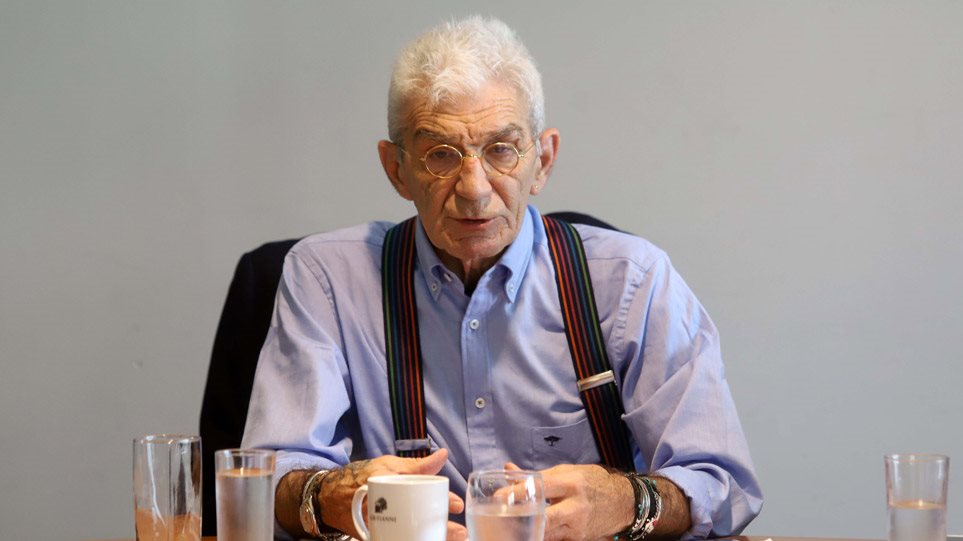
Yiannis Boutaris (born 6 January 1942) is a Greek businessman and politician, current mayor of Thessaloniki. He is the founder of KIR-YIANNI wine company, based in Naoussa and Amyndeo. He is one of the founding members of Drasi party and Arcturos ecological organization. Yiannis Boutaris was born in Thessaloniki in 1942. Son of the winemaker Stelios Boutaris and Fanny Vlachos, with a vlach origin. He was educated at the Experimental elementary school of the University of Thessaloniki and then at Anatolia College. He studied chemistry at the University of Thessaloniki. ------------------------------------------------------------------------------------------------------------------------------- www.thedrinkshop.com/products/nlpdetail.php?prodid=1671Kaloyannis brothersOuzo 12
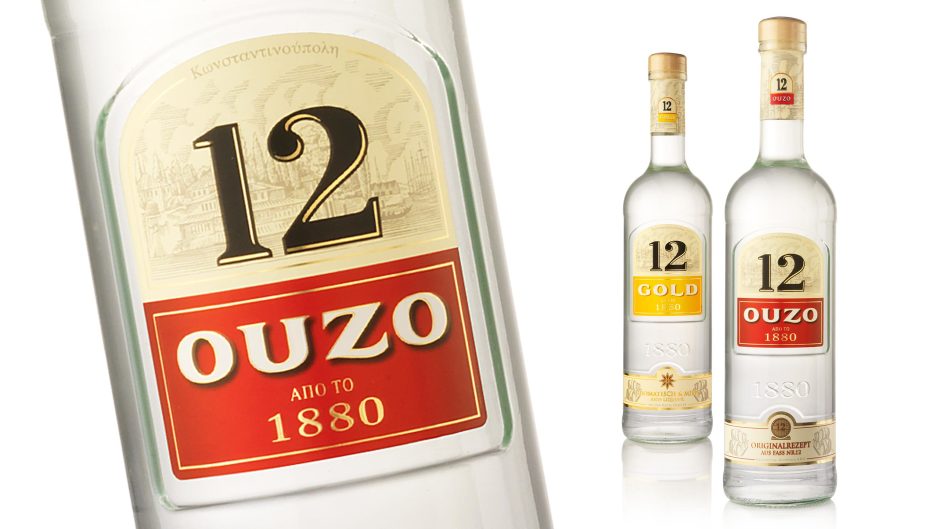 First produced in 1880 by the Kaloyannis brothers in Constantinople, the increasingly successful business moved to the Athenian port of Piraeus in 1919. The brothers produced various styles of ouzo, but the one preferred by connoisseurs came from barrel number 12. So, as the legend goes, No. 12 Ouzo was born. It became the best-known, top-selling ouzo brand in Greece and eventually the biggest and most famous ouzo around the world. Over the years Ouzo 12 has remained true to it's original recipe. The spirit's characteristic taste comes from carefully selected herbs and spices - aniseed, star anise, fennel, nutmeg, coriander, cinnamon and cardamom. These are distilled in traditional copper pot stills and the resulting liquid is placed in barrels to marry the complex flavours until they attain the full, distinctive taste for which Ouzo 12 is famous. Also,from wikipedia Ouzo effectWhen water or ice is added to ouzo, which is clear in color, it turns milky white; this is because anethole, the essential oil of anise, is soluble in alcohol but not in water. Diluting the spirit causes it to separate creating an emulsion, whose fine droplets scatter the light. This process is called louching, and is also found while preparing absinthe. -------------------------------------------------------------------------------------------------------------------------------
Spiros Metaxas
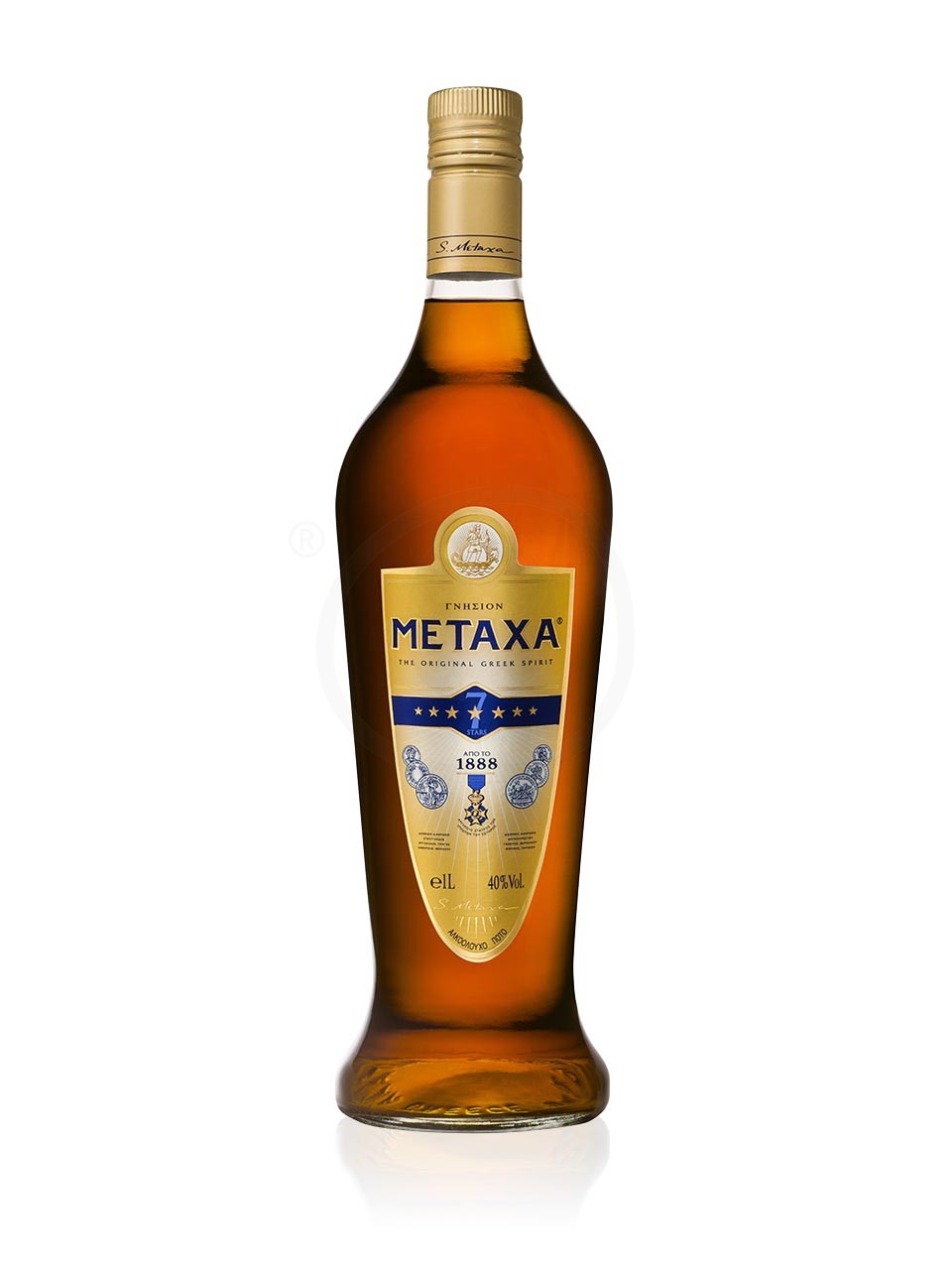
Metaxa is a Greek liqueur invented by Spyros Metaxa in 1888.
Metaxa is a blend of brandy and wine, additionally flavoured with a secret herbal mixture that includes rose leaves, and aged in oak casks. Metaxa is generally available in three versions: Three Star (at least three years old), Five Star (at least five years old), and Seven Star (at least seven years old). Even though it is classified as a brandy, Metaxa is really unique: it is smoother than a traditional brandy due to the use of Muscat wines, Mediterranean botanicals and rose petals. Metaxa is produced from Savatiano, Sultanina and Black Corinth, twice distilled, married with aged muscat wine from Samos and Lemnos, blended with a secret botanical mix and then aged in hand made limousine oak casks. In the Metaxa family the youngest is the 3 star and the oldest vintage is the Private Reserve. ................................................................................................................ www.yellow-net.com/metaxa.htmMetaxa a very special Greek spirit invented by Spyros Metaxas in 1888 in Attica region, the province of Athens. Since then, the product has earned world wide recognition for its quality, color and taste. Metaxa Brandy has been marketed world-wide and became famous creating a very large number of dedicated lovers. Many call it "The Elixir of Life", "The Nectar of the Gods", "The Blessed Spirit" ! Some types of Metaxa are very difficult to find or are found only at selected shops around the world. A few of them are: Metaxa Centenary, Metaxa Rhodes, Metaxa Golden Reserve, Metaxa Grand Olympian Reserve, and Metaxa Golden Age. All these types were bottled on special occasions from selected old oak barrels that are kept in Metaxa storage facilities. Metaxa has become one of the most well recognised brands in the world. ------------------------------------------------------------------------------------------------------------------------------ greece.greekreporter.com/2012/01/05/new-trade-agreement-brings-greek-wine-to-china/
VAENI wines
 New Trade Agreement Brings Greek Wine To China New Trade Agreement Brings Greek Wine To China
By Stella Tsolakidou The biggest wine trade deal ever signed between Greece and China is now officially confirmed. Greece will be exporting up to 3.600.000 bottles of wine per year after the cooperative wine production association VAENI Naousa signed the deal. According to a Kathimerini daily report, the members of the VAENI association sent their first samples of wine to China in the summer of 2012, a sample which included some 260.000 bottles of the finest Greek wines. The deal was officially signed in October, and covers the export of 300 containers of wine per year for a period of 10 years, a value estimated to be worth millions of euros. Mr. George Fountoulis, the president of the cooperative wine production association of Naousa, said that this deal will give a newly elevated status to the wine production zone of Naousa and the general Naousa region. “We hope we will be able to gradually absorb the production of the broader region. Maybe even of other prefectures across Greece” added Mr. Fountoulis. VAENI is expected to expand its exporting activities to other Greek products, such as olive oil, given the fact that China shows a strong interest in Greek traditional products.
------------------------------------------------------------------------------------------------------------------------------Koutsianas/Apivita
www.apivita.comIn 1972, the founders of APIVITA, Nikos and Niki Koutsiana, two young pharmacists, were inspired by the honeybee society, the unique biodiversity of Greek nature and the holistic approach of Hippocrates to health, beauty and well-being, and together they created their first natural cosmetics, using beekeeping products and herb extracts. A few years later, in 1979, they created APIVITA. The name is derived from the Latin words Apis (bee) and Vita (life), and means “life of the bee” – a name reflecting the philosophy of a company that, being a living organism like the bee, never stops creating value: Value for society, for the natural environment and for the economy. Today, APIVITA is a company with a strong philosophy, values, social responsibility, heritage and an innovative outlook. It has evolved into a vast universe of people, products, aims, values, dreams and new endeavors, which ensure its ongoing development. APIVITA has developed and established over 300 natural, effective and holistic products for the face, body and hair, formulated with beekeeping products of high nutritional value, extracts of Greek herbs and pure essential oils, as well as many green innovations and patents. APIVITA is a way of life: a life shared with employees in Greece and abroad, suppliers, beekeepers and cultivators, university teachers and researchers, pharmacists and customers throughout the world. The passion and vision of APIVITA are today embraced by consumers in 15 countries: Spain, Japan, Hong Kong, the USA, Cyprus, Ukraine, Romania, Bulgaria, Belgium and the Netherlands, etc. ................................................... www.apivita.com/hippocrates_gardenHippocrates Botanical Garden Social responsibility is rooted deep into APIVITA’s DNA. The creation and maintenance of the Hippocrates Botanical Garden on the island of Kos is an integral part of our activities in this respect. Covering an area of 1.2 acres, the Hippocrates Botanical Garden of Kos was established at the Hippocratic Melathron, in Platani, Kos, where the International Hippocratic Foundation is based, and is adjacent to the archaeological site of the Asclepieion. The creation of the garden involved planting around 250 plants known to have been used by Hippocrates in his medical practice. “Hippocrates 2500 years”, an NGO, ensures the garden’s sustainability and promotes research, study and public awareness of Hippocrates’ work. Nowadays, the work of the “Father of Medicine” is acknowledged and studied globally. It is really remarkable that today we use the same herbs and plants that Hippocrates used, and still benefit from their therapeutic, aromatic and cosmetic properties. Hippocrates’ Hypericum or St. John’s Wort is popular for its anti-inflammatory and healing action; Dittany acts as a tonic or stimulant and is suitable for gynecological disorders; the celebrated Willow – provides the raw material for aspirin; Mandrake, known for its mild anti-depressant effects; Cistus and Chaste tree and Ivy, plants that are very popular for their healing properties. The “Hippocrates Garden” is a long-term commitment for APIVITA. Work began there at the end of 2006 and the main objective was to create a microcosm of the environment in which Hippocrates lived and worked. Landscaping architects designed the paths taking care not to upset the natural beauty of the local environment. Planting grounds for each group of plants are next to the paths. Signs give information about each plant’s Latin and common Greek names, as well as its name and therapeutic properties according to Hippocrates. The aims of the program include the establishment of an international research center for Hippocratic plants within the grounds of the Hippocrates Botanical Garden. This center will study the active ingredients, properties and uses of the plants in order to identify medicinal or cosmetic properties that can be used in the development of new medicines, functional foods and cosmetics. The ultimate objective is the creation of a social, environmental and cultural work that will form a valuable endowment for future generations worldwide. For us, at APIVITA, the Hippocrates Botanical Garden of Kos is a tribute to the father of Medicine, our constant and greatest source of inspiration. ------------------------------------------------------------------------------------------------------------------------------- www.ekathimerini.com/4dcgi/_w_articles_civ_3158488_05/09/2003_33747Korres : A Greek brand goes to London  Maverick cosmetics company Korres opens its first freestanding store in the UK capital The first Korres Natural Products independent outlet in London was designed by Wells Mackereth Architects. ELIS KISS Global brand names usually come to Greece — not the other way round. A maverick local company, however, is rapidly becoming the cool new kid on the international natural cosmetics block. Korres Natural Products opened its first freestanding store on London’s King’s Road in May. Designed by Wells Mackereth Architects, the outlet features white ceramic and timber — in tune with the Korres philosophy of nature meets science. The expansion is telling of the Greek company’s success abroad, particularly in Britain, where products are also available at Harvey Nichols, Selfridges, The Conran Shop, Liberty and Pure Beauty stores. In France, Korres cosmetics are available at Le Bon Marche, Galeries Lafayette, Sephora and The Conran Shop, while the company has also entered the Italian, Hong Kong, Kuwaiti and Singapore markets. In Greece, the products are available in more than 3,000 pharmacies around the country. Born in Athens in 1965, Giorgos Korres graduated from the Athens School of Pharmacy before taking the helm of the capital’s oldest homeopathic pharmacy, where he began experimenting with natural ingredients. As his involvement with the earth’s natural gifts grew, so did public demand, prompting the young pharmacist to develop his own concoctions. Korres Natural Products was established in 1996, specializing in two major areas: homeopathic remedies and natural cosmetics. Today, the company also collaborates with the University of Athens on various programs regarding the development of Greek herbs. Besides the dynamic developments in London, the company is also excited about a new range of facial care products, recently unveiled in Athens. Given the Korres commitment to the use of herbal active ingredients — and following extensive research — the company has come up with a range of products that avoid the use of specific synthetic compounds — these usually make up 30 to 60 percent of cosmetic formulas. The new Korres skincare line is therefore proud to announce that the products are free of mineral oil (a petroleum derivative), propylene glycol (a solvent for plant extracts linked to various allergies) and silicone (used in cosmetics due to smooth texture qualities, but not biodegradable). The above have now been replaced by naturally derived ingredients, such as vegetable oil combinations, and complemented by active plant extracts. Among others, the new range of products include White Tea facial gel cleanser; Orange and Hamamelis face waters; Pomegranate moisturizer for oily and combination skin; Yellow Hibiscus, a concentrated eye serum against puffiness and dark circles; Iris Florentina, a firming and restructuring face cream; Passion Flower, a firming and line-smoothing neck cream; Sugar Crystal cream, a multivitamin skin shield; as well as two mattifiers, a Grapefruit mattifying lotion and a Lemon anti-shine gel. There are also surprising choices, such as a new, no-foam Absinthe shaving cream for men. Besides all the new products, there are also a number of established ones which have been revised. These include the Wild Rose 24-hour moisturizer for normal and dry skin as well as Borage, an anti-shine moisturizer for men. ------------------------------------------------------------------------------------------------------------------------------- Dimitris Koutsolioutsos/Folli Folliewww.follifollie.comFolli Follie is a Greek company which designs, manufactures and distributes jewellery, watches and fashion accessories under the Folli Follie brand. The Folli Follie brand's core values are "affordable, fashionable luxury". Folli Follie has a presence in 20 countries with over 280 points of sale, including shops in the most fashionable streets of the world's major cosmopolitan cities such as London, Tokyo, Paris, Hawaii, Hong Kong, New York, Athens, Shanghai and Seoul. Folli Follie products are sold through retail standalone shops such as Rue Royale in Paris, New Bond Street in London, Ginza in Tokyo and Central in Hong Kong. Furthermore, one can find Folli Follie products in department stores such as Galleries Lafayette in France, Isetan and Takashimaya in Japan and Corte Ingles in Spain. In 2003 Folli Follie bought a 40% share of the Hellenic (Greek) Duty Free Shops in cooperation with GERMANOS Group of Companies, thus entering into a very promising sales segment. The company has, thus, acquired a strong presence in the duty free and travel retail sector, with points of sale in the airports of Athens, Vancouver, Seoul and many more. In addition, Folli Follie products are also available in flight in major international airlines such as British Airways, KLM, Cathay Pacific, Korean Airlines, Japan Airlines and so forth. Today,the company owns 52 shops in China!!! ------------------------------------------------------------------------------------------------------------------------------- www.tresor.gr/ilias.htmElias Lalaounis
 Ilias Lalaounis, a fourth generation jeweler, has become renowned for creating luxurious gold jewelry steeped in history. Lalaounis creations represent a synthesis of past and present, a unique interpretation of ancient civilisation or culture translated into a modern idiom. Influences as diverse as the Neolithic age, Mycenaean art, the Byzantine era, pre-Columbian architecture as well as science and nature, have all inspired the Lalaounis collections. Age-old techniques such as granulation, filigree, hand-hammering and repousse are used in creating the exquisite and distinctive hand-crafted Lalaounis jewelry which keeps alive and renewes a 4,000 year old tradition in Greek art. Besides the shops in Greece,the firm also owns shops in New York,London,Paris,Geneva,Zurich and Tokyo. ------------------------------------------------------------------------------------------------------------------------------- Vangelis Koultsiakis and Michalis ZouloumidisProducers of Spirulina tabletsNigrita,N.Greece en.wikipedia.org/wiki/Spirulina_(dietary_supplement)Spirulina is the common name for human and animal food supplements produced primarily from two species of cyanobacteria: Arthrospira platensis, and Arthrospira maxima. These and other Arthrospira species were once classified in the genus Spirulina. Protein Spirulina contains an unusually high amount of protein, between 55% and 77% by dry weight, depending upon the source. Essential fatty acids Spirulina is rich in gamma-linolenic acid (GLA), and also provides alpha-linolenic acid (ALA), linoleic acid (LA), stearidonic acid (SDA), eicosapentaenoic acid (EPA), docosahexaenoic acid (DHA), and arachidonic acid (AA). Vitamins Spirulina contains vitamin B1 (thiamine), B2 (riboflavin), B3 (nicotinamide), B6 (pyridoxine), B9 (folic acid), vitamin C, vitamin D, and vitamin E. B12 The bioavailability of vitamin B12 in Spirulina is in dispute. Several biological assays have been used to test for the presence of vitamin B12.The American Dietetic Association and Dietitians of Canada in their position paper on vegetarian diets state that spirulina can not be counted on as a reliable source of active vitamin B12. Minerals Spirulina is a rich source of potassium, and also contains calcium, chromium, copper, iron, magnesium, manganese, phosphorus, selenium, sodium, and zinc. ------------------------------------------------------------------------------------------------------------------------------- www.huffingtonpost.com/2009/03/08/greek-cigars-remain-local_n_172932.htmlLazaros Tsouvelakidis/Domenico Greek Cigars
DOMENICO, Greece — Greek households are cutting expenses and spending less time at restaurants or hair salons. But one local luxury is defying the downturn: cigars. Business is good at Domenico Cigars, a tiny factory in central Greece that got its cigar seeds and secrets from Cuba. Greece's unlikely cigar industry started five years ago in a valley 185 miles northwest of Athens, where conditions are ideally hot and damp. Last year set a record for output _ still a modest 70,000 cigars. "Cuban tobacco varieties responded well in this area. The leaves are thin, they burn well and have a good aroma _ all good characteristics," he said. "The climate is damp and the soil is also similar, reddish." Lazaros Tsouvelakidis, in charge of blends at Domenico, said buyers are lured initially by curiosity and the relatively low price. The cigars cost $5 each, about the same as machine-made imports and about half the price of Cuba's hand-rolled cigars. Tsouvelakidis and local Greek officials traveled to Cuba in 2003, after farmers grew tired of a price slump in cigarette tobacco. They went on tours of cigar-rolling factories and tobacco plantations. "No one showed us anything," Tsouvelakidis said, remembering one tour where visitors were banned from taking notes. "We weren't allowed to take notes, so we wrote them up on notepads at night at our hotel. We wrote everything down." -------------------------------------------------------------------------------------------------------------------------------
Gavrilos Tsagaris
Gabriel drums,greek handmade drums.www.gabrieldrums.com ------------------------------------------------------------------------------------------------------------------------------- www.emportal.rs/en/news/region/84468.html
Eleftherios Mamatzis/Stelma
Greek Stelma S.A. to paint Eiffel Tower for 120th 'birthday' 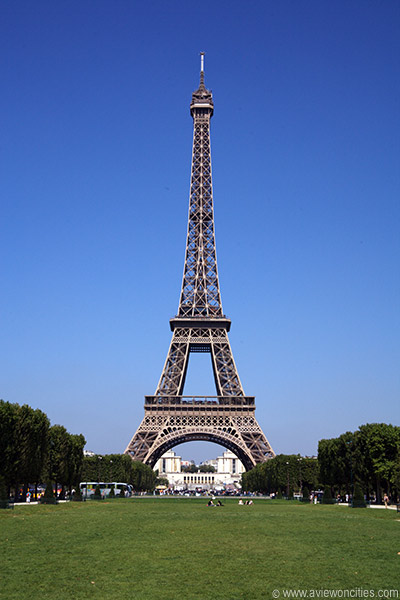 STELMA founder and president Eleftherios Mamatzis and his son, company vice president Dimitris Mamatzis, expressed their joy at being assigned the prestigious project, calling it "a life's dream". Sixty tons of paint are necessary to cover the Tower's surface, which is expected to require at least 20 months, depending on the weather, while the Tower will be painted going from top to bottom, with 16 painters starting off at the initial stage, while another 10 painters will join them at the base. The Tower will be painted in three gradated shades of bronze, going from the lightest shade at the top, while the darkest shade will begin from the base, going up to the first 56 meters. The cost of the project is estimated at 4.5 million euros without VAT. An estimated 60 tons of paint will be required to cover the Tower's 250,000 square meter surface, as well as 50 kilometers of security cords for the workers' safety, 2 acres of protective netting, 5,000 sanding discs, 1,500 paint brushes, an equal number of sets of workclothes and 1,000 pairs of leather gloves. All the work will be carried out by hand using only paint brushes ------------------------------------------------------------------------------------------------------------------------------- ION chocolate

en.wikipedia.org/wiki/Ion_(chocolate) From Wikipedia, the free encyclopedia Type Incorporated Industry Chocolatier Founded 1930 Headquarters Athens, Greece Products Chocolates Employees 1080 (2005) Website www.ion.gr/en Ion is a Greek chocolate brand. Although the first chocolate recipe has been manufactured since 1927, the company was formally incorporated in 1930.The main factory is located in Athens. Over the years, Ion introduced other chocolate varieties confectionery products such as croissants and spreadable chocolate. However, it is best known for its almond milk chocolate variety. The company has grown to be one of Greece’s 50 largest companies with annual sales of over €100 million. -------------------------------------------------------------------------------------------------------------------------------
Pavlidis chocolates
-------------------------------------------------------------------------------------------------------------------------------
exportleaders.gr/en/component/k2/item/30-bic-violex.html Politis family/BIC Violex S.A.  The major Greek exporter who innovates on a “personal level” ---------------------------------------------------------------------------------------------------------------------------
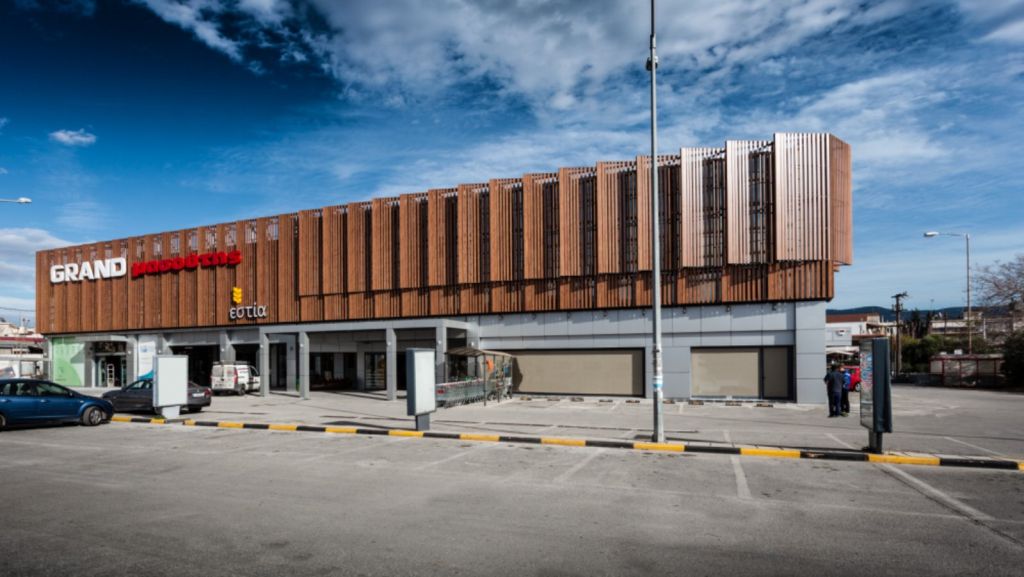
Masoutis (Greek: Μασούτης) is a supermarket chain in Greece. Its headquarters are located in Thessaloniki. The company was established in 1976 by Diamantis Masoutis, its current owner, and the first Masoutis supermarket opened the same year in Thessaloniki city center. Masoutis is the largest regional retail grocery chain in Greece, and the seventh largest supermarket chain in Greece in terms of market share. As of 2010, the company had 193 retail and 17 cash-and-carry stores, all located in Northern Greece and Northeastern Aegean. The company has no plans to expand into Southern Greece or the Greek islands.
---------------------------------------------------------------------------------------------------------------------
Papoutsanis soap and cosmetics

----------------------------------------------------------------------------------------------------------------
--------------------------------------------------------------------------------------------------------------------
Christos Lambrakis
From Wikipedia, the free encyclopedia
Christos Dimitrios Lambrakis is the owner of Lambrakis Press Group (DOL), one of the largest newspaper groups in Greece.
He was born in Athens. From 1954 to 1957 he worked as a journalist at the To Vima newspaper and was editor of the weekly magazine Tachydromos. In 1957 he took over management of Lambrakis Press. Since 1970, when Lambrakis Press became a limited company, he has been chairman of the board.
He is also President of the Lambrakis Research Foundation, and of the "Friends of Music" Society, the sponsors of the Athens Concert Hall main hall.
-------------------------------------------------------------------------------------------------------------------------
Vivartia
|
|
|
|
Post by leandros nikon on Nov 14, 2007 10:45:08 GMT -5
11.C Businessmen of our diaspora.Bulgari familyTaken from the Bvlgari.com website The Bulgaris descend from an ancient family of Greek silversmiths whose activity began in the small village of Epirus, where Sotirio, the founder of the family, made precious objects in silver. In the mid-19th century Sotirio emigrated to Italy where in 1884 he opened his first shop in via Sistina in Rome. With the help of his sons Costantino and Giorgio, in 1905 he inaugurated the shop in via Condotti, which still today is Bvlgari's flagship store. Pay a virtual visit inside the Bvlgari flagship store in Rome, Via Condotti. During the first decades of the 20th century, the two brothers developed a passionate interest in precious stones and jewels, gradually taking over their father's role. During the 50's Bvlgari moves away from the strict disciplines of the dominant French school to create its own unique style. The 1970's mark the beginning of Bvlgari's international expansion with the opening of their first overseas store in New York, and in Paris, Geneva, and Monte Carlo. In the early 1990's, Bvlgari Parfums is established in Switzerland marking the Group's entry in the high-class perfume market. The Bulgaris descend from an ancient family of Greek silversmiths whose activity began in the small village of Epirus, where Sotirio, the founder of the family, made precious objects in silver. In the mid-19th century Sotirio emigrated to Italy where in 1884 he opened his first shop in via Sistina in Rome. With the help of his sons Costantino and Giorgio, in 1905 he inaugurated the shop in via Condotti, which still today is Bvlgari's flagship store. Pay a virtual visit inside the Bvlgari flagship store in Rome, Via Condotti. During the first decades of the 20th century, the two brothers developed a passionate interest in precious stones and jewels, gradually taking over their father's role. During the 50's Bvlgari moves away from the strict disciplines of the dominant French school to create its own unique style. The 1970's mark the beginning of Bvlgari's international expansion with the opening of their first overseas store in New York, and in Paris, Geneva, and Monte Carlo. On July 17th ,1995 the Bvlgari Holding Company S.p.A. is quoted on the Italian Stock Exchange Telematic system and the International SEAQ in London. In 1997 Bvlgari introduces its first collection of silk scarves, characterized by an original design and top quality manufacturing. The first collection of Leather bags and Eyewear are launched in 1998, while table and giftware complete Bvlgari's diversification program in 1999. Today, Paolo Bulgari and Nicola Bulgari, respectively Chairman and Vice-Chairman, together with their nephew Francesco Trapani, Chief Executive Officer, manage the company's development with the intent of better serving an international market, while remaining fine and prestigious jewelers. ------------------------------------------------------------------------------------------------------------------------------------------------
Alexander PantagesAlexander Pantages (1867- February 17, 1936) was an American vaudeville and early motion picture producer and impresario who created a large and powerful circuit of theatres across the western United States and Canada.Born Pericles Pantages on the Greek island of Andros, he ran away from home and went to sea at the age of nine, spending the next 12 years working on merchant ships all over the world. He left the sea in San Francisco in 1897 and made his way from there to Canada's Yukon Territory during the great Klond**e gold rush. He eventually found himself in the mining boom-town of Dawson City, where he became business partner (and possibly lover) to the saloon and brothel-keeper "Klond**e Kate" Rockwell, operating a small, but highly successful vaudeville and burlesque theatre, the Orpheum. In 1902, Pantages left Dawson and moved to Seattle, Washington, where he opened the Crystal Theater, a vaudeville house of his own. That same year, he married a Seattle girl named Lois Mendenhall. Klond**e Kate filed a breach-of-promise suit against him (settled out of court) and later wrote that he had stolen from her the money with which he purchased the Crystal. In 1904, Pantages opened a second Seattle theatre, the Pantages. By 1920, he was owner of more than 30 vaudeville theatres and controlled, through management contracts, perhaps 60 more, in both the United States and Canada. These theatres formed the "Pantages Circuit", a chain of theatres into which he could book and rotate touring acts on long-term contracts. The starting point of the Pantages Circuit was the city of Winnipeg, Manitoba, where Pantages built the Pantages Playhouse in 1914. All Pantages tours originated in Winnipeg and moved from there around the circuit of theatres. If an act died in Winnipeg it would not go on the road. While the majority of "his" theatres were owned by others and managed by Pantages, he became, from 1911 on, a builder of theatres all over the western U.S. and Canada. His favoured architect in these ventures was B. Marcus Priteca (1881-1971), of Seattle, who regularly worked with muralist Anthony Heinsbergen. Priteca devised an exotic, neo-classical style that his employer called "Pantages Greek". Around 1920, Pantages entered into partnership with the motion picture distributor Famous Players, a subsidiary of film producer Paramount Pictures, and began converting his theatres into "combo" houses, designed to exhibit films as well as staging live vaudeville. Throughout the 1920s, the Pantages Circuit dominated the vaudeville and motion picture market in North America west of the Mississippi River. Pantages was effectively blocked from expansion into the eastern market by the dominant, New York-based Keith-Albee-Orpheum Circuit (KAO). In the late 1920s, with the looming advent of talking pictures, David Sarnoff and Joseph P. Kennedy, the principals of the Radio Corporation of America (RCA), which held a number of patents in film/sound technology, established the film production company Radio Pictures and moved to acquire control of the KAO theatres through quiet purchases of the company's stock. In 1927, Kennedy and Sarnoff were successful in gaining control of KAO, and, in 1928, changed the name of the company to Radio Keith Orpheum (RKO). They then approached Alexander Pantages with an offer to purchase his entire chain. Pantages rejected the offer. In 1929, Alexander Pantages was arrested and charged with the rape of a 17-year-old would-be vaudeville dancer named Eunice Pringle. Miss Pringle, then an usherette in one of his theatres, alleged that Pantages had attacked her in the broom closet of his Hollywood office after inviting her in to audition. Pantages was tried and convicted and sentenced to 50 years in prison. Pantages then engaged the young attorney Jerry Geisler (later to become famous as Hollywood's leading divorce lawyer) and San Francisco lawyer Jake Ehrlich, later to become a famous attorney in his own right, to file an appeal on his behalf. Geisler successfully petitioned for a new trial, basing his argument on the original trial judge's exclusion of testimony relating to Eunice Pringle's moral character. Geisler triumphed in the second trial, picturing the alleged victim as a woman of low morals, theatrically demonstrating how impractical was a rape in Pantages' broom closet and planting in the jurors' minds the suggestion that Miss Pringle might have been paid by business rivals to frame his client. Although Pantages was acquitted, the trials ruined him financially and may have broken him in both health and spirit. He sold the theatre chain to RKO for a lower sum than that originally offered - far less than what his "Pantages Greek" vaudeville palaces had cost him to build - and went into retirement. Alexander Pantages died in 1936 and was interred in the Great Mausoleum, Sanctuary of Benediction, in the Forest Lawn Memorial Park in Glendale, California. The rumour, begun at the second trial, that RKO paid Eunice Pringle to frame Alexander Pantages, was revived in Ronald Kessler's biography of Joseph Kennedy "The Sins of the Father: Joseph P. Kennedy and the Dynasty He Founded" (New York: Warner Books, 1997). There is only anecdotal evidence, however, to support this claim. Retrieved from "http://en.wikipedia.org/ " -------------------------------------------------------------------------------------------------------------------------------------------------- Leonidas Kestekides/Leonidas pralinesLeonidas pralines is a famous belgian product...what i did not know was that the founder was a Greek!www.leonidas-en-ligne.com/boutique_us/liste_produits.cfm?code_lg=lg_us&type=55 Leonidas Daskalides From Wikipedia, the free encyclopedia Leonidas Daskalides or Leonidas Kestekides (1876 - 1954) was a Greek chocolate manufacturer, founder of the internationally famous Leonidas company in Belgium. The company's primary focus is pralines (chocolate shells with soft fillings), but they also sell marzipan, solid chocolates, and other confectionary. Daskalidès was born in Nigde in Cappadocia (modern day Turkey). Accounts of his early years vary, but it appears that he left Constantinople (now Istanbul), lived in Greece for a while and then went to Italy, where he became a wine merchant. He struggled financially, so he decided to move to New York, where he lived from 1893-98 and worked as a confectioner. He lived in Paris from 1898-1908. In 1910, he travelled to Belgium to attend the 1910 World Fair in Brussels as a member of the Greek delegation from the United States. He was awarded the bronze medal for his chocolate confectionery, and the gold medal for his patisserie. He returned to Belgium in 1913, attended the World Fair in Ghent, and moved permanently to Belgium. Daskalidès met a young woman from Brussels during his visit, and settled permanently in Belgium. He opened tea-rooms in Brussels, Ghent and Blankenberge, and the business expanded from there. ------------------------------------------------------------------------------------------------------------------------------------------------- Sir Stelios Haji-Ioannou/easy jetwww.stelios.com/stelios/biography.htmlSir Stelios Haji-Ioannou is best known for creating easyJet in 1995, at the age of 28. Prior to founding the low-cost airline that revolutionized European air travel, Stelios created Stelmar, a shipping company which was floated on the New York Stock Exchange in 2001 and subsequently sold to a rival in 2005. True to his beliefs in serial entrepreneurship, Stelios consolidated the ownership of the easy brand into his private company, easyGroup, comprising several easy-branded businesses - all dedicated to offering consumers more value for less. At the age of 39, Stelios received a knighthood from Queen Elizabeth II for services to entrepreneurship. More recently, he has expanded his dedication to making a difference to society by launching a number of philanthropic initiatives supporting entrepreneurship, higher education and environmental sustainability. More likely to be on an aircraft than in an office, Stelios is 42 years old and lives in Monaco. --------------------------------------------------------------------------------------------------------------------------------------------------- wikipedia Leo Stefanos/DOVEBARLeo Stefanos was born in Greece, was the inventor of the DOVEBAR®.He created the Dove Bar to appeal to many people in America's taste for chocolate and ice cream. Leo Stefanos was a first generation Greek-American, arriving in New York and eventually settling in Chicago's South side to raise a family which included two young sons. The idea for the confection arose in the mid 1950's when one day Leo saw his young son, Mike, racing recklessly down the street in pursuit of the neighborhood ice cream truck. Leo knew that was dangerous and decided to make his own ice cream bar in hopes of keeping Mike and his brother closer to home. Since he owned a candy shop that also sold ice cream, he came up with the idea of developing his own ice cream treat. He spent months in his small candy store's back room located on Chicago’s South Side, developing his own brand by cutting a few blocks of his best ice cream, which he then dipped into rich chocolate which eventually became a popular item at the Dove Candy shop. Before long, the DOVEBAR® began to get attention from local people. Mike grew up, earned a CPA degree, and then joined his father in the candy shop in 1977. After Leo died, Mike took over the store, and the popularity of the DOVEBAR began to spread beyond Chicago. Over one million of the frozen treats were sold by street vendors that first year. Later Years Mike Stefanos began to think of ways to expand the family business and introduced DoveBars to specialty stores and country clubs in the Chicago area. In 1984 he presented the DoveBar at the Fancy Food Show in Washington, D.C., and began to receive orders from around the country. Since then similar products have been sold for years, but Mike has continued to make DoveBars in the same way that his father had in the past. In 1985, the DOVEBAR company was bought by Mars, Incorporated, makers of products such as M&M'S Chocolate Candies and SNICKERS Bar. DOVE Chocolate, inspired by the chocolate on the original DOVEBAR introduced by Stefanos decades earlier, was introduced nationally in 1990. Today Dove Bars are available in over 30 countries around the world. ----------------------------------------------------------------------------------------------------------------------------------------------- Andrew Georgiouwww.only.co.uk/news/# Young Entrepreneur of the Year - 9/2/07 Only Group Founder and Director, Mr Andrew Georgiou, has been elected as a final candidate for the Young Entrepreneur of the Year Award for 2006. More Nominations were announced on the 17th February and the final decision to be unveiled at the Sharp Edge Awards, hosted by Duncan Bannatyne OBE, on Monday the 19th of February. Andrew is one of three candidates to make it into the finals to be judged by a leading panel of entrepreneurs, investors and experts. The awards were designed to celebrate entrepreneurial excellence and to bring together the UK's most dynamic and innovative businesses. www.thesharpedge.biz------------------------------------------------------------------------------------------------------------------------------------------------ www.hellenism.net/cgi-bin/display_celeb.html?c=40Peter Karmanos CEO compuware,owner of carolina hurricanes,billionaire philanthropistKarmanos, Peter Born: 1940's Software magnate, Owner of the NHL's Carolina Hurricane Peter Karmanos holds a triple role as the Owner of the Plymouth Whalers, Chief Executive Officer/Governor of the National Hockey League Carolina Hurricanes (formerly Hartford Whalers) and Corporate Chairman and Chief Executive Officer of Compuware in Farmington Hills, Michigan. Along with partner Thomas Thewes, Karmanos founded the first American-based Ontario Hockey League team in 1989, known then as the Detroit Compuware Ambassadors. Entering its eleventh season and now called the Plymouth Whalers, Karmanos? OHL franchise has captured a league championship, a Memorial Cup berth and five Division titles. To date, 18 players have been selected in the top three rounds of the NHL entry draft, including five first-round picks. Among them include Pat Peake (Washington Capitals), Todd Harvey (Dallas Stars - NHL Rookie of the Year), Bryan Berard (New York Islanders), David Legwand (Nashville Predators), Justin Williams (Carolina Hurricanes) and more recently Stephen Weiss (Florida Panthers). The same competitive spirit which led to Karmanos' success as an entrepreneur also fuels his sponsorship of youth hockey programs in Michigan. Under his guidance, Karmanos' youth hockey teams have accumulated numerous state, national and international tournaments. While junior and midget teams are the focal points of Karmanos? commitment to hockey, countless youth hockey programs benefit each season through the efforts and contributions of the Plymouth Whalers, Carolina Hurricanes and Compuware. Mr. Karmanos, a graduate of Wayne State University, founded Compuware with two partners and tax return money in 1973. He resides in Michigan. Karmanos has three sons, Peter III, Nick and Jason. ---------------------------------------------------------------------------------------------------------------------------------------------- en.wikipedia.org/wiki/William_TavoulareasTavoulareas, William PeterPresident of Mobil Oil Corporation The son of a greek-Italian butcher from Brooklyn, whose name few oilmen could pronounce, 'Tav' was already a phenomenon within Mobil. He was a lawyer-accountant, irreverent, fast-talking numbers-man who had the crucial Rockefeller talent for lightning mental arithmetic. Like other Greeks in the oil business he had an instinctive global awareness. (The Greeks had traditionally been the diplomats in the old Ottoman Empire, dealing with Arabs on behalf of their Turks.)[1] Tav was a forthright Brooklyn boy, outspoken and impatient with the slow style of the company. As Mobil became more dependent on the Middle East consortia, particularly Aramco, so Warner decided that there was only one man in Mobil who could really understand the accounting well enough to hold his own with the Exxon expert, Howard Page: he thus promoted Tavoulareas to be Middle East negotiator. Tav would then explain to his Mobil colleagues, when battling with Exxon: 'this is what they want, this is how they'll try to get it, and this is how we'll stop them'; and he did. Tavoulareas is now widely regarded as the ablest of the major oilmen. He sits in shirt-sleeves, talking at top speed, blinking, twitching and staring, running to the telephone like an imp let loose; saying gimme and lemme, whadda ya want. In the Middle East, Tav was determined to increase Mobil's share, and was much more prepared to consider new partnership arrangements, which antagonised the other sisters, but also brought him closer to the producers; and he formed a close friendship with Yamani in Saudi Arabia. Tavoulareas was also the recipient the AHEPA Award, the prestigious awards to recognize members of the community for their contributions and achievements in their chosen field of endeavor. --------------------------------------------------------------------------------------------------------------------------------------------------
Peter AngelosPresident and Managing Principal, Law Offices of Peter G. Angelos Nickname:The Greek Tycoon.Power Play: Hometown muscle behind city’s most daring redevelopment project since the Inner Harbor. Power Source: Superlawyer from the streets of Highlandtown parlayed one of the nation’s largest class action lawsuits into a financial empire. High-profile owner of the Baltimore Orioles has his fingers in virtually every pie in the city—the biggest of which is his massive West Side redevelopment venture. He’s unfailingly charitable—he was Maryland’s first million-dollar donor to the United Way. And even when he loses, he wins: He “settled” for $150 million (instead of $1 billion) in fees for his work on behalf of Maryland in the national tobacco suit. Bottom Line: A brilliant legal mind, a street fighter’s moxie, a bottomless war chest, and a desire to recreate the vibrant downtown of his youth makes Angelos the most important man in the city. --------------------------------------------------------------------------------------------------------------------------------------------------- John A. Catsimatidisen.wikipedia.org/wiki/John_CatsimatidisJohn Catsimatidis is the owner, president, chairman, and CEO of the Red Apple Group and Gristedes Foods. He is also the chairman and CEO of the Red Apple Group subsidiary United Refining Company. The Red Apple Group also has holdings in aviation and real estate interests in New York, Florida, and the U.S Virgin Islands. He owns and operates the Hellenic Times newpaper. John Catsimatidis has also received an Ellis Island Medal of Honor.www.forbes.com/lists/2007/54/richlist07_John-Catsimatidis_76JT.html#220 John Catsimatidis------------------------------------------------------------------------------------------------------------------------------------------------ en.wikipedia.org/wiki/Mike_LazaridisMike Lazaridis/BLACKBERRYMihalis "Mike" Lazaridis, OC, O.Ont is the founder and co-CEO of Research In Motion (RIM), which created and manufactures the BlackBerry wireless handheld device.Born in Turkey to ethnic Greek (specifically Pontic) parents, Lazaridis was five years old when his family moved to Canada in 1966, settling in Windsor, Ontario. On October 21, 2000, Lazaridis received an honorary Doctor of Engineering degree from the University of Waterloo, and in June 2003, he became its eighth chancellor. He was named Canada's Nation Builder of the Year for 2002 by readers of The Globe and Mail newspaper. In 2006, he was made an Officer of the Order of Canada and a member of the Order of Ontario. list.canadianbusiness.com/rankings/rich100/2009/displayProfile.aspx?profile=11-------------------------------------------------------------------------------------------------------------------------------------------------
Elena Ambrosiadou
www.thisismoney.co.uk/news/article.html?in_article_id=418033&in_page_id=2Britain's wealthiest womanElena Ambrosiadou's £1bn company, Ikos, is being sued by twins Lucien and Julian Gover for £26m. Ikos was started by Ms Ambrosiadou in 1992 as a trading account and became one of the first hedge funds in London. In 2004 she paid herself more than £15.9m. She had previously become one of BP's youngest senior executives at the age of 27 after working with the company in America and Sydney. Ms Ambrosiadou, 48, is considered one of the most high-profile members of the capital's hedge fund community. .................................................................. www.cmaworld.org/Public/Page_Local.aspx?Id=280Elena has been actively involved with the development of the hedge fund IKOS group since 1991. Elena is Chief Executive of IKOS, and ranked among the most influential women in the City of London. She was named by The Business as one of its Thirty Top Women in the City list in 2006. Elena grew up in Thessaloniki in Greece and trained as a chemical engineer, gaining a degree in Chemical Engineering from Leeds University, an MSc in Technology and Development from Imperial College London and an MBA from Cranfield University. Between 1983 and 1989 Elena held a number of international management positions with British Petroleum in London, Sydney and the USA, prior to joining KPMG Management Consulting in Bahrain IKOS, which employs a systematic approach to the trading of global equities, futures and currencies, currently manages assets in excess of $3.2 billion. Elena is a Trustee of the Oxford Philomusica, a Patron of ARK (Absolute Return for Kids), a Patron of the Independent Film Trust and was a Chairman of the Parents Association at the Hellenic College in London from Sep. 2001 until March 2004. ---------------------------------------------------------------------------------------------------------------------------------------------------- Zoe Cruzen.wikipedia.org/wiki/Zoe_CruzZoe Cruz (was born Zoe Papadimitriou in Greece,February 2, 1955) is a Greek-born American senior banking executive and former co-president of Morgan Stanley. In 2006, she was on the list of Forbes' 100 Most Powerful Women of the World and ranked the #10 spot. She was known as the highest paid and most powerful woman on Wall Street.Cruz was born Zoe Papadimitriou in Greece. At the age of 14, Zoe and her parents moved to Massachusetts, United States. She graduated from Harvard University with a bachelor's degree in Literature in 1977 and earned an MBA from Harvard Business School in 1982. Career In 1982, after graduating business school and having a baby boy, Cruz was recruited by Morgan Stanley and had a 25-year history with the firm. She become a Vice President in 1986, a Principal in 1988 and a Managing Director in 1990. From 2000 to 2005, she held the position of global Head of Fixed Income, Commodities and Foreign Exchange. She was appointed Co-President on February 9, 2006. Cruz was a long time supporter of former CEO, Phil Purcell. She became an integral part of the leadership controversy at Morgan Stanley on March 29, 2005 when Purcell replaced then President Stephan Newhouse. Zoe Cruz and Stephen S. Crawford were named Co-Presidents. This controversial move led to a full-page advertisement in the Wall Street Journal on March 31, 2005. The advertisement featured opposition to the company leadership by a group of dissidents known as the “Group of Eight”. Several distinguished executives later left the firm amid speculation that they disagreed with the new management structure. Phil Purcell announced his retirement on June 13, 2005 and John J. Mack was named successor. On July 11, 2005, Stephen S. Crawford resigned his position of Co-President “to pursue other interests”. Cruz was subsequently appointed acting president. Her lengthy position as acting president led to much speculation about the future direction of the company. This appointment may silence rumors that the position was left open as a potential merger negotiation item. On November 29, 2007, Morgan Stanley announced that Zoe Cruz was resigning as co-president of the firm and that she would retire immediately.[1] She was replaced by co-presidents Walid Chammah and James Gorman. On October 9, 2009, the New York Times reported that Zoe Cruz was possibly starting her own hedge fund named Voras Capital Management, which is expected to focus on distressed assets and macroeconomic bets on currencies and securities[2] Personal life Cruz is married to Ernesto Cruz, the Head of Equity Capital Markets at the investing banking unit of Credit Suisse Group. Morgan Stanley and Credit Suisse First Boston (CSFB) were principal underwriters of the 2004 Google IPO. They met while attending Harvard and now have three children. ------------------------------------------------------------------------------------------------------------------------------------------------ Andrew Athens
President and Chief Executive Officer of Metron Steel Corporation, a major steel service center in Chicago from 1950 to 1991. He was also a Director of the LaSalle National Bank. (also see : greekamerican politicians) ------------------------------------------------------------------------------------------------------------------------------------------------ en.wikipedia.org/wiki/Panos_Emporio
Panos Papadopoulos
/Panos EmporioPanos Emporio AB (based in Sweden) was founded by Panos Papadopoulos who is also the head of design. The company is today represented in over 30 countries throughout Europe and the Caribbean. Panos markets swimwear and accessories under the brand name Panos Emporio. The style is simple yet sophisticated with clean lines and a high demand for quality. www.panos.com/Read more: illyria.proboards.com/thread/2577/golden-modern-greeks#ixzz47YDSNZe3----------------------------------------------------------------------------------------------------------------------
Telis Mistakidis
|
|


 " src="
" src="































 Monica Delta. She's from Argos, Peloponnesos.
Monica Delta. She's from Argos, Peloponnesos.











.jpg)



















